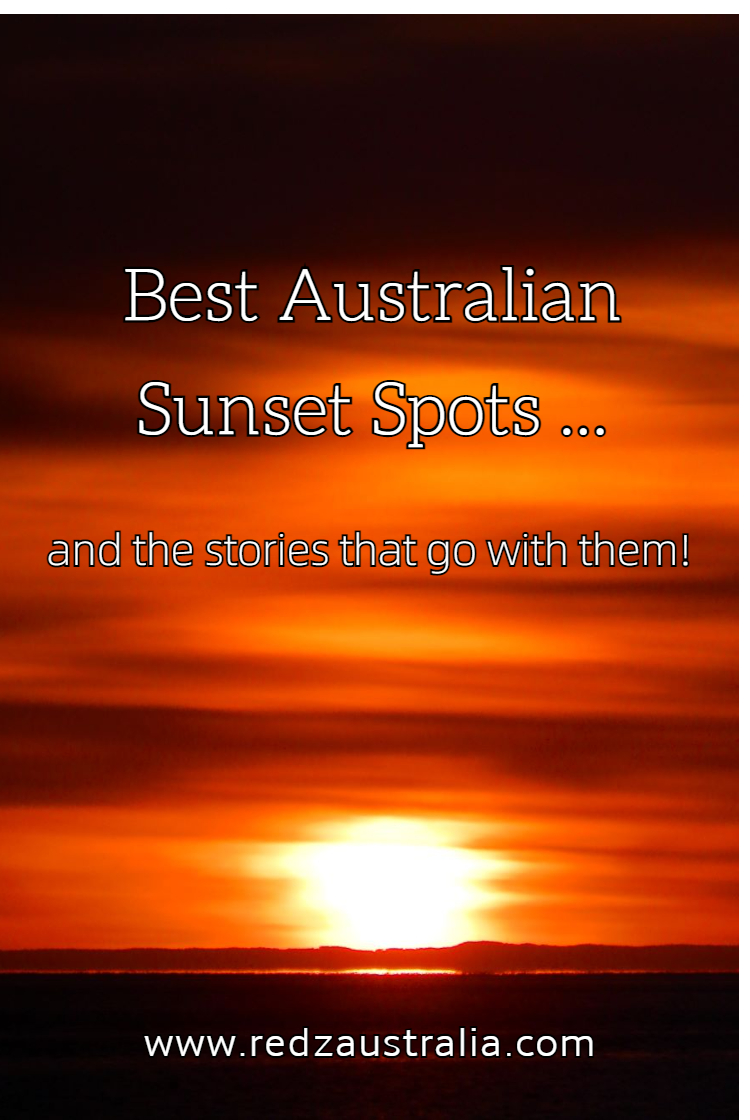The best Australian sunset spots are easy to find. Road-trip almost anywhere downunder, and sooner or later the three main conditions for a great sunset – wide open spaces, big sky and a prop (or two) – will come together. According to me, anyway. Don’t know where to find the best Australian sunset spots? No problem! Over the years I’ve[...]
The post Best Australian Sunset Spots … and the stories that go with them! appeared first on Australia by Red Nomad OZ.
]]>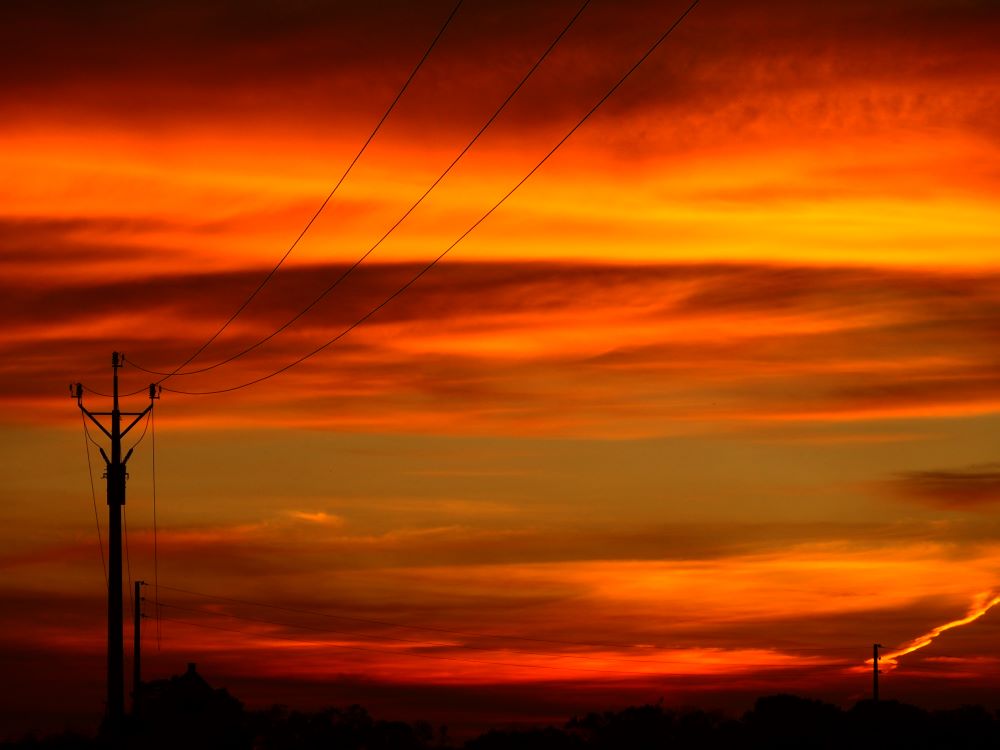
The best Australian sunset spots are easy to find. Road-trip almost anywhere downunder, and sooner or later the three main conditions for a great sunset – wide open spaces, big sky and a prop (or two) – will come together. According to me, anyway.
Don’t know where to find the best Australian sunset spots? No problem! Over the years I’ve discovered a lot of staggeringly scenic sunset viewing locations around OZ, so sit back, relax and let me show you my favourites – and therefore the best Australian sunset spots – complete with links to stories about each of the destinations for your reading pleasure.
You’re welcome! Enjoy!!
1. Hopetoun, Victoria

After a long day on the road a few years ago, we stopped at Hopetoun, a small Murray Mallee town in Western Victoria. It’s not far to Wyperfeld National Park and the extensive Silo Art trail runs right through it. Hopetoun was such a good base for exploring this part of the Mallee we ended up staying a few extra nights.
In the evening, retreat to Lake Lascelles on the edge of town. The excellent campground with powered sites and free camping is a great place to relax as the sun sinks down behind the lake.
Discover more of the magic of Hopetoun and the Murray Mallee HERE!
2. Ballina, New South Wales
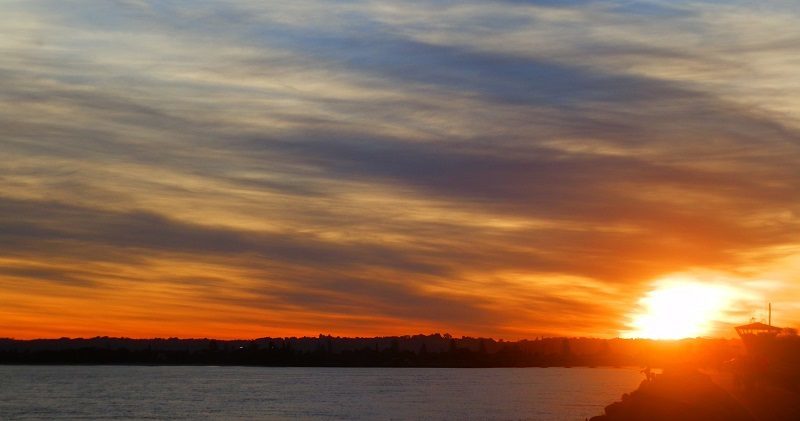
The Northern Rivers Region of north New South Wales is a treasure trove of sub-tropical rainforest, beautiful beaches, amazing coastal scenery, hinterland towns, whale watching and a totally relaxed vibe. Most visitors head for Byron Bay, Australia’s easternmost point, but Ballina, just a few kilometres south, is equally scenic but far less touristy.
Yes, it’s on the east coast so the sun doesn’t set over the sea – but the massive breakwall at the mouth of the Richmond River was almost purpose built to watch the sun sink over the town and (almost) into the water.
I’ve spent a lot of time in Ballina over the years – read about some of my early adventures in the Northern Rivers Region HERE!
3. Lake Moogerah, Scenic Rim Region, Queensland
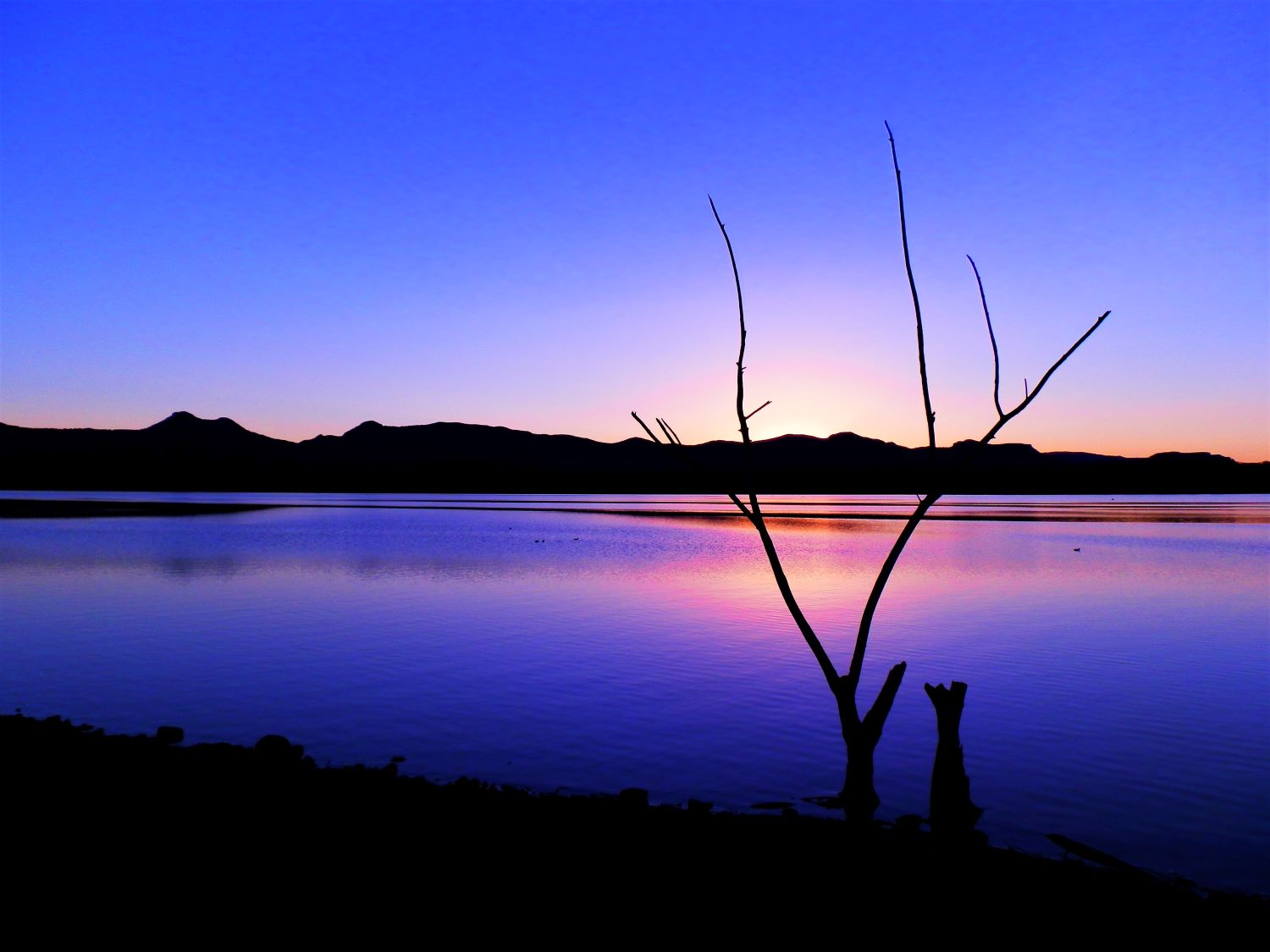
South-eastern Queensland’s Scenic Rim Region is an extensive network of spectacular rocky peaks and mountain ranges formed by long-ago volcanic activity. Several national parks showcase the area’s best features, and its small towns provide a focus for regional produce.
Nestled amidst this wonderland of natural attractions is the man-made Lake Moogerah. As well as being fun to explore and an excellent base from which to discover the region, the lake is a sensational sunset (and sunrise) viewing spot.
It’s easy to spend a week or more in the Scenic Rim – find out how to do that HERE!
4. Yorke Peninsula, South Australia
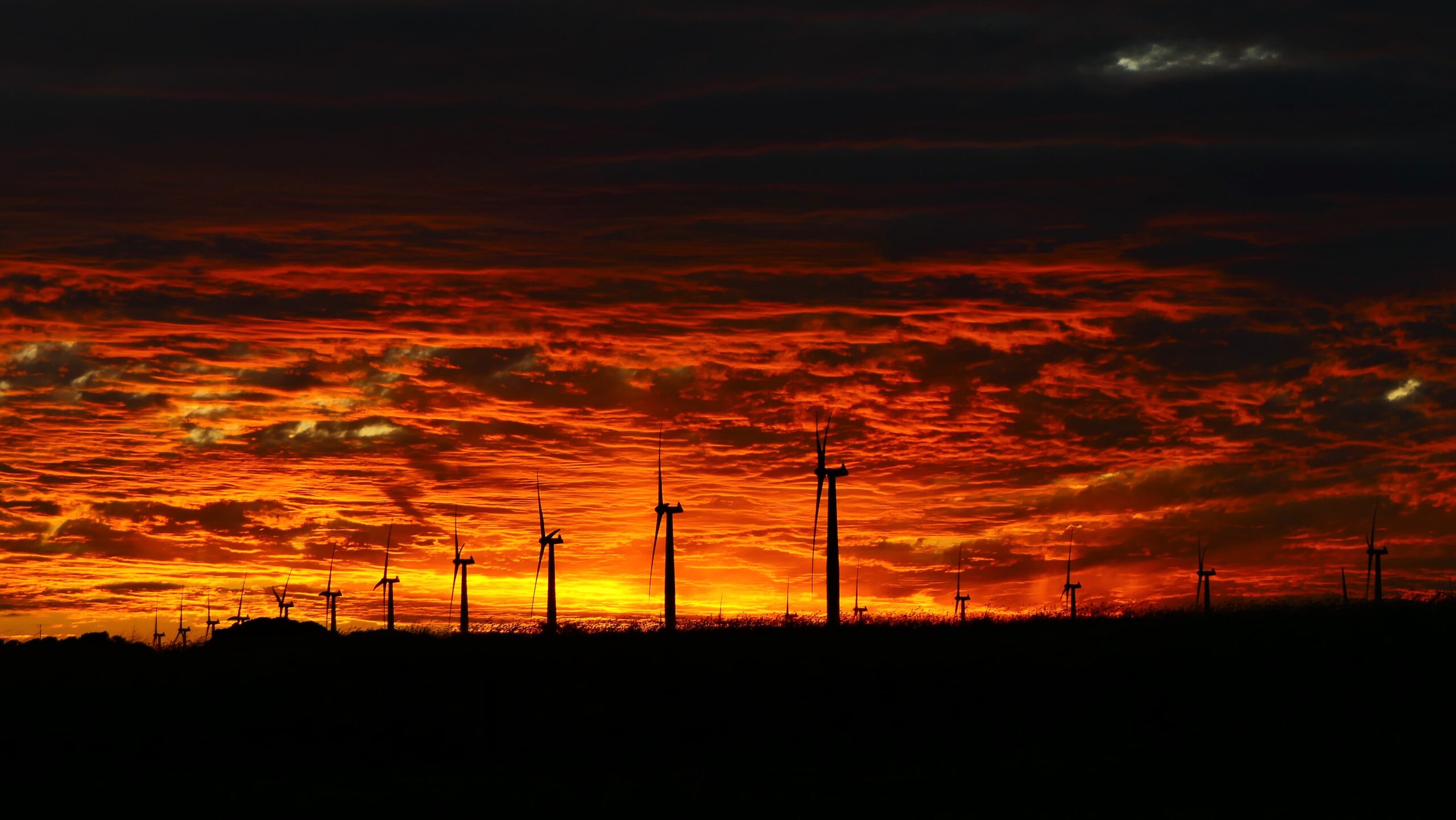
The 700 km (434 mile) long coastline of South Australia’s Yorke Peninsula is full of magnificent swimming and surfing beaches, rocky cliffs, clear blue waters, white sand and lighthouses. There’s a reason it’s known as the Shipwreck coast! The numerous scenic public loos are painted with murals that showcase the region’s attractions and history.
The coast is dotted with many sunset viewing spots, but my personal favourite includes the stunning silhouettes of the Wattle Point wind farm wind turbines!
For more of the attractions and scenery that give the Southern Yorke Peninsula its magic, go HERE!
5. Five Rivers Lookout, Wyndham, Western Australia
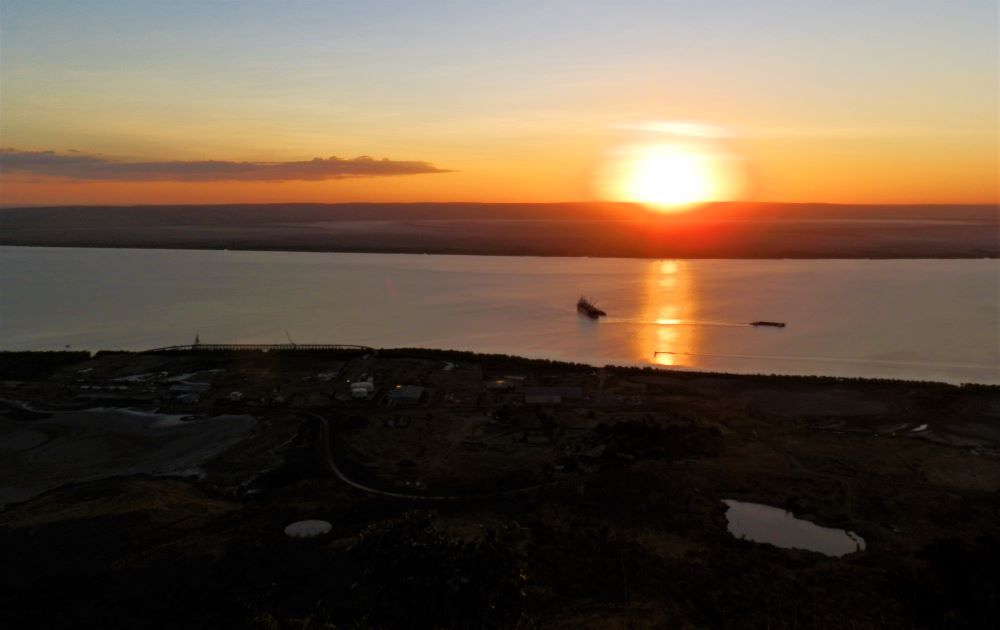
Western Australia’s Kimberley region is full of rocky mountain ranges, wide open spaces and massive tidal rivers. The small town of Wyndham has all these features in abundance, and from its most well-known attraction, five rivers (and two scenic loos!) can be seen. Yes, really!
It’s not easy to get all five rivers in one photo, as the vista is too broad for all but the widest of wide angle lenses. But the view at sunset makes the lookout a worthy addition to the best Australian sunset spots.
The town of Wyndham isn’t just about the lookout, however – read all about its other attractions HERE!
6. Thargomindah, Outback Queensland

Remote Thargomindah has the distinction of being the third town in the world (after London and Paris) to have hydroelectric street lighting. While this fact is celebrated with a three-flag display, there’s virtually no other resemblance to Thargo’s sister cities.
With wall to wall outback scenery on offer, Thargomindah provides a full-on genuine Outback experience. That includes taking in a sunset at the artesian bore, although there are plenty of other wide open spaces and big skies if a steamy sunset isn’t your thing.
It’s been awhile since I visited Thargomindah, but you can read all about it in the guest post I wrote for Rocky Travel HERE!
7. Hay Plain, Deniliquin, New South Wales
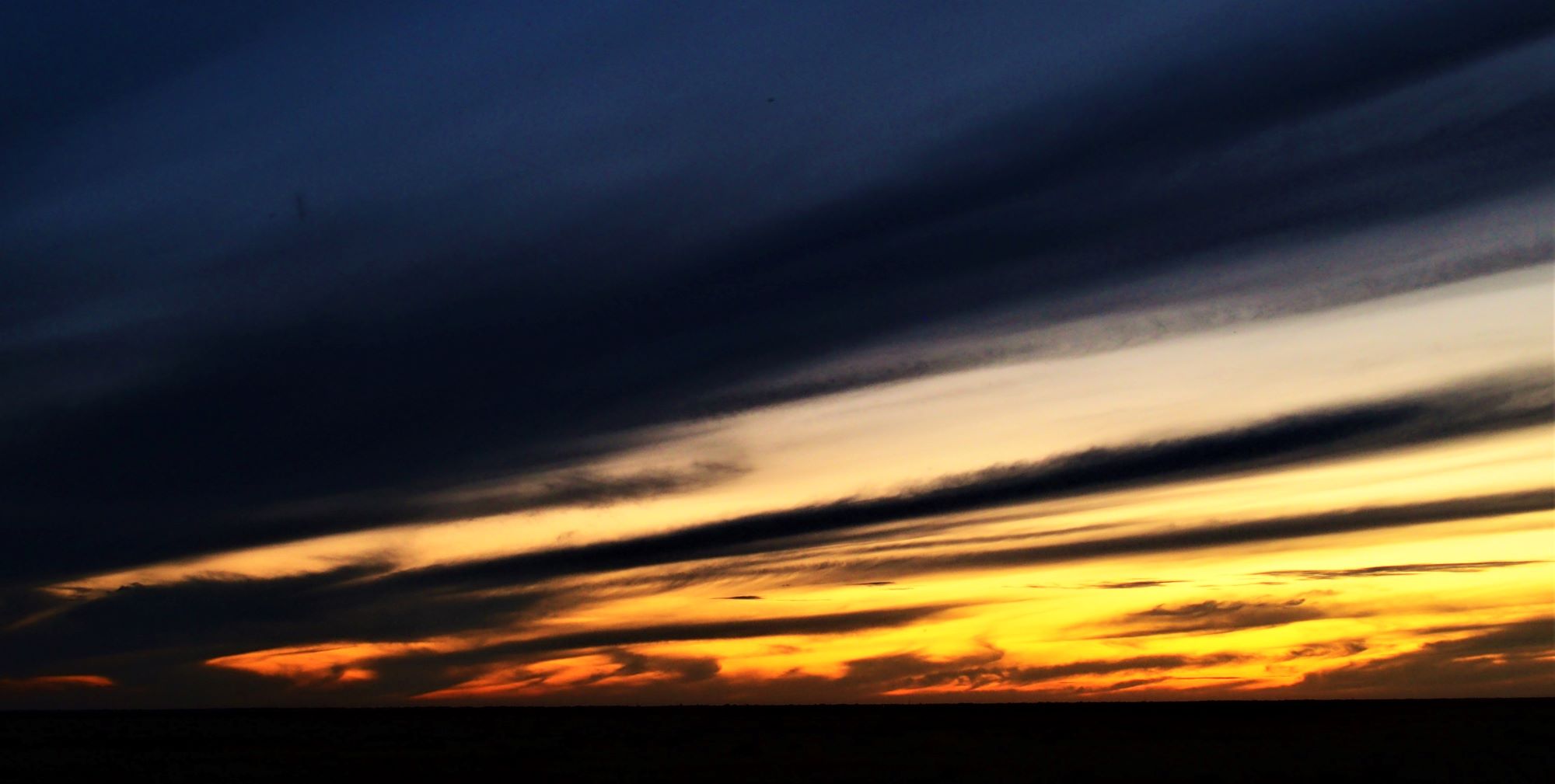
A massive plain the size of Denmark isn’t necessarily the easiest place to spot a rare bird the size of a quail, but that’s exactly what I was looking for on the Hay plain near Deniliquin in central New South Wales. Luckily, the town of Deniliquin is on the banks of the Edward River, and near the Murray Valley National Park. These provide some alternative attractions for those who are unsuccessful in (or don’t care about) locating the birds.
Spotting a killer sunset is a cinch with a plain and sky this big – it’s even better with a bit of cloud or a tree to set off the amazing colours.
Find out whether my rare bird hunt in Deniliquin was successful HERE!
8. Victoria River, via Timber Creek, Northern Territory
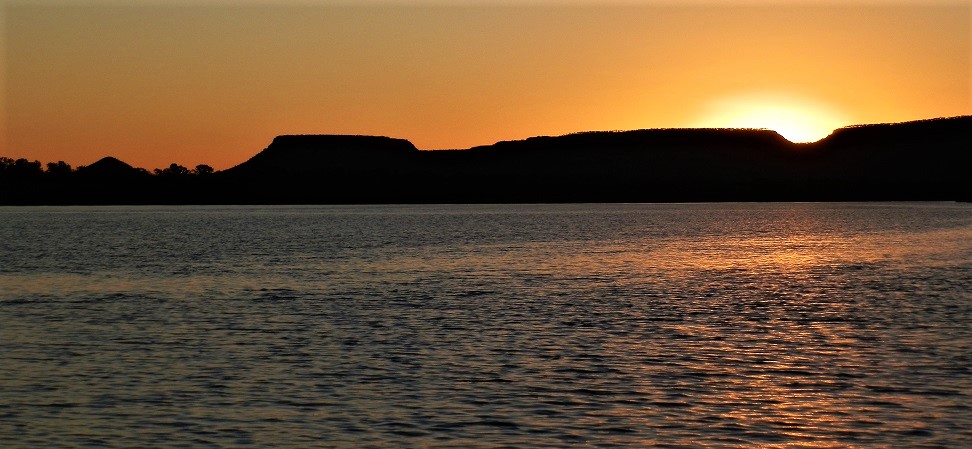
Known as Australia’s wildest river, the Victoria River near the small town of Timber Creek is chock-a-block full of crocodiles. Take a 70 km (43 mile) round trip by purpose-built boat down the river to see more crocodiles per kilometre than any other croc-spotting tour in OZ!
The trip also includes a bus tour introducing features of the township and surrounds en route to the boat. It’s easy to spend an extra couple of days exploring the region to discover some of the elements of its intriguing history for yourself. The sunsets are spectacular from the high lookout point above the town, but even more so from river level as the sun sinks behind the Yarrambin ranges. With luck, it’ll be closely followed by a moonrise!
Read more about my adventure cruising with crocodiles on the Victoria River from Timber Creek HERE!
9. Lake Cullulleraine, Victoria
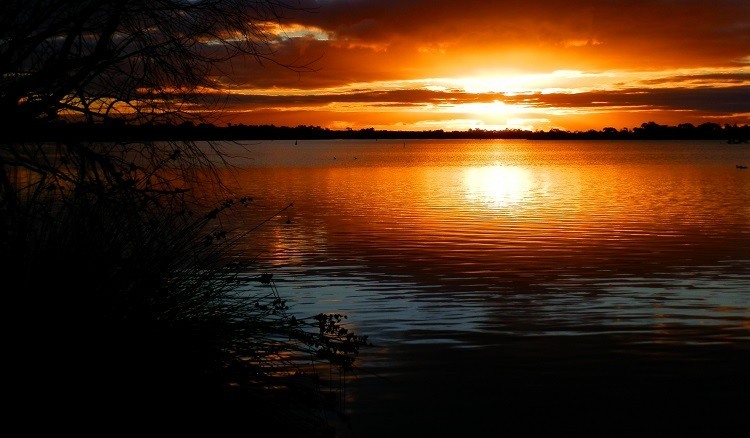
When we stopped at the tiny settlement on the shores of Lake Cullulleraine about 58 km (36 miles) west of Mildura, we were just looking for a place to set up camp for the night. What we found was a place so relaxing, we used it as a base to explore the area around the city of Mildura for a few more days.
When that got to be too much, we hung out at the caravan park, walked around the lake and watched the sunsets. And took photos. Since then, Lake Cullulleraine has been our preferred stopover point when passing through the area.
My first two visits to Lake Cullulleraine, with more about what we discovered to see and do there, can be found HERE and HERE!
10. Broken Hill, New South Wales
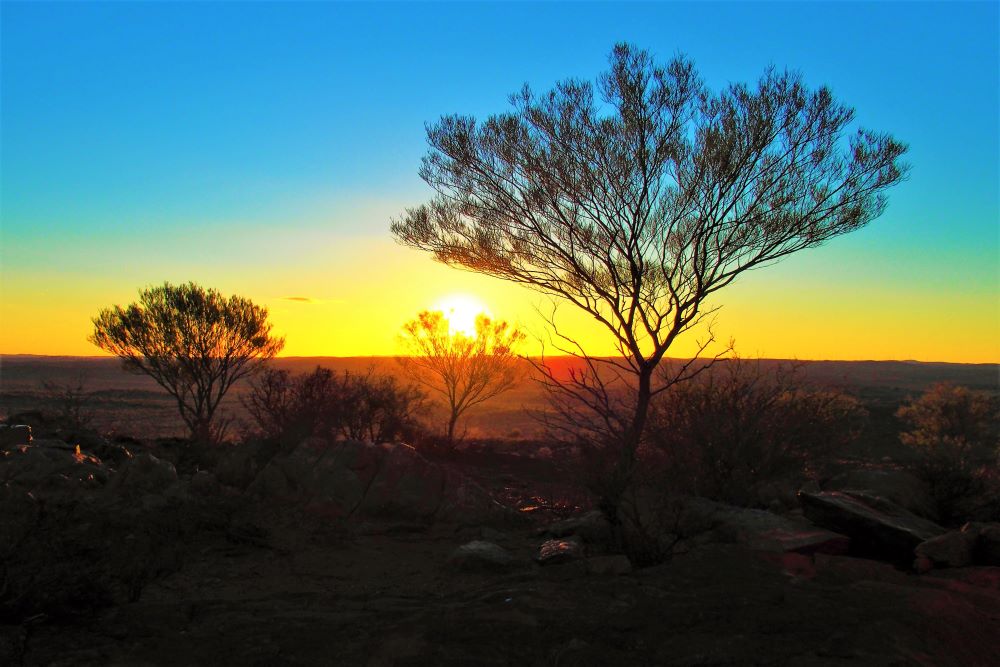
Often referred to as the ‘Accessible Outback’, bitumen roads lead all the way to the mining town of Broken Hill in the middle of a desert in the middle of nowhere. The clear light, intense colours of rock, earth and sky and dramatic shapes and silhouettes have inspired many artists. It’s not hard to see why at dusk when the desert is bathed in a golden glow.
Several museums in town detail the history of the area, and display samples of the minerals found in the area, and the Living Desert reserve just out of town showcases the desert landscape. The Living Desert Sculpture Park is also the best place for sunset viewing, and the prime locations are staked out well in advance.
Find my story about my trip to Tibooburra and Cameron Corner via Broken Hill HERE!
11. Lord Howe Island, New South Wales
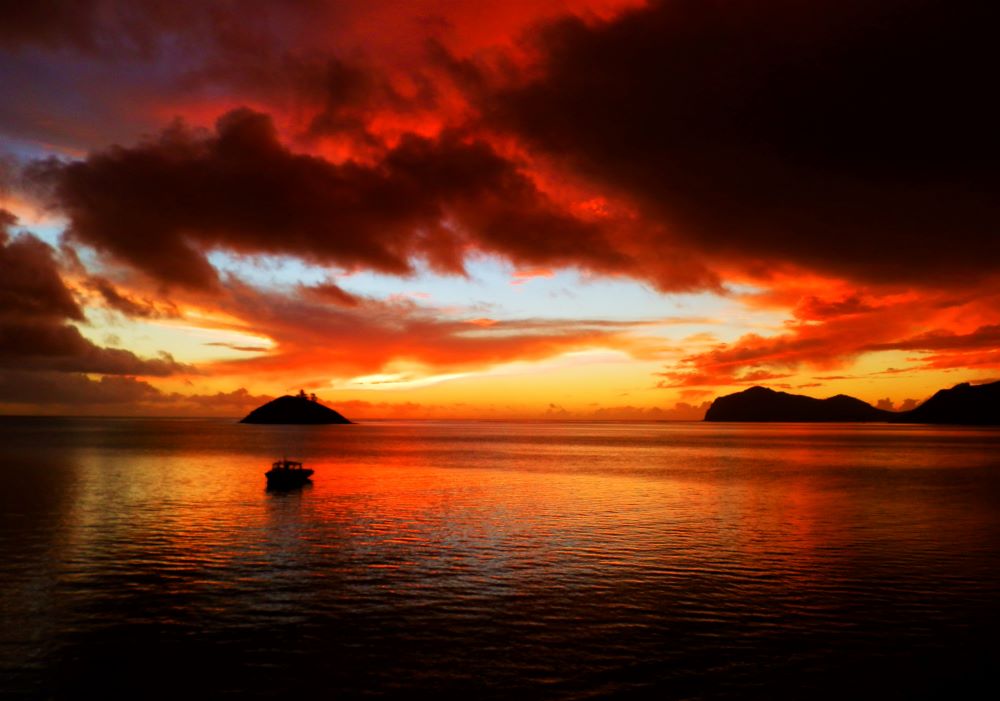
OK, at 700 km (~420 miles) north-east of Sydney, Lord Howe Island isn’t exactly a road-trip destination. This tiny, eco-friendly island is a sub-tropical paradise full of amazing natural attractions, unique wildlife, staggering scenery and world exclusives. It’s an action-adventure kind of holiday destination, where hiking, snorkelling, walking, kayaking, boating, fishing, and diving are key activities.
At the end of the day, when everything slows right down to island time, a killer sunset is almost impossible to avoid. That’s why it deserves a place on any list of the best Australian sunset spots!
It’s easy to spend a week on Lord Howe Island – find out how HERE!
12. Bruny Island, Tasmania
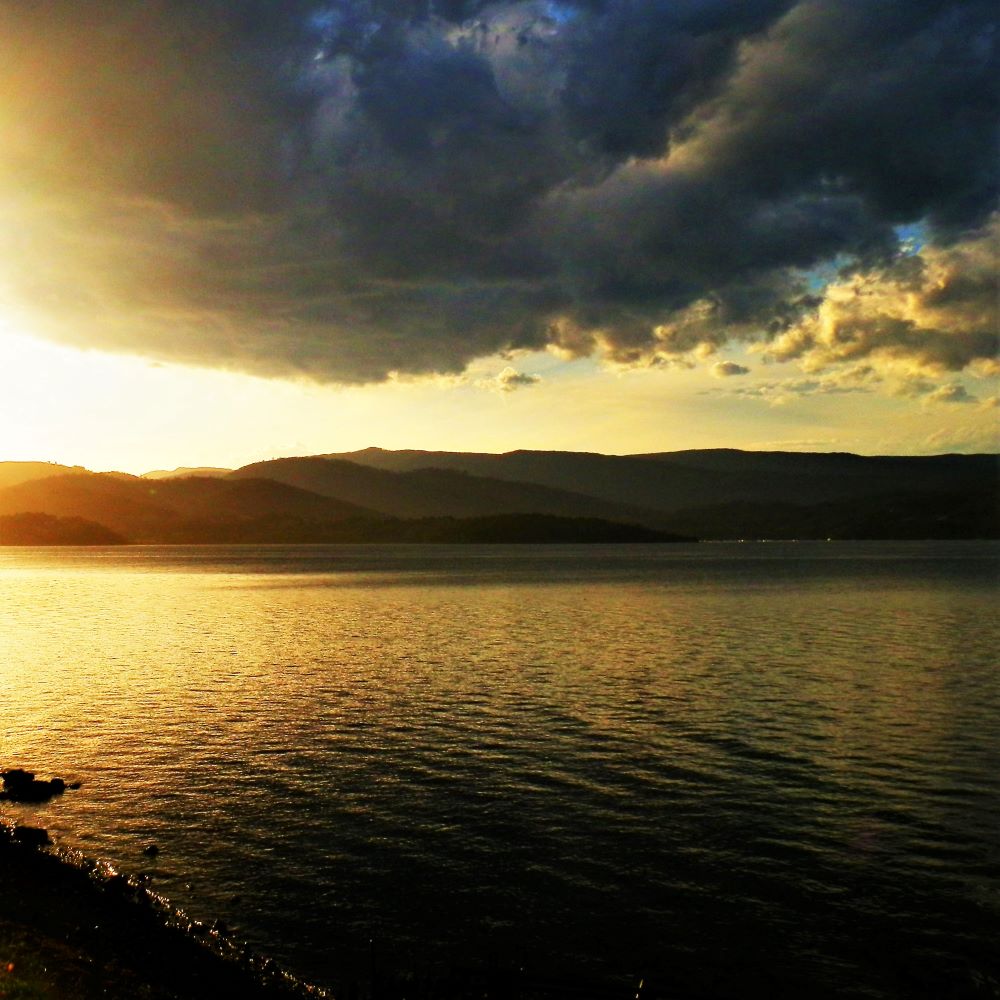
OK, ok – so this isn’t actually a full-blown sunset. But do yourself a favour anyway, and take the short drive south from Hobart to Kettering and catch the ferry to Bruny Island. There’s nothing much between this unspoiled little gem and Antarctica, so expect wild and rugged terrain, magnificent scenery and an amazing selection of wildlife.
Take a cruise past the second-highest sea-cliffs in the southern hemisphere and through towering rock stacks while dolphin-spotting, bird-watching and getting up close to a grunting mass of Australian Fur Seals for an unforgettable experience. Then chill out down by the wharf while awaiting the ferry back to the Tasmanian mainland and watch the sunset over the D’Entrecasteaux channel. If the ferry doesn’t turn up early, that is!
My Bruny Island cruise adventure was one of my all-time favourite Aussie tours ever! Go HERE to find out why!
13. Cadney Park Homestead, South Australia
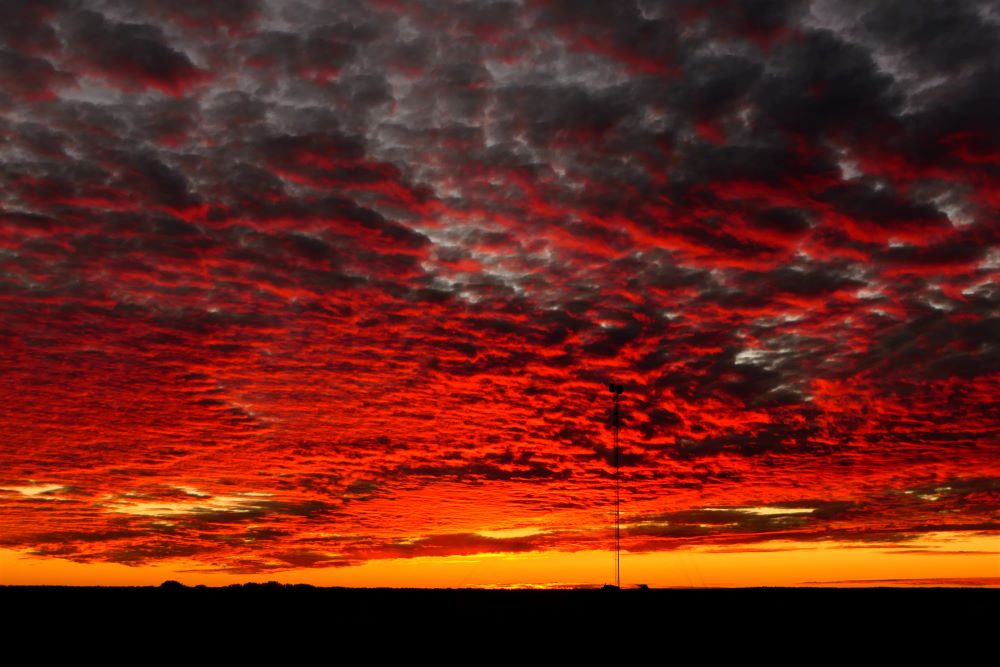
Most road-trippers don’t see Cadney Park Homestead, a roadhouse about 153 km (95 miles) north of Coober Pedy on the Stuart Highway, as a destination in its own right. But as gateway to the spectacular Painted Desert, deep in the South Australian Outback, it’s worth staying for a couple of nights.
There’s the added bonus of a superb sunset, especially when the cloud rolls in.
Read more about my Cadney Park stopover and trip to the Painted Desert HERE!
14. Broome, Western Australia
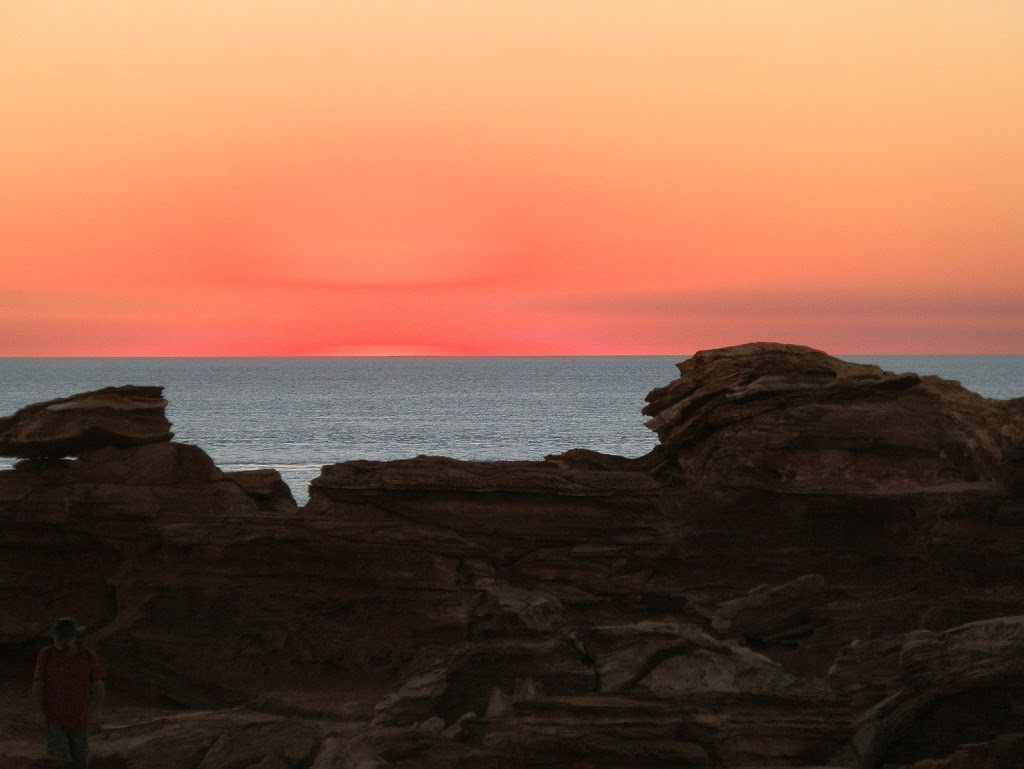
In Australia’s far northwest, the town of Broome has a unique history and culture based around pearling. Its easy to spend a week or two – or even longer – exploring its distinctive natural attractions. But it’s standing room only during the Australian winter when visitors from the south flock north in search of warmth.
The intense colours of the sea, sky and red Pindan soil that characterise Broome’s landscape fade into insignificance at sunset when the sky fills with astonishing colour. The sky show is best viewed from Gantheaume point where the sun sets over the sea.
Find out why Broome is so popular during the Australian winter months HERE!
15. Derby, Western Australia
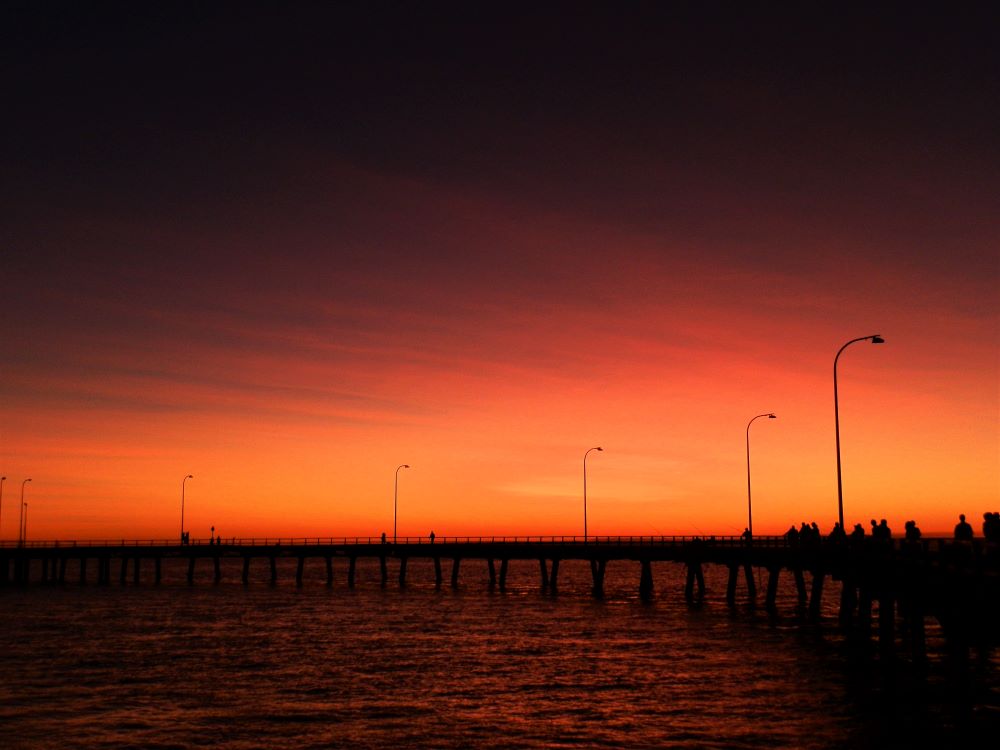
Derby Jetty is the best place to watch the phenomenon of the highest tidal range in Australia – up to 12 metres difference between high and low tides. At low tide, the jetty is well out of the water and the mud flats below are exposed. At high tide the water almost laps at the top of the jetty. Any time of tide can be a good time for crocodile spotting.
The jetty is also one of the best Australian sunset spots around as the sun sinks below the waters of King Sound and the sky and water lights up.
Read more about Derby’s massive tides HERE!
16. Farina Station, Outback South Australia
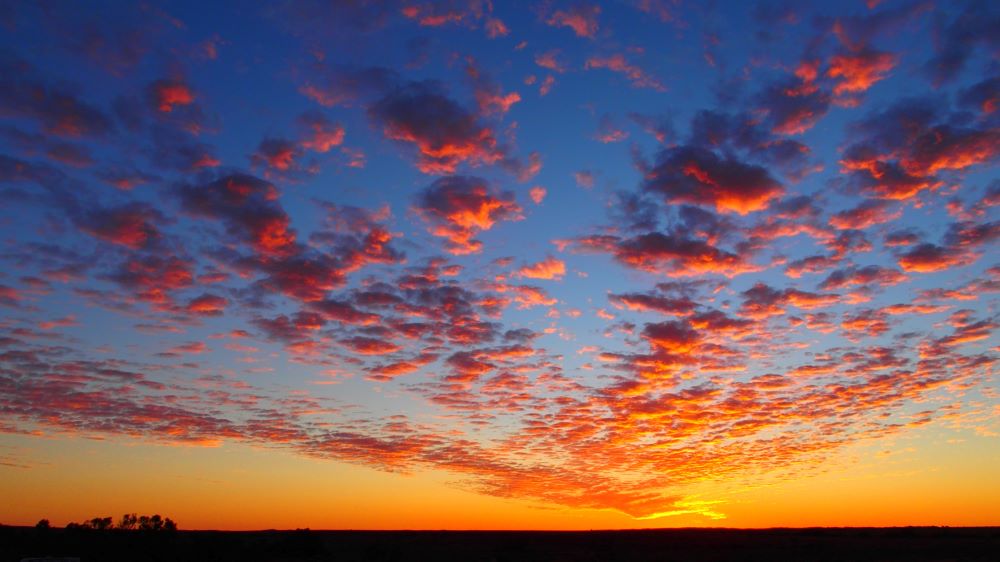
Farina was once a town set up to support a large wheat growing region, but relentless drought and a non-permanent water supply caused the venture to fail. That’s what happens in the middle of the driest state of the driest continent on earth.
Nowadays, the abandoned township is on Farina Station, and is slowly being restored. The repairs are funded by the old Farina bakery, operated by volunteers for several months during the Australian winter. That alone is a good enough reason to visit, but the sunsets from Anzac Hill above the campground make it doubly worthwhile.
I first discovered the Farina Bakery a few years ago now, but I’ve been there several times since. Read about my first visit HERE!
17. Karlu Karlu/Devils Marbles, Northern Territory
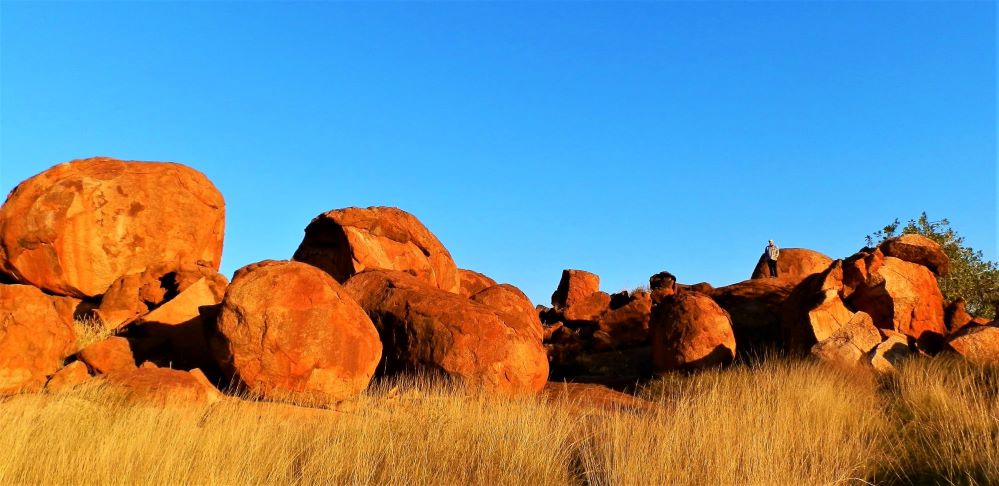
From the Stuart Highway, about 412 km (256 miles) north of Alice Springs, the Devils Marbles are an unmistakable tumble of various-sized rocks scattered over the surrounding plain. The Indigenous name – Karlu Karlu – translates as ’round boulders’, and the rocks feature in local Indigenous lore.
At sunset, the marbles glow in the evening light, when the colours become even more impressive.
Exploring the Devils Marbles is a fun part of touring Central Australia. Take a look at some of the region’s other attractions HERE!
18. Sydney, New South Wales

Finding the next super Aussie sunset isn’t limited to road-tripping the more remote areas of the Outback. There’s always an opportunity waiting, as I found when flying into Sydney at sunset with the atmosphere full of bushfire smoke, creating an almost post-apocalyptic panorama.
Of course this shot was just good luck for me, but I wouldn’t have got it at all if my camera wasn’t easily accessible. Finding a good sunset shot is also possible on the ground in Sydney – and there are lots of other good reasons to visit.
Find out how I made the most of a Sydney layover with four hours between flights HERE!
19. Sanctuary Lakes, Melbourne, Victoria
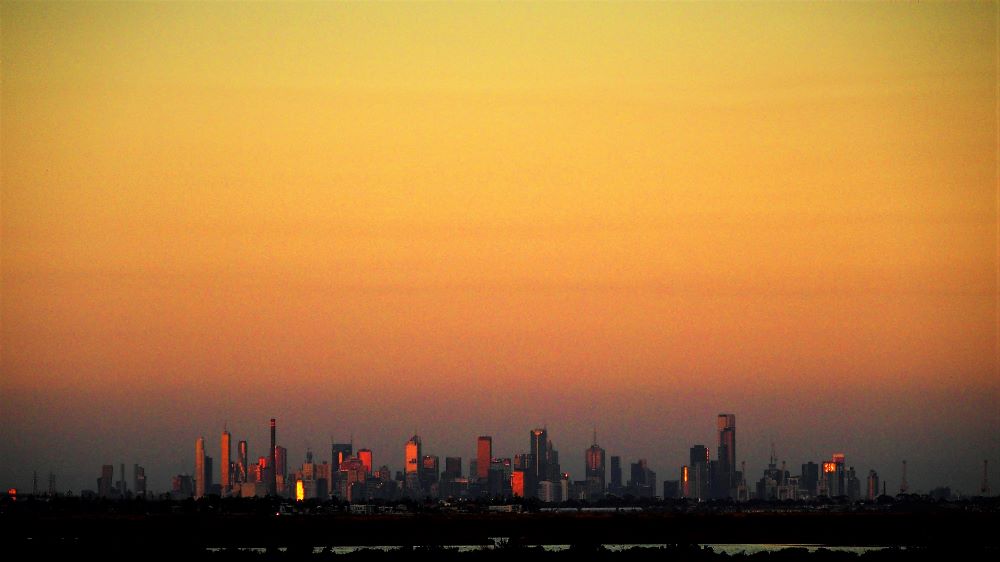
While I don’t spend a lot of time hanging out in big cities, I can still appreciate the photographic opportunities they bring. While staying in Melbourne’s west, I was lucky enough to be at the wetlands near Sanctuary Lakes in the late afternoon, with an uninhibited view of the Melbourne skyline, lit up by the setting sun behind me.
Visiting a large city doesn’t necessarily have to mean exploring attractions in the CBD or even suburbia! I got to explore a completely different side of Melbourne where I’m betting not many others have been. Where? Go HERE to find out!
20. Darwin, Northern Territory
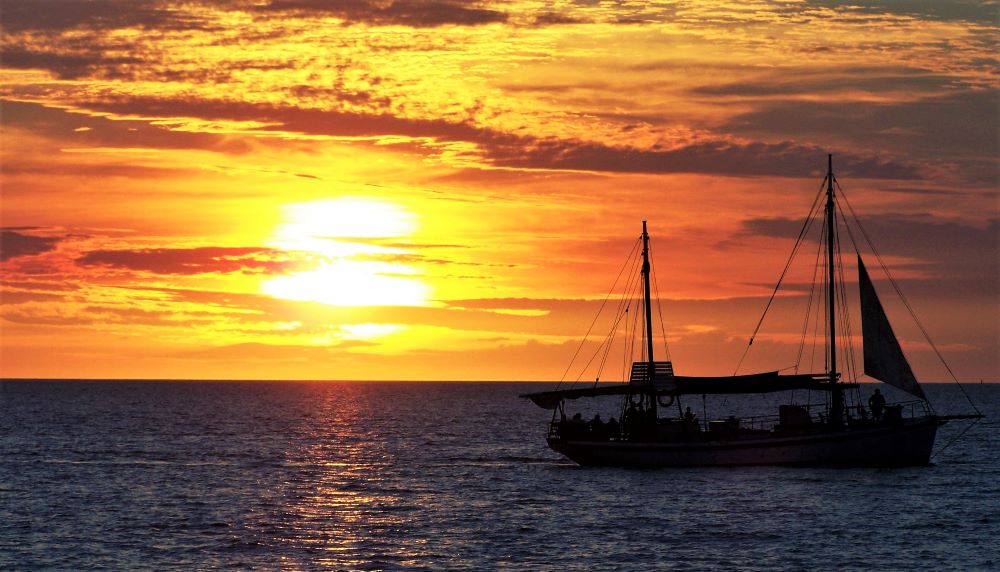
Australia’s northernmost capital city, Darwin, enjoys a laid back lifestyle that keeps visitors coming back for more. Bombed in World War II and devastated by a cyclone in 1974, the city has many natural and historical attractions to explore.
The popular Mindil Beach markets are a great place to purchase a picnic from the many stalls and watch the sun sinking into the Timor Sea.
Other Darwin attractions can be found HERE!
Everywhere I go on my Aussie travels is another opportunity to find a great sunset spot. So keep watching – I’ll be adding more as I find them!
Want MORE?
There are even more of the best Australian sunset spots I’ve discovered in my travels right HERE on Flickr!
Pin it!
Make sure this list of best Australian sunset spots is easy to find again!
The post Best Australian Sunset Spots … and the stories that go with them! appeared first on Australia by Red Nomad OZ.
]]>Long Coastline, HUGE Landmass, Low Population. Our amazing unspoiled coastline, stunning natural attractions give us a fantastic array of AMAZING Australian coastal and beach holiday destinations! So how do you choose one? I’ve made it easy with my two-part virtual tour – so sit back, slip on your sunnies*, sip something soothing, and get set for a stunning scenic All-Around-Australia tour[...]
The post 12 HOT Australian Coastal and Beach Holiday Destinations – Part 1 appeared first on Australia by Red Nomad OZ.
]]>
Long Coastline, HUGE Landmass, Low Population.
Our amazing unspoiled coastline, stunning natural attractions give us a fantastic array of AMAZING Australian coastal and beach holiday destinations!
So how do you choose one?

I’ve made it easy with my two-part virtual tour – so sit back, slip on your sunnies*, sip something soothing, and get set for a stunning scenic All-Around-Australia tour of 12 coastal destinations to inspire YOUR next holiday! And look out for Part Two coming SOON!
For more information, click each heading below!
1. Port Fairy, Great Ocean Road, Victoria
Choosing a vacation base along the 400 km (~248 mile) long Great Ocean Road trail starting at the South Australian border and stretching nearly to Melbourne is WAY too hard. It’s got (almost) too many surf beaches, shipwreck sites, holiday towns, hiking tracks, National Parks, cafés and historic points of interest.
But you have to start somewhere. So for a cross-section of what the Great Ocean Road has to offer, base yourself at Port Fairy. It’s a 2-bakery teaser with historic Griffiths Island and lighthouse (photo above). There’s also a Short-tailed Shearwater nesting spot, site of the Bonney Upwelling phenomenon, and a rich maritime heritage with magnificent coastal scenery.
Plus access to a LOT of other attractions at nearby towns Portland and Warrnambool!
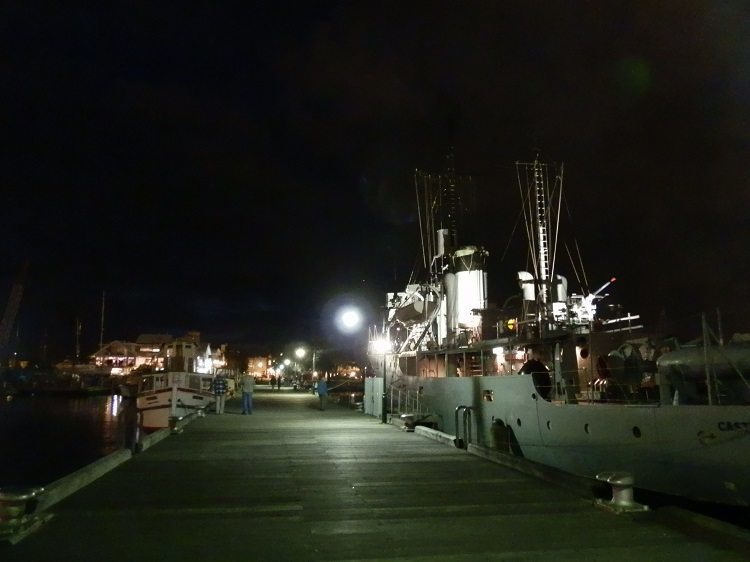
2. Port Philip Bay, Victoria
Bird watchers like me just don’t understand why most visitors to Melbourne don’t want to visit the sewage ponds at the Western Treatment Plant – one of the best birding hotspots in OZ.
Weirdly, many non-birding visitors seem to prefer water sports, sailing, swimming, fishing, cruising and hiking. Not to mention visiting the many National Parks, gardens, lighthouses, historic sites and cultural hot spots. They’d probably agree that Melbourne exists merely as accommodation while they indulge in the amazing variety of water- and beach-based activities in, on and around Port Philip Bay.
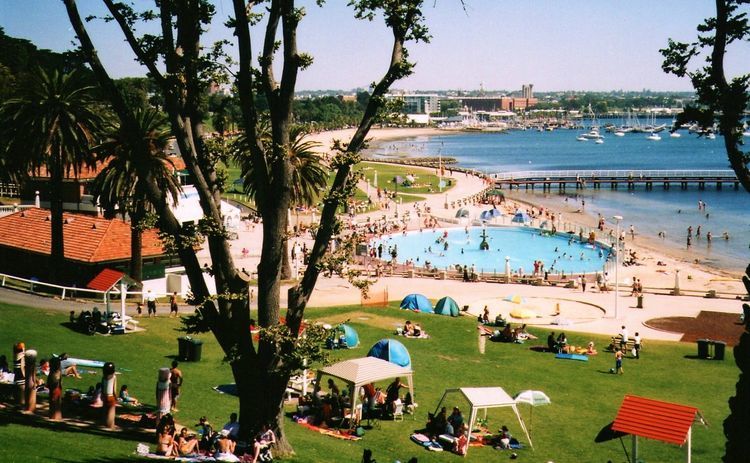
35 times larger than Sydney Harbour and home of Australia’s biggest cargo port, finding enough things to do on your seaside holiday won’t be a problem. If all else fails, just chill out on one of the many beaches and soak up the coastal culture!
3. South West Rocks, New South Wales
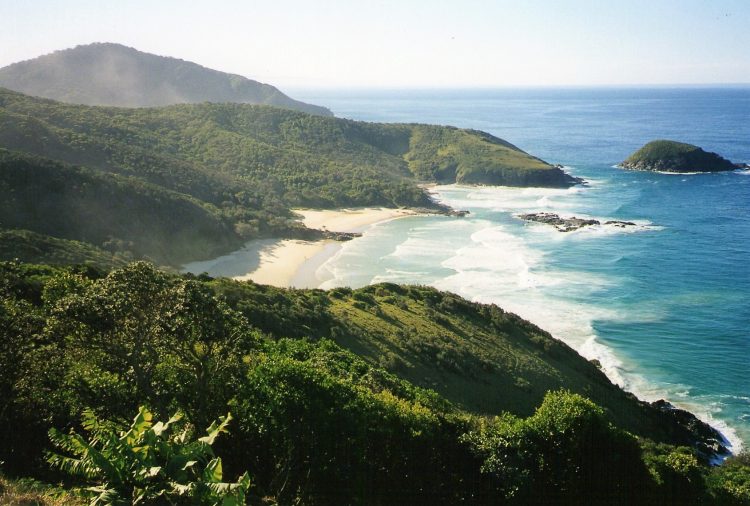
We were horrified to hear that the unspoiled fishing village of South West Rocks we’d ‘discovered’ in the 1990s was a favourite of Ray Martin, one-time Aussie TV ‘personality’. It took a temporary dive in our estimation.
Its array of attractions include Macleay River fishing, the staggering scenery from Smoky Cape Lighthouse, hiking trails, a superb bakery, hinterland and nearby towns to explore. There’s Trial Bay Gaol, and Hat Head, Stuarts Point and Scotts Head (all with GREAT beaches). So it made a speedy recovery and it’s still one of our all-time favourite NSW coastal spots.
We haven’t yet spotted Ray there … but who knows? You might get ‘lucky’!
4. Broken Head, New South Wales
The amazing Northern Rivers region of NSW has (arguably) some of the best beaches and coastal scenery in Australia. The coast also includes the iconic Cape Byron Lighthouse on Australia’s most easterly point.
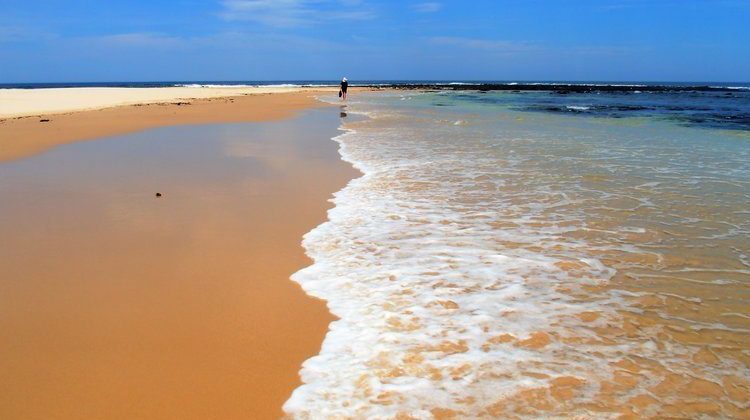
But wilder and less crowded is the little hamlet of Broken Head just a short distance south of Byron Bay with the best of both worlds. It’s an awesome coastal holiday destination in its own right. It’s also easy to access the amazing beaches and other attractions in the whole region.
You might need more reason to visit than the magnificent stretch of rainforest-lined unspoiled beach that curves all the way round to Cape Byron. If so, stop dodging the scrub-turkeys in the car park and dodge the surfers and fishermen instead on the coastal walk south across the Head to the beaches and wilderness beyond. Interpretive signs explain historic and cultural points of interest, and the view goes on forever …

On a good day, it’s pretty hard to beat!
5. Mon Repos, via Bundaberg, Queensland
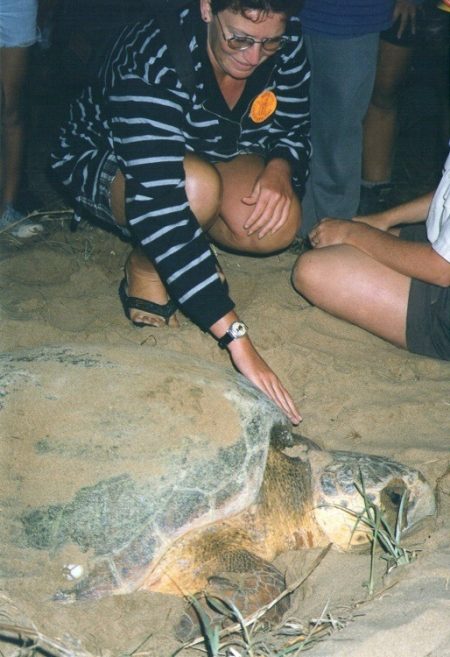
There’s a lot more to do in the coastal town of Bundaberg than see turtles, but nearby Mon Repos Conservation Park is one of the largest turtle rookeries in Australia. That makes it an interesting beach holiday destination.
At night during laying season (Nov to Jan), female turtles lay their eggs on the beach – and a few lucky people, supervised by the interpretive centre, are privileged to watch.
If you’re thinking I look a bit rough in this November 1998 photo, it’s because it’s about 3:00 am – the turtles don’t perform on demand!
This is an extraordinary opportunity to see something amazing – and a must-do for your coastal vacation bucket list!
If turtles aren’t your thing, a tasting trip to the Bundaberg Rum factory – it also makes a killer Ginger Beer and selection of fruit-flavoured soft drinks – might do the trick!
6. Cooktown, Queensland
It’s quite possible that every visitor to Cooktown has a photo of the 1885 Grassy Hill Lighthouse. Not to mention the killer view along the wild and heavily-rainforested coastline.
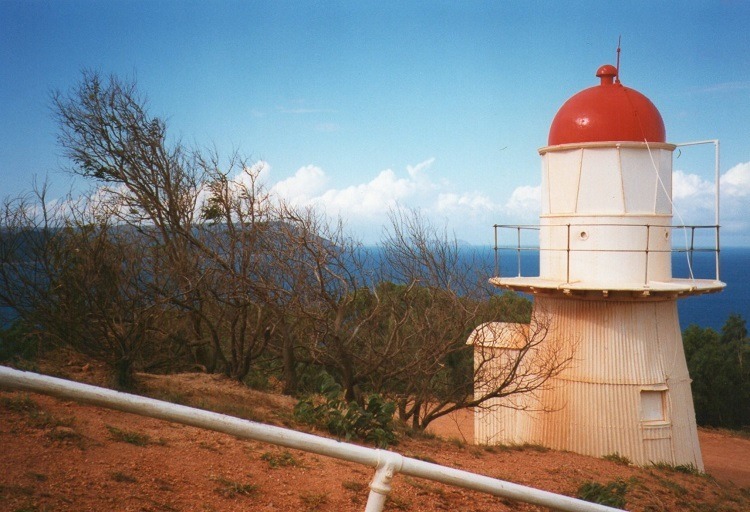
Its colonial history includes a visit of several weeks by Captain Cook (yes, THAT one) while repairing the Endeavour. There was also a busy port that serviced the nearby Palmer River goldfields.
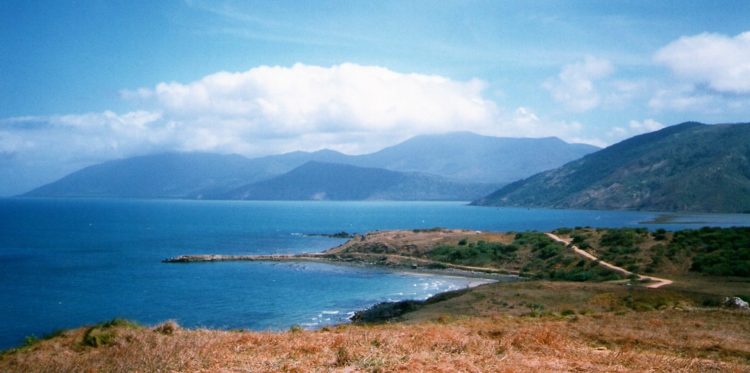
Now a popular winter fishing destination, it’s also a jumping off point for one of the most iconic of Australian road-trips. Yes, you guessed right—the trek to the most northerly point in Australia, Cape York!
7. Darwin, Northern Territory
Australia’s most northerly major city, Darwin isn’t for the fainthearted. The town was virtually destroyed by bombings during the 2nd World War and again by Tropical Cyclone Tracey on Christmas Day, 1974. Regularly lashed by tropical storms and isolated by floods during the annual ‘Wet’ season (Nov-March), its tropical waters contain crocodiles and stingers.

Fair-weather tourists like me who venture this far north during the ‘Dry’ are rewarded with magnificent tropical scenery, milder temperatures and the most laid-back lifestyle in OZ.
If you like your coastal holidays served up with a dash of adventure – think fishing in crocodile-infested waters and or even bird watching in a crocodile infested dam – then head to the beaches of Darwin. But give the swimming a miss!
Across the bay by ferry, holiday town Mandorah is a taste of the tropics at their best.
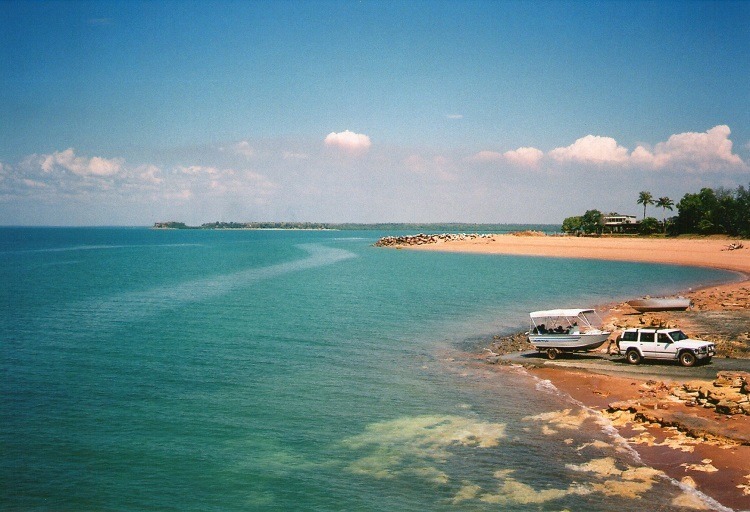
I don’t know if I’ll ever visit Darwin during the Wet. But its a sure thing I’ll be back there one day to experience it’s Aussie Winter 30ºC (86º F) temperatures again!
8. Broome, Western Australia
 Likely the worst photo you’ll ever see of Broome’s famous ‘Staircase to the Moon’, this shot is a wordless warning to anyone attempting low light photography. Don’t forget those pre-requisites: a) tripod; b) shutter release cable; and c) skill!
Likely the worst photo you’ll ever see of Broome’s famous ‘Staircase to the Moon’, this shot is a wordless warning to anyone attempting low light photography. Don’t forget those pre-requisites: a) tripod; b) shutter release cable; and c) skill!
Sceptical of its ‘uniqueness’ – it’s just the moon rising over water and mud for goodness sake, and that happens in LOTS of places – seeing the real thing’s actual resemblance to a staircase (don’t look for this in my poor pic) changed my mind.
Luckily, there’s plenty more to do in the coastal pearling town of Broome if moonlight and mudflats don’t quite do it for you.
Broome has some of the most amazing coastal scenery – and highest tides – in Australia. It’s colours are a perfect backdrop to exploring the rugged coastline and amazing beaches like world-famous Cable Beach, and other gems like often-almost-deserted Coconut Wells beach.There’s also the swirling tidal patterns of Willie Creek – also home to a pearl farm!
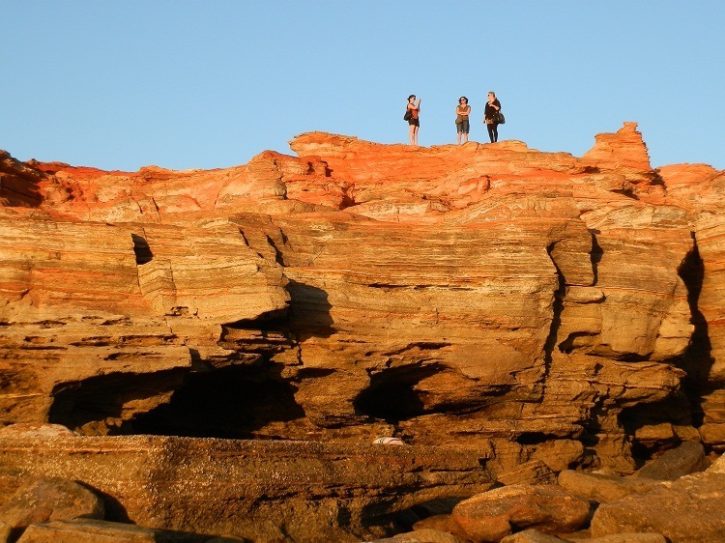
An interesting array of cultures makes the regular outdoor markets on ‘Staircase’ nights a must-do. As is exploring dinosaur footprints and the lighthouse at nearby Gantheaume Point. Broome is best enjoyed as a beach holiday destination during the milder Aussie winter (June-August).
9. Quobba Blowholes, Western Australia

Never turn your back on an active blowhole – if you want to stay dry, that is!! By a happy coincidence, the tides were perfect for optimum blowhole performance, and some dodging and weaving around the rocks ensured we didn’t get too wet. Not that it would have mattered – the perfection of a fine, warm and sunny winter’s day on Western Australia’s Outback Coast means we would have dried out pretty quickly!
But high-pressure sea spray bursting through rockholes isn’t the only kind of blowhole on offer below the impressive Quobba lighthouse and beautiful bay – whales are also sighted along this stretch of coastline.
For a different perspective, try blowhole-spotting from the vantage point high above at the lighthouse. It’s easier than it looks as the white spray stands out perfectly against the deep, deep blue of the sea!
There’s a campground near the blowholes, but there’s also plenty of things to do at nearby Carnarvon – a coastal town known for its produce, and a well known winter holiday destination for those escaping the southern cold.
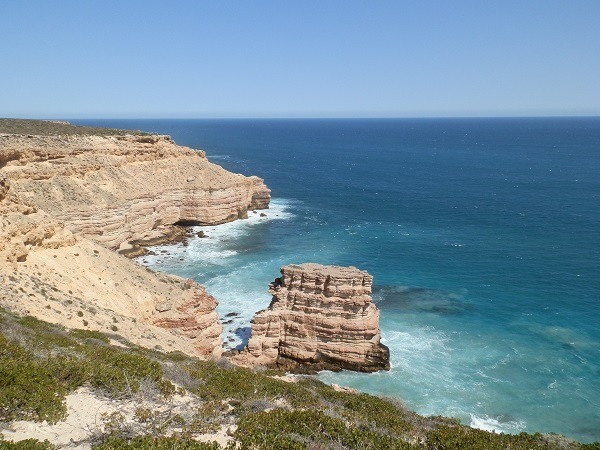
10. Kalbarri, Western Australia
With one of the most distinctive coastlines in OZ, the layered sandstone of Kalbarri’s 100 metre high cliffs can sometimes overshadow its other main attraction – the 500+ wildflower species for which the area is renowned!
But a series of cliff top walks atop sheer drops right down into the wild and whale-ridden waters of the Indian Ocean make the high concentration of shipwrecks – such as the Batavia in 1629 – unsurprising.
If you can tear yourself away from the cliffs, the impressive Murchison River, after carving its way through the sandstone from 80 km inland, enters the sea at Kalbarri in the shadow of the magnificent Red Bluff. The Kalbarri National Park – full of birds, wildlife and wildflowers – surrounds the town. Just up the road is the World Heritage area of Shark Bay, another beach holiday destination.

But who needs other attractions when all roads lead to the stupendous cliffs?!
11. Head of Bight, South Australia
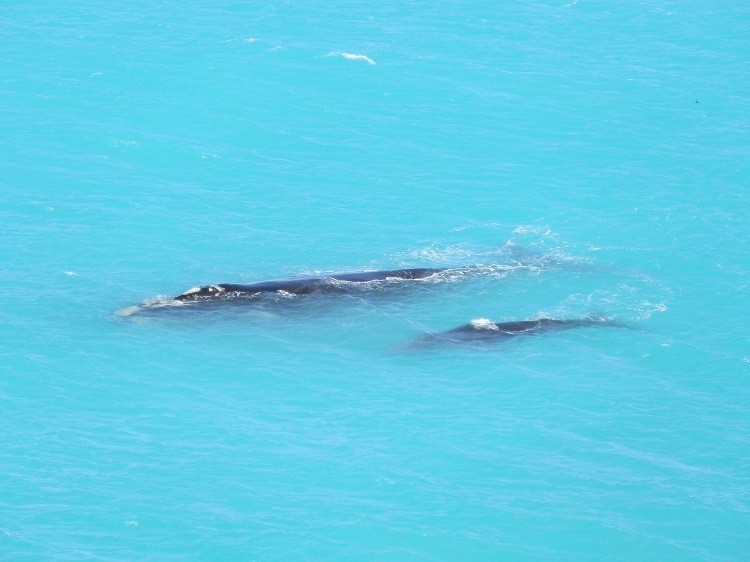
Its pretty hard to just drop in to Head of Bight – at the very top of the Great Australian Bight stretching across much of southern Australia’s coastline.
It’s at least a couple of days drive along the Eyre Highway from the closest major town in any direction.
But if you’re driving Australia’s best known road trip across the Nullarbor from June to October, you’ll find a southern right whale nursery under the unbroken 200 km line of the fabulous Bunda cliffs that mark where the world’s largest karst limestone formation meets the Great Southern Ocean. It’s also the longest continuous line of sea cliffs in the world.
But the whales are the main attraction, and they’re easily seen from the viewing platform below the cliffs. They’ll make spending your vacation on that long drive across the middle of nowhere worthwhile!
12. Yorke Peninsula, South Australia
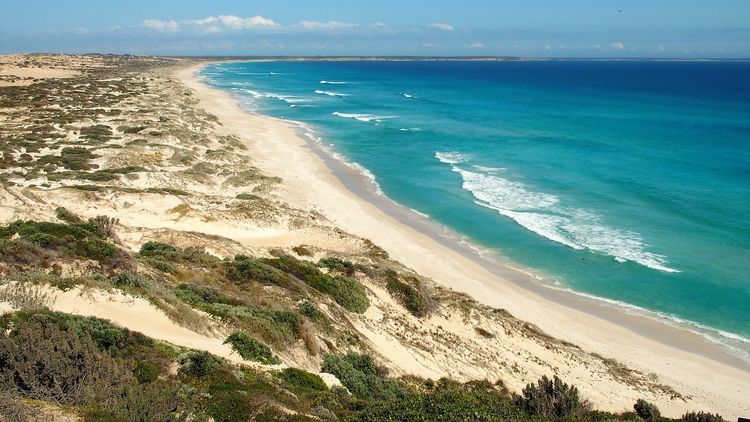
The long coastline around the Yorke Peninsula, a narrow neck of land a couple of hours from Adelaide, virtually guarantees one of the highest concentrations of amazing beaches (often deserted), spectacular natural attractions AND coastal Scenic Public Toilets in Australia!
The perfect beach holiday destination, it’s also got some great hiking trails, including ‘Walk the Yorke’ around the whole peninsula. There are also lighthouses, shipwreck sites and great scenic drives along the rugged coast. Then there’s the dolphin and seal spotting. AND the fishing …
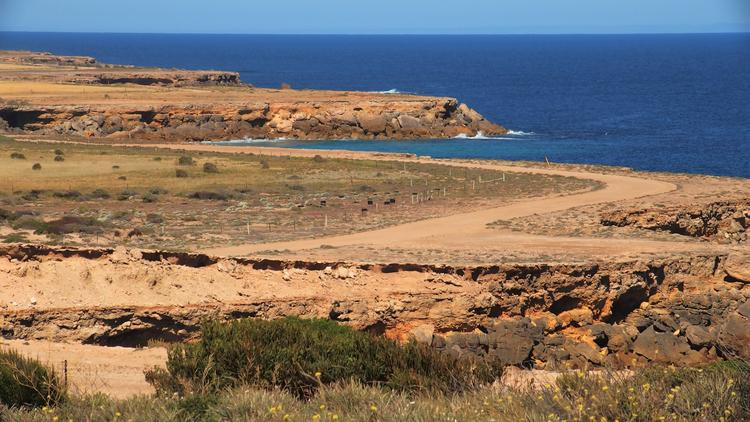
Well, that’s Part One done! Stay tuned for Part Two with another 12 of Australia’s best coastal and beach holiday destinations – and another virtual tour of the whole coastline!
The post 12 HOT Australian Coastal and Beach Holiday Destinations – Part 1 appeared first on Australia by Red Nomad OZ.
]]>I’m SO not a hard-core hiker for lots of reasons. Wrong temperament. Wrong size. Wrong fitness level. And my holidays are NEVER just about the hike. Or hikes. But although I’m the world’s slowest hiker, I like my holidays served up with a bit of hiking on the side. So my holiday destinations have to give me a hiking workout[...]
The post 10 TOP Half Day Hikes in 10 HOT Australian Holiday Spots appeared first on Australia by Red Nomad OZ.
]]>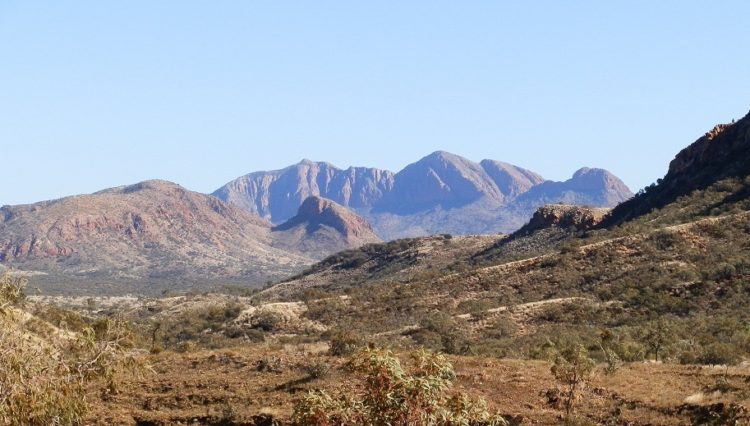
I’m SO not a hard-core hiker for lots of reasons. Wrong temperament. Wrong size. Wrong fitness level. And my holidays are NEVER just about the hike. Or hikes.
But although I’m the world’s slowest hiker, I like my holidays served up with a bit of hiking on the side. So my holiday destinations have to give me a hiking workout without feeling wrecked at the other end AND some different activities for when I’m over the hiking.
So my Top Ten half day hikes come packaged with their very own holiday destination. Hike to your heart’s content – but when you’re done, you’ll find plenty of different things to do.
PS Half day hikes often take me longer – so being the world’s slowest hiker will probably explain why you’re more likely to trek these trails faster than me!
1. Kims Lookout Circuit, Lord Howe Island, New South Wales
- Where is it: Lord Howe Island is 600 km east of Sydney.
- How to get there: Flights leave from Sydney and Port Macquarie.
- When to go: Any time; September to June are most popular; July and August can be cold.
- The Hike: 7 km Loop Trail; Moderate to Difficult
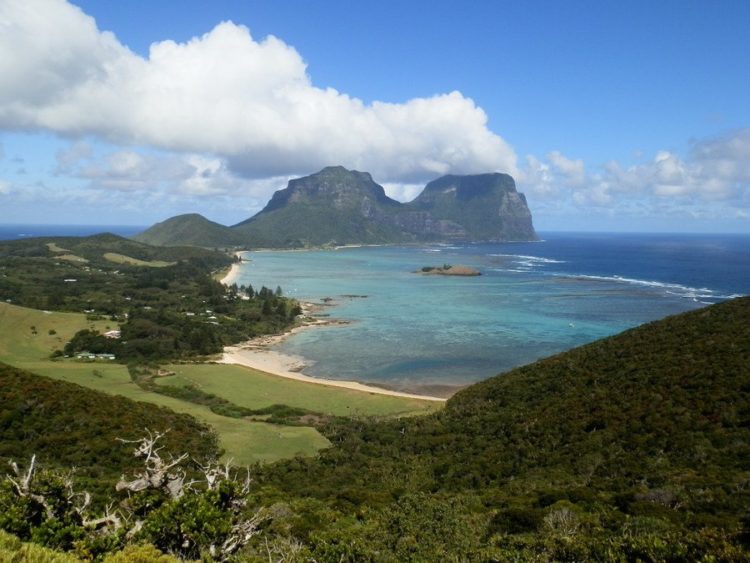
Going places on Lord Howe Island generally means walking or cycling – so depending on where you’re staying, just getting to the trailhead near Ned’s Beachwill add some extra mileage (why isn’t ‘kilometerage’ a word?) to the distance.
Start climbing Malabar Hill straight away and soon you’ll have sweeping views down to Neds Beach on one side and Old Settlement and northern part of the island on the other. A little higher and you’ll see Mounts Gower and Lidgbird, Balls Pyramid, highest volcanic rock stack in the world, and the Admiralty Islands. That’s if you can bear to look over the sheer cliffs plunging down, STRAIGHT down into the ocean.
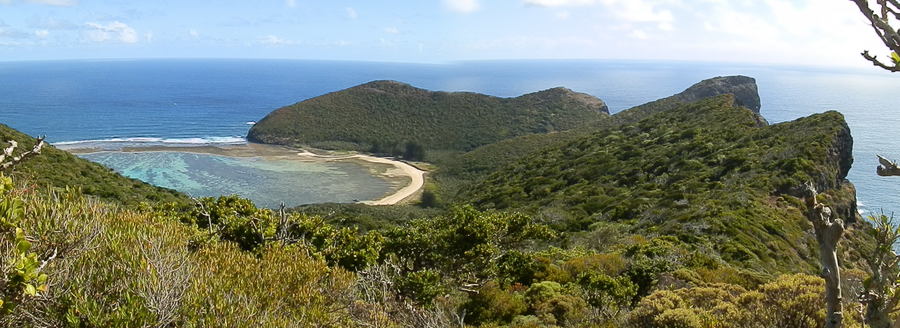
The track continues along the cliff tops (don’t look down!) to Kims Lookout with magnificent views over most of the island. Then it’s just a matter of heading down to the Max Nicholls track and back via Old Settlement Beach. Luckily, you’ll pass a cafe on the way!
Want MORE?
- While you’re on Lord Howe Island: Highlights include Cruises around the Island, to the Reef, North Bay and Balls Pyramid; Hiking, Water Sports, Birding, Historic Museum. MORE about Lord Howe Island
2. Bararranna Gorge, Arkaroola, South Australia
- Where is it: Arkaroola Wilderness Sanctuary, 730 km north of Adelaide, Outback South Australia.
- How to get there: Self-Drive on fully sealed roads to Copley, 600 km north of Adelaide. Arkaroola is 130 km north-east of Copley on an all weather dirt road.
- When to go: Anytime, but please note temperatures from November to March can be well above 30° C. Contact Arkaroola if planning to travel during this time to avoid closures.
- The Hike: Bararranna Gorge Loop Trail, 6.8 km, Moderate
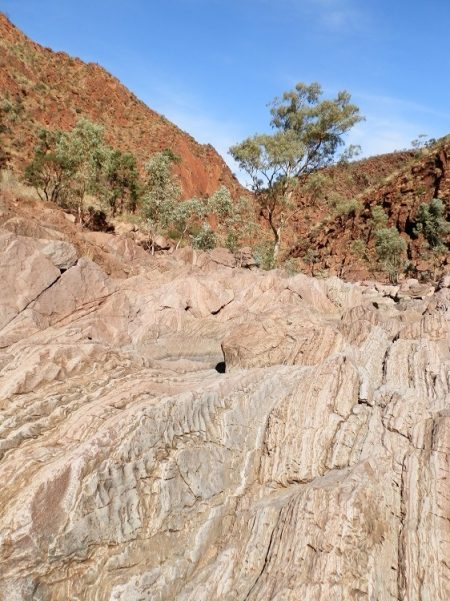
Actually, the hike can be a bit more than 6.8 km.
How much?
How far up the dramatic Bararranna Gorge you can get depends how much water is in Bararranna Waterhole.
Detour from the main trail to explore the gorge – an added extra to an already varied walk through a remote outback landscape scattered with waterholes, intriguing geological features (aka ‘rocks’) and wildlife.
Time passes quickly when you’re rock-hopping, admiring the dramatic cliffs, fossil-hunting and resting stopping for (endless) photos. Hunger and fatigue finally drove us back to the main track, where we finished the loop.
Only to find we’d doubled the suggested 3 hour walk time. But hey! We ARE the world’s slowest hikers!
Want MORE?
- While you’re at Arkaroola: Highlights include the signature Ridge-top Tour, Hikes, 4WD Tracks. MORE Things to Do at Arkaroola HERE
- While you’re in the Area: Explore the northern SA Outback and Flinders Ranges. Things to Do at Copley HERE
3. Dales Gorge Circuit, Karijini National Park, Western Australia
- Where is it: Karijini is 75 km East of closest town Tom Price; 1422 km north-east of Perth and 962 km south-west of Broome.
- How to get there: Self Drive. Bitumen roads all the way on main routes; dirt roads throughout the Park.
- When to go: During dry season cooler months May to August; May and June are best
- The Hike: Dales Gorge Loop combines all walks from Dales campground; ~4.5 km, moderate – Class 3 and 4, some steep sections with ladders
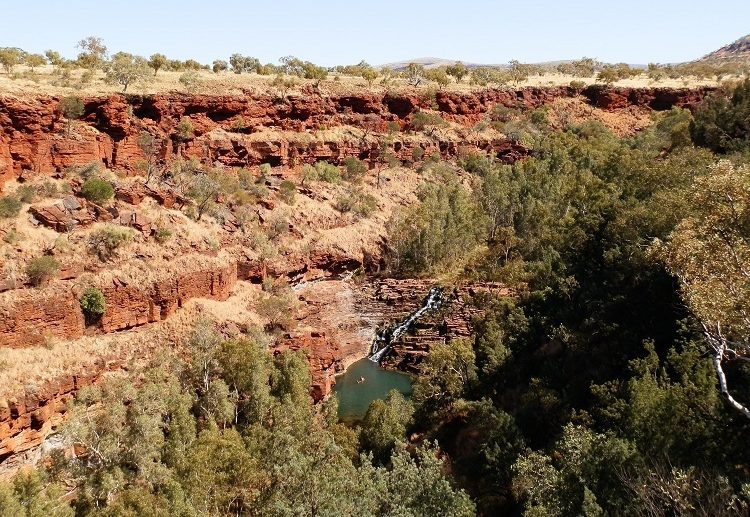
Could a track possibly lead safely down the sheer cliffs under the Three Ways Lookout to Circular Pool – 100 metres below? Of course! The REALLY steep bits have ladders! But the first part is the worst part as the track follows the winding river through groves of trees with steep RED rocky walls towering above. Actually, make that BEYOND red.

The river cascades down across treacherously slippery rock shelves as the trail winds steadily uphill towards Fortescue Falls. Then it’s up even further to popular swimming hole, the Fern Pool. Take a break there, because it’s a steep climb out of the gorge and another 2 km back along the Gorge Rim trail to the Lookout trail head.
Just as well this remarkably scenic walk gives weary walkers plenty of reasons to stop – photos, bird watching, admiring the view – that don’t sound like ‘resting’!
Want MORE?
- MORE about the Dales Gorge Walk
- While you’re at Karijini: Highlights include Hancock Gorge, Oxer and Knox Lookouts, Joffre Falls. MORE Things to do at Karijini HERE
- While you’re in the Area: Explore more of the Pilbara at Tom Price. MORE about Tom Price HERE
4. Nelly Bay to Arcadia, Magnetic Island, Far North Queensland
- Where is it: Magnetic Island is 8 km and a 20 minute ferry ride east of Townsville. The hike starts near the ferry terminal at Nelly Bay.
- How to get there: Townsville is 1336 km north-west of Brisbane, and 347 km south-east of Cairns on fully sealed roads.
- When to go: Anytime, but the wet season between November and April can be hot and humid. Most popular time is during the Australian winter months June to August.
- The Hike: Nelly Bay to Arcadia, 6 km + 2-3 km extra to walk from Arcadia back to Nelly Bay (local bus available), moderate
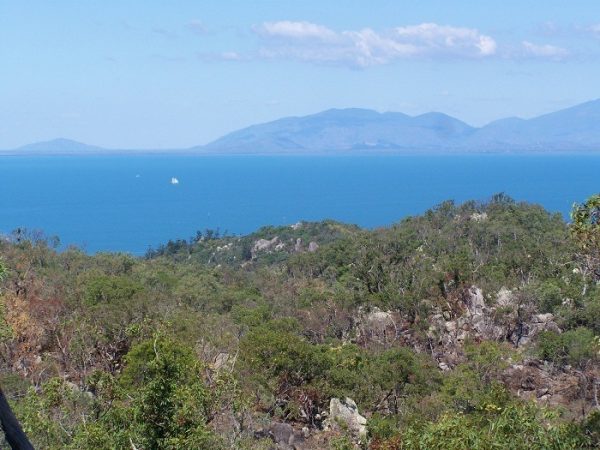
Experience life on a tropical island! AND see killer scenery from several vantage points overlooking island scenic hot spots and the mainland as the trail heads upwards through thick rainforest. It probably wouldn’t be anywhere near as tough a climb without the ever-present tropical humidity, but who cares with wildlife like Koalas and Black cockatoos on the trail?
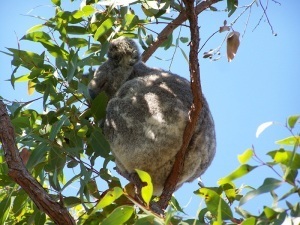
After a detour to the Sphinx lookout, the walk ends at Arcadia aka Magnetic Island ‘suburbia’. Unless you extend the hike by taking the Junction Track to the Forts, Arthur Bay, and even Horseshoe Bay if you’ve still got the energy! Walk back to Nelly Bay – or take the regular bus service!
Want MORE?
- MORE about the Nelly Bay to Arcadia Hike
- While you’re on Magnetic Island: Highlights include Beaches, Water sports, Hikes, Guided Walks, Wildlife. MORE things to do on Magnetic Island
- While you’re in Townsville: Highlights include National Parks and Reserves, Great Barrier Reef, Castle Hill, Northern Beaches, Tropical Islands. MORE things to do in Townsville
5. Jarnem Loop, Keep River National Park, Northern Territory
- Where: The Park is 3 km east of the WA/NT border; 203 km west of Timber Creek; 68 km east of Kununurra
- How to get there: Self Drive on fully sealed roads from Timber Creek or Kununurra. Dirt roads throughout the park.
- When to go: Cooler months from May to August. Seasonal closures due to flooding from November to April
- The Hike: Jarnem Loop Trail, 7 km, Moderate
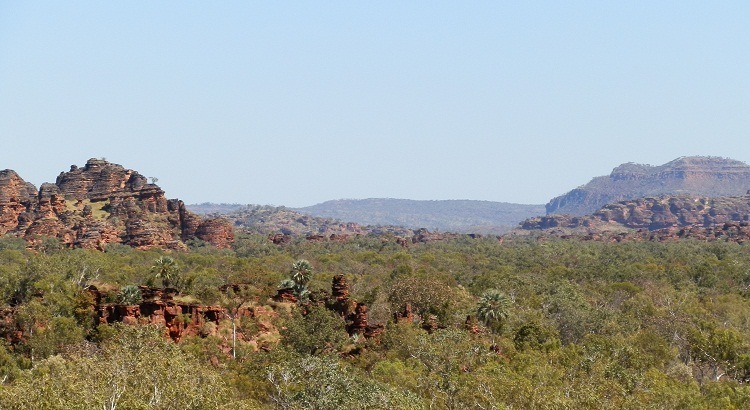
The weirdly striped sandstone domes lining the Jarnem Loop trail and filling much of the landscape beyond are often described as a ‘Lite’ version of the more well known Bungle Bungles. But whether or not that’s true, the view from the fantastic 360° lookout over ranges and plains is anything but Lite!
The trail winds back down to a palm-lined valley getting much closer to the wind-scoured layers and shapes of the rounded domes. Along the creek line are caverns with Aboriginal rock art, then the trail returns to the picnic area. And although it was peak tourist season, we had it all to ourselves!
Want MORE?
- While you’re in the Park: Highlights include Walks, Aboriginal Rock Art, Bird and Wildlife Watching. More about Keep River National Park HERE
- While you’re in the Area: Explore the Top End. Highlights include Victoria River Crocodile Cruise, Lake Argyle Cruise, Gregory and Mirima National Parks, Historic Sites, Fishing. MORE about Timber Creek HERE. MORE about Kununurra HERE.
6. Mt Abrupt, Grampians, Victoria
- Where: Mt Abrupt is in the Southern Grampians near Dunkeld, 280 km west of Melbourne
- Getting there: Self-Drive to Gariwerd (Grampians National Park) and the Grampians Region on fully sealed roads. Dunkeld is 64 km south of the more central Halls Gap.
- When to go: Anytime. Spring (Sept – Nov) best for wildflowers.
- The Hike: 6.5 km return, Moderate to Difficult.
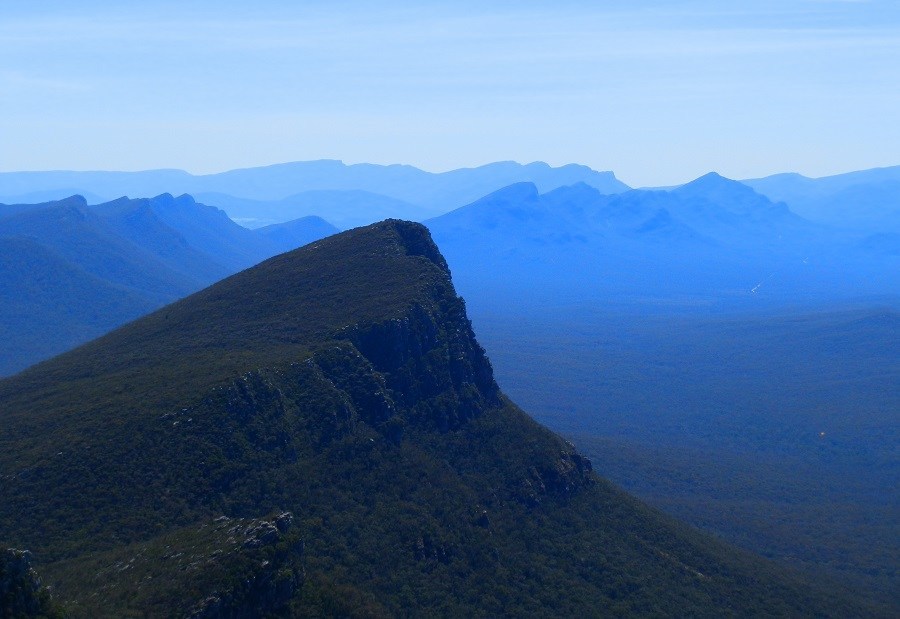
It’s got one of the most spectacular views of the wilder parts of the Grampians, but the view of Mt Abrupt’s forbidding sheer cliffs from Dunkeld make it look a LOT more difficult to climb than it really is. The trailhead starts just north of Dunkeld and climbs steadily through the bushland. After passing Signal Peak, the views unfold all the way to the summit over the Victoria Range and Valley, Serra Range, Southern plains and Dunkeld.
Returning via the same route means a chance to catch up on the photos you were too knackered to take on the way up!
Want MORE?
- MORE about the Mt Abrupt Hike
- While you’re in the Grampians: Highlights include Hikes, Rock Climbing, Scenic Drives, Fishing, Lookouts, Lakes, Seasonal Wildflowers, Wildlife, Historic Sites. MORE things to do in the Grampians HERE
7. Boodjamulla (Lawn Hill) National Park, Queensland
- Where is it: 220 km (136 miles) north-west of the Burke and Wills Roadhouse, between Cloncurry and Normanton;
- How to get there: Self-Drive. Take National Route 83 from Cloncurry. At the Burke and Wills Roadhouse, take State Route 84 – the Wills Development Road – to Gregory Downs. Boodjamulla is 100 km from Gregory Downs on a dirt road.
- When to go: Dry season from May to October. Roads can be impassable during the wet.
- The Hike: Several Hikes from 2-7 km, varying degrees of difficulty. The combined hike suggestion below is about 8 km, moderate to difficult.

It takes more than one walk to do Lawn Hill justice and discover everything this stunning blend of towering red cliffs, crystal clear water, palms, bushland, crocodiles, spa-like cascades, lookouts, giant carp and magnificent vistas has to offer. Chances are it’ll be HOT whatever time of year you’re there – and if you’ve come all this way you’d be mad to leave without seeing it all. So combine some of the shorter walks into a longer hike – or avoid heatstroke, stay a few days and do them one by one!
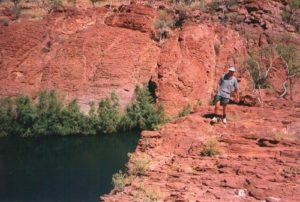
That way you’ll have time for the other activities!
But for the full experience in just one day, start early and take the Middle Gorge track to Duwadarri and Indarri Lookouts. Return the same way, or take the loop down the cliffs and back to the campground. Then do the Island Stack loop, and finish up by taking the Cascades detour – may as well have a natural spa before returning to the campground.
And don’t say I didn’t tell you to stay an extra day!
Want MORE?
- While you’re in Lawn Hill: Highlights include Swimming, Canoeing, Hiking, Wildlife. MORE about Lawn Hill National Park
8. Mt Kosciuszko Summit, via Jindabyne, New South Wales

- Where is it: The Mt Kosciuszko summit can be reached either from Thredbo, 212 km south-west of Canberra; or Jindabyne, about 34 km from Thredbo.
- Getting There: A number of routes access Thredbo, Jindabyne and the Kosciuszko National Park. The best route will depend from which direction you’re heading.
- When to go: Anytime, but the track is generally snowbound from June to October – you can reach the summit on cross-country skis or snowshoes, but the track had no snow poles.
- The Hike: 13 km return, Class 3 Moderate (from Thredbo); or alternatively18.6 km return, Class 3 Moderate (from Charlotte Pass).
En route from Thredbo to Mt Kosciuszko’s summit (Australia’s highest mountain), you’ll see Charlotte Pass (Australia’s highest permanent settlement) where Australia’s lowest temperature (-23° C) was recorded, Australia’s highest lake (Lake Cootapatamba) and Australia’s highest Public Loo (Rawsons Pass).

A long ride up the Kosciuszko Express chair lift from Thredbo quickly knocks off 600 metres of altitude. Then it’s a 6.5 km undulating walk to the summit on a specially constructed raised walkway protecting the fragile alpine vegetation beneath. Congratulations! You’ve climbed a Seven Summits peak!!
Hard to believe that back in the good old days you could drive nearly to the top – so the trickiest part of your climb will be to convince everyone how difficult it was!
Want MORE?
- MORE about the Mt Kosciuszko Summit Hike (via Thredbo)
- While you’re in the Park: Explore the Park’s seven different areas. More things to do in Kosciuszko National Park
- While you’re in the Alps: Australian Alps Highlights
9. Ormiston Gorge and Pound, Central Australia, Northern Territory
- Where is it: Ormiston Gorge is in the West MacDonnell Ranges National Park, 135 km west of Alice Springs.
- How to get there: Self-Drive on fully sealed roads from Alice Springs.
- When to go: Anytime, but April to October is best for hiking.
- The Hike: Ormiston Gorge and Pound Loop, 7 km, Moderate

Every kilometre the scenery changed. A steep gorge gave way to a hillside dotted with wildflowers and stunning views of Mount Sonder before descending into a spinfex-strewn valley leading up onto a scree-strewn saddle to a lookout over the Pound, ringed with rugged ranges. Down into the pound, across two creeks, then rock-hopping the gorge, red walls towering above us.
At the end of the gorge – only a kilometre to go – recent rain meant the final creek was running higher than usual. Sadly, I hadn’t yet mastered the art of levitation, so I chose to wade through the frigid water – a kilometre in wet underwear WAY better than a 6 km back-track! If you get lucky and don’t need to choose, I say you’ll be missing a super-COOL experience!
Want MORE?
- MORE about the Ormiston Gorge and Pound Walk
- While you’re in Ormiston Gorge: Highlights include Glen Helen Gorge, Larapinta Hiking Trail, Ochre Pits, Gorges and Waterholes. MORE Things to Do in Ormiston Gorge
- While you’re in the Area: Explore the area around Alice Springs. MORE Things to do in Central Australia
10. Deep Creek Cove, Fleurieu Peninsula, South Australia
- Where is it: Deep Creek Conservation Park is on the Fleurieu Peninsula, 108 km south of Adelaide
- How to get there: Self Drive along Main South Road from Adelaide, about 1.5 hours.
- When to go: March – May and September – November. Summer (Dec – Feb) is dry and hot with temperatures from 30-35. Winter (Jun – Aug) is wet, so tracks can be slippery.
- The Hike: Deep Creek Cove from Trig Picnic Area, 6.4 km return, Moderate

Deep Creek Cove is accessible from two points: a moderate, but longer hike from Trig Picnic Area, and a shorter, more difficult hike from Tappanappa Lookout. But for us, two attempts = two FAILS and I’ve NEVER reached the Cove!
On our first attempt (via Trig) I was off work after an eye operation so we’d decided to explore. That was wrong. VERY wrong. And you’ll be glad to know I was punished for breaking the sick leave rule by actual illness when my eye turned to the dark side and I couldn’t finish the hike. My bad.
‘Where are those explosions coming from?,’ I wondered aloud to Pilchard on our 2nd attempt from Tappanappa as we started down the hill. ‘I didn’t know there was a quarry in the area’. Turns out there wasn’t and the explosions we heard were actually thunderclaps heading our way. So we abandoned the hike, scuttled back to the car and leftf the park before the rains hit the dirt roads.
The Deep Creek Cove hikes and several others (including the Deep Creek waterfall hike which I actually HAVE done), combine to make up the 10.9 (and much more difficult) Deep Creek Circuit. And at this rate it’ll only take me another 10 years to finish it all.
In the meantime, if YOU get to Deep Creek Cove before I do, let me know what it’s like!
Want MORE?
- While you’re in the Park: Highlights include 15 Hiking Trails, Blowhole Beach, Lookouts, Wildlife, Camping. MORE Things to Do at Deep Creek Conservation Park HERE
- While you’re in the Area: Explore the Fleurieu Peninsula. Highlights include the Cockle Train, Coorong Cruise, Beaches. MORE Things to do on the Fleurieu Peninsula HERE
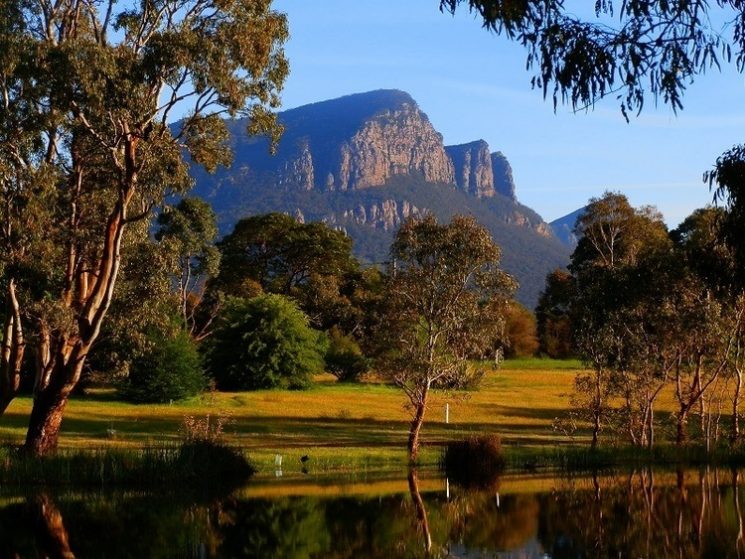
There are lots more hikes in Australia and I know I’ve probably missed some good ones. What’s YOUR favourite half day hike holiday hot spot?
Like it? SHARE it!
The post 10 TOP Half Day Hikes in 10 HOT Australian Holiday Spots appeared first on Australia by Red Nomad OZ.
]]>Wondering how you’re EVER going to see as much of Australia as I have? Trust me, travelling OZ is SO worth it! And if you need reasons to do it other than the stunning natural attractions, amazing Aussie experiences and fabulous holiday destinations, take a look at these 25 science-backed health benefits of travel HERE. Here’s HOW to get your[...]
The post See Australia Month by Month Part Two: July to December Travel Teasers! appeared first on Australia by Red Nomad OZ.
]]>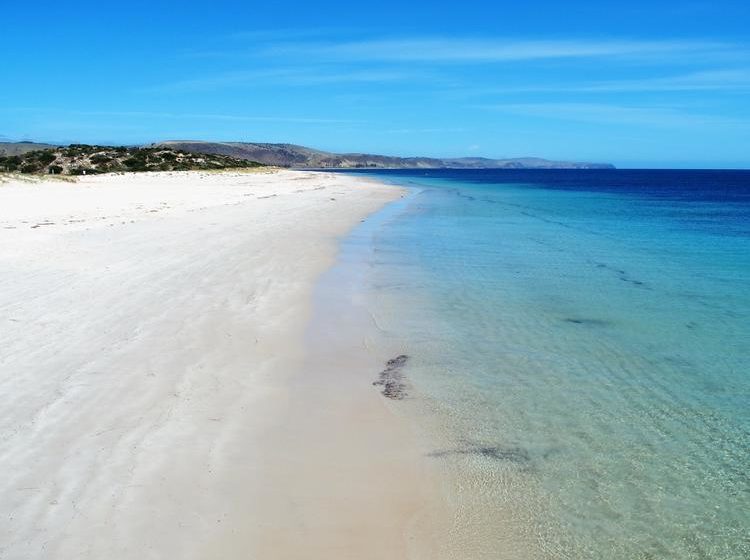
Wondering how you’re EVER going to see as much of Australia as I have? Trust me, travelling OZ is SO worth it! And if you need reasons to do it other than the stunning natural attractions, amazing Aussie experiences and fabulous holiday destinations, take a look at these 25 science-backed health benefits of travel HERE.
Here’s HOW to get your Aussie travels under way so you can see Australia AND start reaping those health benefits RIGHT NOW!
You CAN see a LOT of Australia by using the simple 3-step program I showed you in Part 1 (Right HERE if you missed it) whenever you have a week (or two) to spare – in ANY month of the year.
Here’s what to do with that free week (or two)
- Choose a region you haven’t been to yet.
- Escape with some cheap flights, beg/borrow (but don’t steal) a camper, jump in the car, or let someone else do the driving and take a tour.
- GO! Then next time you’ve got a week (or two) off, do it all again.
Yep, that’s how it’s done. And Part One gave you some travel teasers for if your week (or two) off fell during January to June. Now here’s a whole new set of travel teasers for July to December!
You’re welcome!
July: The RED Kimberley
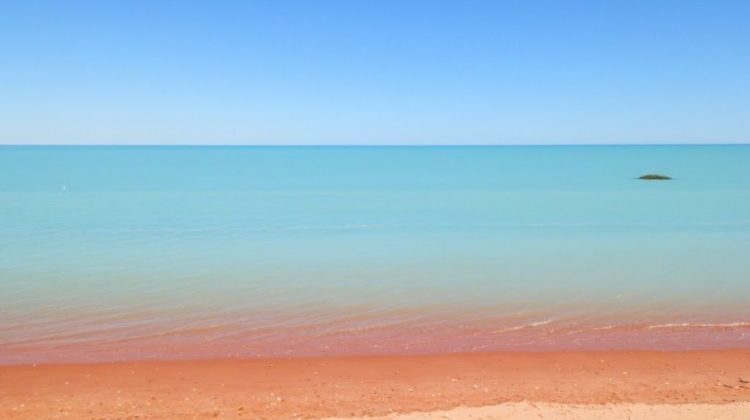
#13 Broome, Western Australia
Broome’s vivid red and startling blue colour palette is the perfect antidote to a dreary southern-Aussie winter. Factor in a clutch of tropical attractions like semi-deserted beaches, fresh tropical produce (across a varied multicultural menu) and killer sunsets, and it’s hard to beat as the perfect July destination. The dinosaur footprints, brewery and world’s oldest operating picture gardens with a super-cool scenic loo are just a bonus!
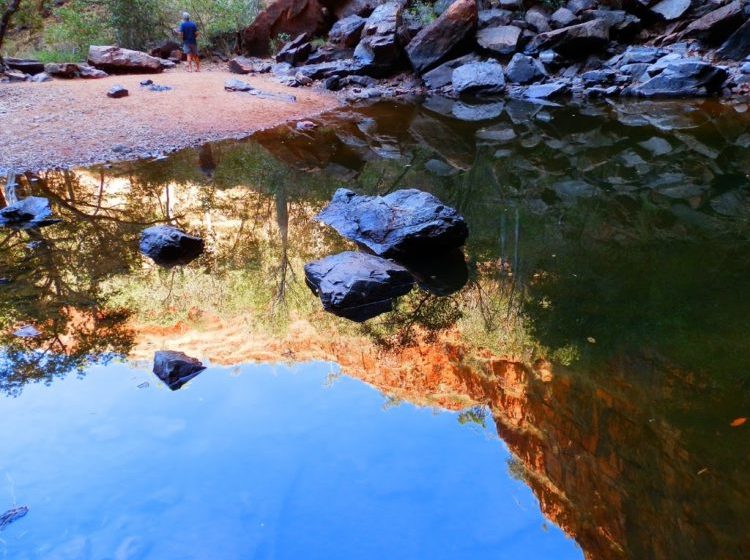
#14 Kununurra, Western Australia
If you like wilder, redder rocks, then the east Kimberley’s Kununurra delivers with red rock domes in Kununurra’s Mirima National Park; the Sleeping Buddha of Lily Lagoon – and a whole mountain range buried under the mega-ultra-massive Lake Argyle, 10 times bigger than Sydney Harbour and full of crocodiles. This dam above the Ord River scheme also delivers a whole range of fresh produce – just perfect for siesta time in the hottest part of the day!
There’s a whole lot more to see and do in the Kimberley outside of Broome and Kununurra – read MORE about the Kimberley HERE!
August: Outback
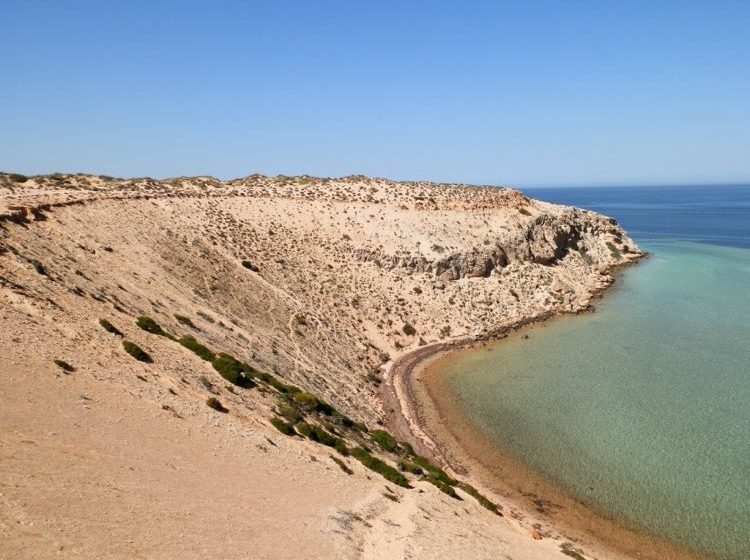
#15 Shark Bay, Western Australia
Outback? On the COAST? You betcha! Shark Bay is where the outback meets the sea with a wild and weathered coastline enclosing warm waters filled with an exciting array of wildlife: think sharks, dugongs, stingrays – and dolphins! The whole bay is a diverse World Heritage area: think Hamelin Pool Stromatolites – oldest known living organisms; Steep Point – westernmost point of mainland OZ; Dirk Hartog Island National Park; and the oldest recorded site of European contact!

#16 Lightning Ridge, New South Wales
Go straight to the top of Opal Mining Town weird and wonderful and check out the fantastically quirky Lightning Ridge, Black Opal capital of the WORLD! If the allure of the Chambers of the Black Hand or the world’s only black opal mining cactus farmers don’t do it for you, then fossick yourself a gem (or ‘find’ a piece of opal in one of the many shops), check out the awesome Outback Art or soak away that stress in a HOT artesian bath!
MORE about Lightning Ridge and other Australia’s Opal Mining HOT Spots HERE
September: Rocks
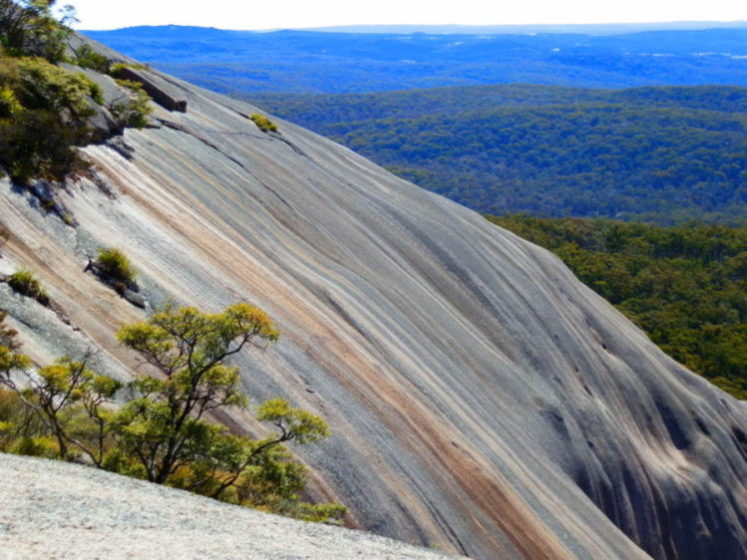
#17 Tenterfield, New South Wales
Climbing Bald Rock, Australia’s largest Granite Monolith is just one reason Tenterfield makes a great base for exploring New England, the Northern Rivers and Granite Belt Region, just across the border in Queensland. It’s not just about the stunning National Park and self-drive tour scenery – explore local villages, visit cellar doors and local producers, and discover historic sites – it’s home of Peter Allen, the Boy from OZ. And don’t miss Tenterfield’s famous Federation Pie – it’s quite possibly the best downunder!
MORE about Tenterfield HERE and MORE about Bald Rock HERE
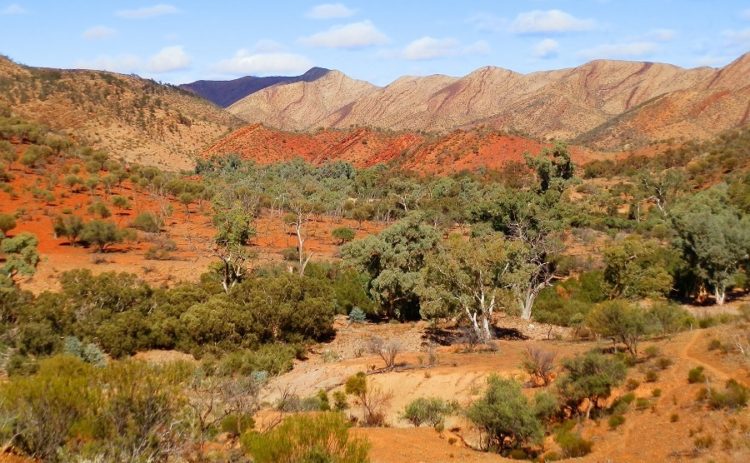
#18 Flinders Ranges, South Australia
This ancient landscape in the remote South Australian outback is the original time-tunnel where the exposed layers of Brachina Gorge take you back – WAAAAAY back – through millenia of earth’s pre-history . But it’s not just a geologist’s paradise, it’s an adult adventureland of rugged ranges with 4WD tracks to historic mine sites, mountain climbing, hiking, mountain biking and cycling; horse and camel riding; and self-drive tours to some of the best scenery in OZ
MORE about the Flinders Ranges HERE
Like Rocks? Australia is the right place to be! Check out more of Australia’s rocky HOT Spots!
MORE about Australia’s other Rock Stars HERE
October: Wildflowers

#19 Kalbarri, Western Australia
The floral equivalent of shooting fish in a barrel, Kalbarri’s flower strewn landscape makes spotting a LOT of Western Australia’s 12,000 wildflower species almost TOO easy. And when the flower hunt is over, you’re spoilt for choice with other natural attractions like the ancient gorges of Kalbarri National Park, the eroded islands and valleys of the Murchison River, and the dramatic sandstone cliffs along a sensational coastline.
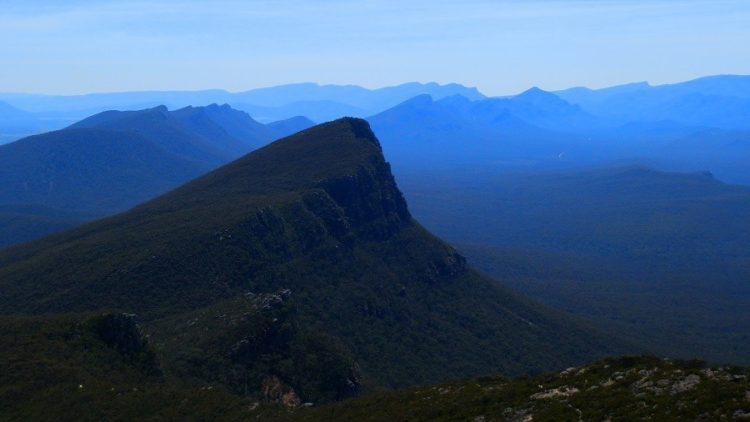
#20 Grampians, Victoria
Wildflower season in Victoria’s Grampians also makes flower spotting a sure thing. Combine your floral frenzy – over 1000 species – with exploring the rugged grandeur of the ranges – think hikes, mountain climbing, cycling, scenic flights – then indulge in one (or more!) of the region’s foodie HOT spots!
MORE about Grampians Wildflowers HERE
November:
#21 Great Ocean Road, Victoria
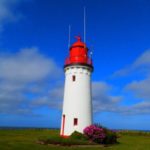
Even if you don’t have time to road-trip the coast between Torquay, just south of Melbourne and Nelson near the South Australian border, just 400 km away, make time to see the highlights. Like what? Well … pig out on the foodie trail; take in the stunning sculpted coastline; detour into the rainforests of the Otway Ranges; hang out on the beach; go lighthouse spotting; visit a village. Actually, just do the whole thing – it can be done in as little as 3 days!
MORE about the Great Ocean Road HERE
#22 Whitsundays, QLD
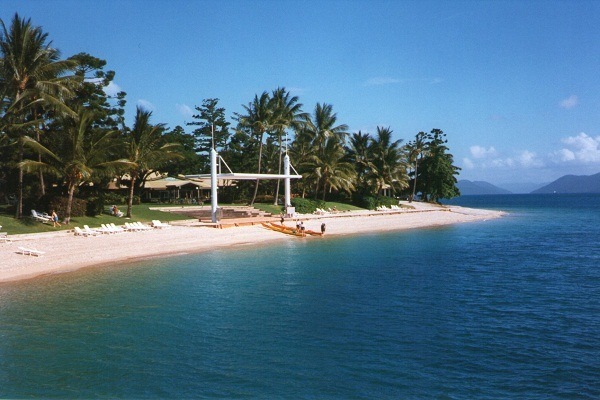
A stunning coastline lined with beaches; a tropical blue ocean studded with 74 stunning tropical islands all adjacent to the Great Barrier Reef.
Private beaches, National Parks, historic sites, snorkelling, scuba diving, sailing and fishing to die for.
Yes, the Whitsundays sounds WAY too good to be true – but it really IS this cool!
MORE about the Whitsundays HERE
December:
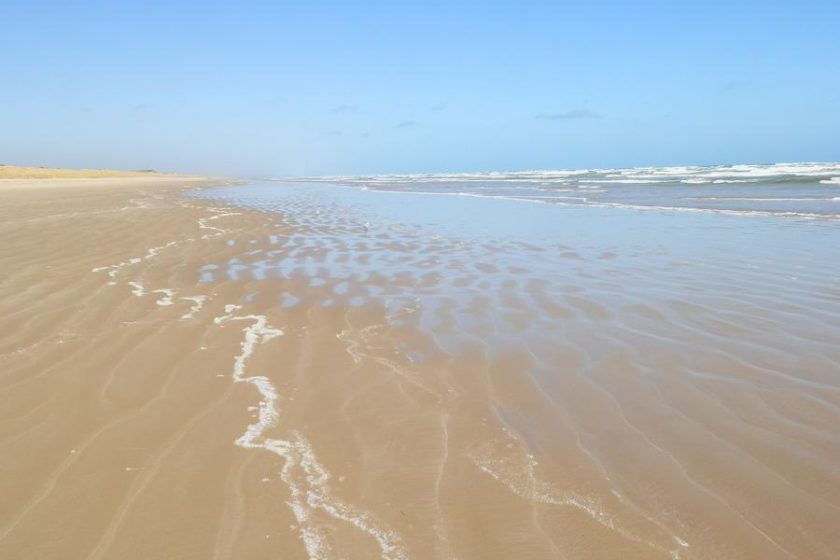
#23 Fleurieu Peninsula, SA
Catch the Cockle Train – Australia’s oldest public railway; cruise the Lower Lakes and Coorong to the Murray Mouth – end of Australia’s longest river system; climb South Aussie icon The Bluff; and visit one (or more!) of the 100 or so cellar doors just an hour south of Adelaide on the Fleurieu Peninsula. Oh – and there’s a couple of public amenities blocks that made it into Lonely Planet’s book of world’s best scenic loos too!
MORE about the Fleurieu Peninsula HERE
#24 Sydney, New South Wales
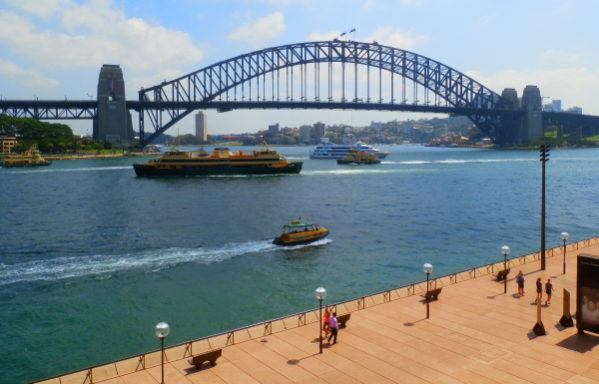
Yes, Sydney’s biggest attractions are SUCH a cliché! But that doesn’t mean they’re not worth visiting! SO … cruise the harbour, climb the bridge, see something at the Opera House, visit Taronga Park zoo, wander the Botanic Gardens, catch the ferry to Manly, check out Darling Harbour, go shopping, visit museums and galleries, then find somewhere cool to eat. See? I told you it’d be fun!
Well, that’s how to get started on seeing OZ! Of course you can visit all these regions at other times of the year – the monthly guides are just suggestions. And when you’re done with these I bet you’ll find that there’s a whole lot more on your Aussie travel bucket list.
That’s why I’m still travelling Australia 
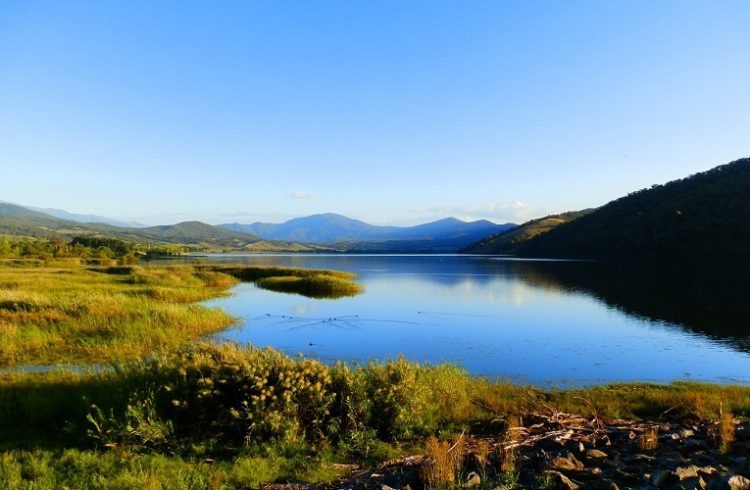
Want MORE?
Disclosure: This post contains a sponsored link for cheap flights
Like it? SHARE it!
The post See Australia Month by Month Part Two: July to December Travel Teasers! appeared first on Australia by Red Nomad OZ.
]]>I’ve been a BIG fan of maps since forever. So when Hema Maps wanted to collaborate on a post about Australia’s hidden hot spots, I agreed straight away! Below is the Hema Maps selection of 7 AMAZING almost-secret Aussie Hot Spots – even I haven’t been to some of them – then take the link at the end of the post to find[...]
The post 14 TOP Secret Aussie Hot Spots appeared first on Australia by Red Nomad OZ.
]]>I’ve been a BIG fan of maps since forever. So when Hema Maps wanted to collaborate on a post about Australia’s hidden hot spots, I agreed straight away! Below is the Hema Maps selection of 7 AMAZING almost-secret Aussie Hot Spots – even I haven’t been to some of them – then take the link at the end of the post to find MY 7 secrets on their website!
Take it away, Hema Maps!!
Every Australian state has popular hotspots which grab all the plaudits, but to the side or within these places are hidden gems that manage to fly under the radar of most off-road travellers.
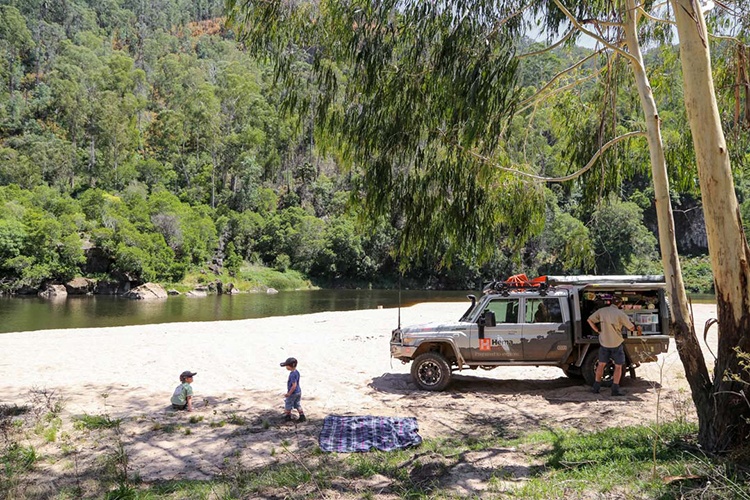
1. Jacksons Crossing, High Country Victoria
High Country Victoria is known for its heights – ridge-riding 4WD tracks and expansive mountain vistas are the norm – but you need to look down low to find one of the region’s most memorable spots.
Jacksons Crossing is a bush camp off Varneys Track, northeast of Buchan, which is situated next to the iconic Snowy River. The trip in is a classic High Country drive, and the reward for your efforts is a campsite that ticks all possible boxes with minimal fuss. A beach unexpectedly appears out of nowhere in amongst this alpine setting, next to a campsite that’s nestled between rising alpine ranges on either side. Offering plenty of room in picturesque natural surrounds, Jacksons Crossing combines classic High Country themes in a family-friendly environment. Keep in mind that private property is nearby, so be sure not to stray into areas you shouldn’t.
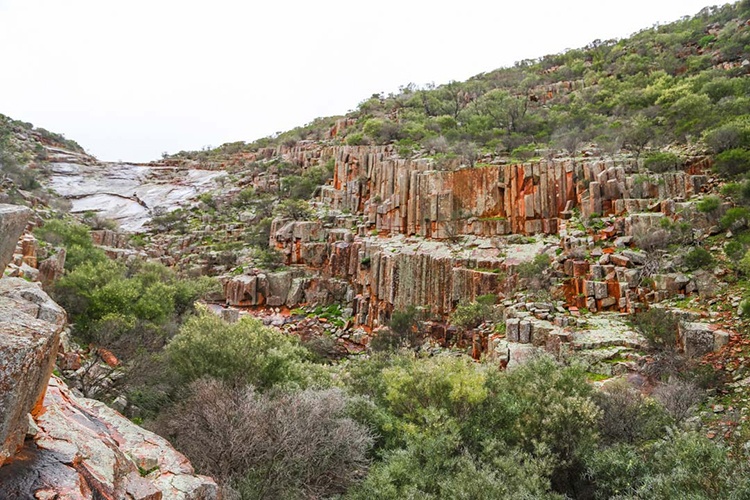
2. Organ Pipes – Gawler Ranges National Park, SA
The Flinders may be the most famous ranges in South Australia, but the Gawler Ranges rolling Outback hills are home to something uniquely spectacular. Called Organ Pipes (and named so for obvious reasons), these fascinating columns were pushed upwards from beneath the earth over 1500 million years ago due to volcanic activity, creating eerily consistent formations that make the Gawler Ranges a must-visit Outback destination. The park is also renowned for its rich red tracks and rolling hills, which make for a sensational backdrop as you drive through this unique region.
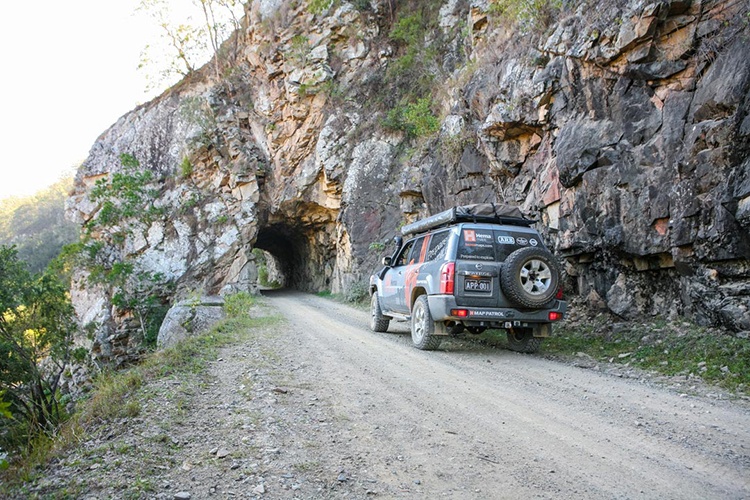
3. Old Glen Innes Road, NSW
This charming drive through rural New South Wales takes you back in time as you roll through ghost towns slowly being absorbed by verdant hinterland. A town called Dalmorton sprung up in the 1860s after gold fever took over the region, which supported a population of 5,000 in the surrounding area during its peak.
Remnants of this forgotten past is evidenced by old mine shafts that dot the hills along the journey, in addition to dilapidated buildings and a lonely tennis court in the middle of nowhere. Along the drive is a tunnel – supposedly built using civilian labour in the 1880s – that bores through the side of the mountain on which the road climbs. Like a self-driving museum in natural surrounds, the Old Glen Innes Road is an enthralling journey in time and space.
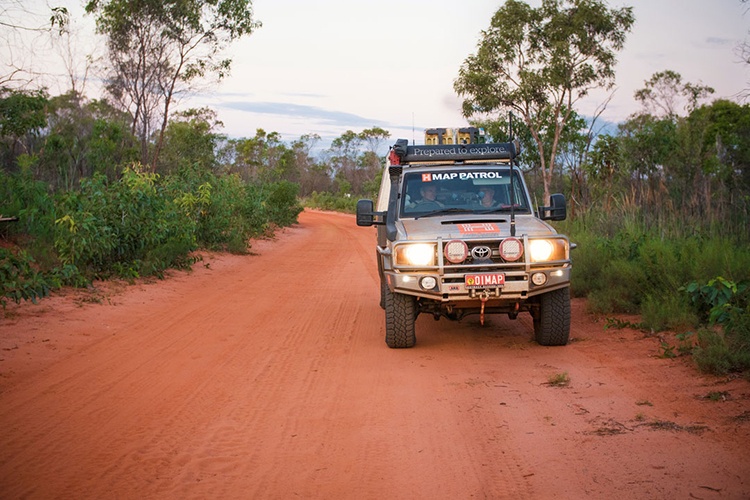
4. Gnylmarung Retreat, WA
Newcomers to Cape Leveque in Western Australia’s Kimberley region can be forgiven for going with the masses to Kooljaman in the north, but for a more secluded coastal camping experience, it’s hard to go past Gnylmarung Retreat. Situated on the western side of the cape above Beagle Bay, everything about Gnylmarung is spacious and blissfully basic, with other campers only spotted occasionally as they make their way to the outdoor shower or down to the beach to watch the sun set.
If you can resist the pull of the more recognised camping areas around Cape Leveque, you’re guaranteed to find tranquillity to go with your Kimberley coastline at Gnylmarung – sans backpackers and other crowd contributors.
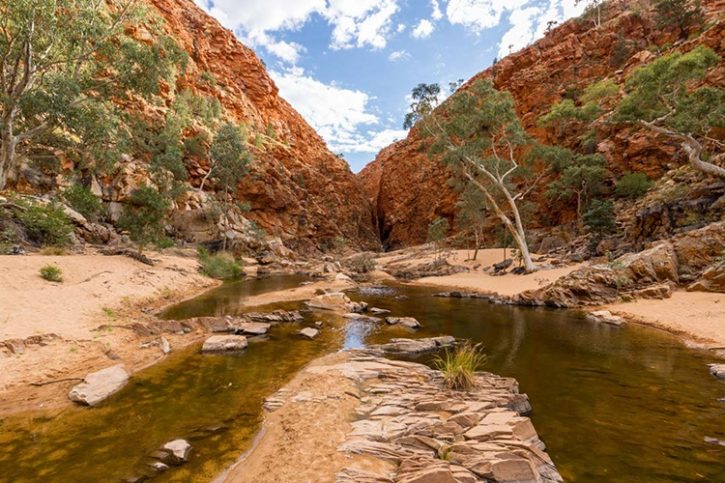
5. Redbank Gorge, NT
Central Australia is a hotbed of stunning natural beauty of jaw-dropping proportions, much of which is well-known to any Outback traveller worth their salt. Amongst iconic places like Uluru and Palm Valley, Redbank Gorge quietly amazes visitors who venture to the western end of the West MacDonnell Ranges, its unassuming appearance upon entry giving way to something much more impressive.
The camping around Redbank Gorge offers basic facilities, with everything appearing to be business as usual until you walk behind the campsite to find a view to rival any lookout. You can then head deeper into the ranges to get to Redbank Gorge itself, or to take on Section 12 of the Larapinta Trail to experience central Australia’s most spectacular walking trail. While it may be on the fringes of the West Macs, Redbank Gorge is front and centre as one of the Red Centre’s best hidden gems.
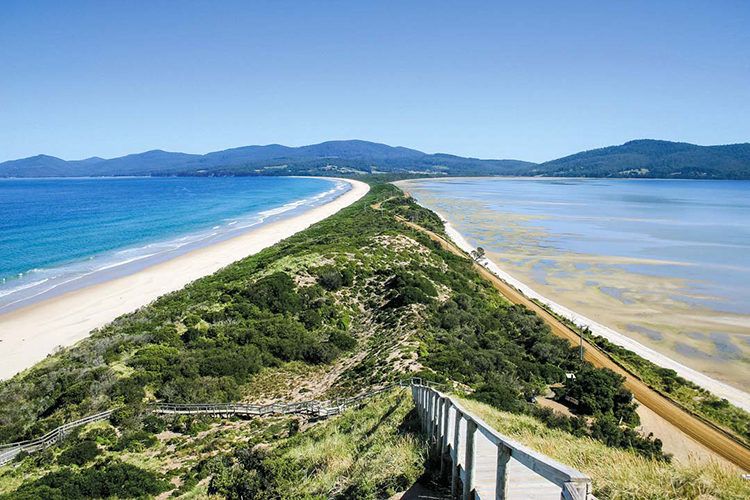
6. Bruny Island, TAS
Australian mainlanders may struggle to see the sense in going to an island to reach yet another island, but once you reach Bruny, any wondering will end. Aside from the artisanal cheese, chocolate, seafood and wine on offer, Bruny offers a wilder side for travellers to experience.
The 100km-long island is fringed by beaches and cliffs, with multiple camping areas available in the south, including the 4WD-only Cloudy Bay Corner Beach Camping Area. There are plenty of walks available all over the island, which are often the best way to see wildlife – 13 of Tassie’s 14 endemic birds can be found on Bruny – such as the fairy penguins which nest near The Neck, a skinny strip of beach which links North and South Bruny Island.
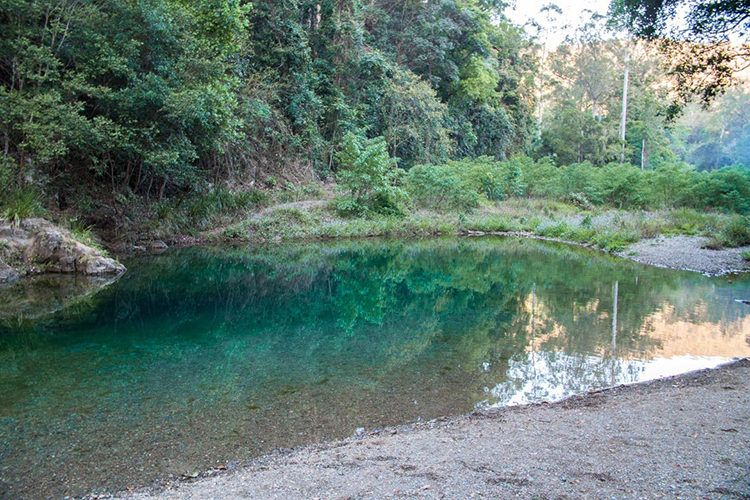
7. Conondale National Park, QLD
South East Queensland’s Scenic Rim is a volcanic remnant that is home to lush rainforest and a multitude of national parks for campers, hikers and four-wheel drivers to explore. While many travellers are drawn to the Scenic Rim’s southwest icons – Main Range and Lamington national parks – higher north is the Scenic Rim’s quiet achiever: Conondale National Park.
Close to the refreshingly quaint towns of Kenilworth and Maleny, Conondale National Park presides over an abundance of attractions and 4WD tracks in a relatively small area. Entry to the park begins with a creek crossing, after which the track cuts into rainforest with occasional steep gradients and excellent views from breaks in the tree line.
Within the park itself are four camping areas with access to stunning Booloumba Creek, as well as entry to the Queensland government’s Conondale Range Great Walk – a 56km hike through cloistered rainforest and open scrubland that takes four days to complete. A short drive from the camping areas is a lookout, while also along the loop drive is a lookout and a handful of rest areas at which you can relax.
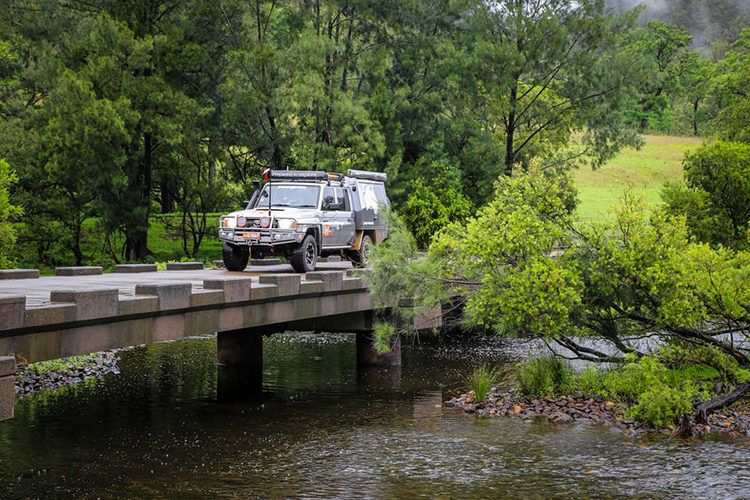
Well, that’s 7 secret travel spots provided by Hema Maps. You were promised 14! Now view MY 7 top secret Australian travel spots hosted at Hema Maps.
Hema Maps are adventure and navigation experts who produce a range of navigation solutions that will help you to find your own secret spots!
PS Having trouble finding these secret hot spots? Why not check out the Hema Maps Hema HX1 Navigator! How good is it? Then check out the Red’s Australia HX1 Navigator Review?!
* Photos and text courtesy of Hema Maps
The post 14 TOP Secret Aussie Hot Spots appeared first on Australia by Red Nomad OZ.
]]>I’ve been to a lot of great camping destinations off the beaten track. They’re usually part of a lengthy road-trip with no schedules, tight time frames or deadlines. But where do you go if you haven’t got time for a long road trip? Where do you go if you want a less challenging trip? And where do you go to[...]
The post Australia’s 10 BEST Camping HOT Spots! appeared first on Australia by Red Nomad OZ.
]]>
I’ve been to a lot of great camping destinations off the beaten track. They’re usually part of a lengthy road-trip with no schedules, tight time frames or deadlines.
But where do you go if you haven’t got time for a long road trip?
Where do you go if you want a less challenging trip?
And where do you go to get away from it all in a great place with an awesome array of things to do that doesn’t take forever to get to?
How DO you get started?
No camper? No problem! Start by checking out out the camper vans here on Gumtree!
Then choose one of my TOP 10 favourites – I’m calling them the best camping spots in Australia – and get your show on the road!
South West Rocks, New South Wales

Overlooking the exquisite beauty of Horseshoe Bay, down the road from historic Trial Bay Gaol and up the road from stunning Smoky Cape Lighthouse, the Horseshoe Bay Caravan Park is in one of Australia’s premier coastal locations.
The surrounding region is such a wonderland of rivers, rainforest, rocks and beaches it’s hardly surprising it once was (and still may be) former TV personality Ray Martin’s holiday destination of choice! But the fun doesn’t stop there – hit the main street and you’ll find one of Australia’s best bakeries!!
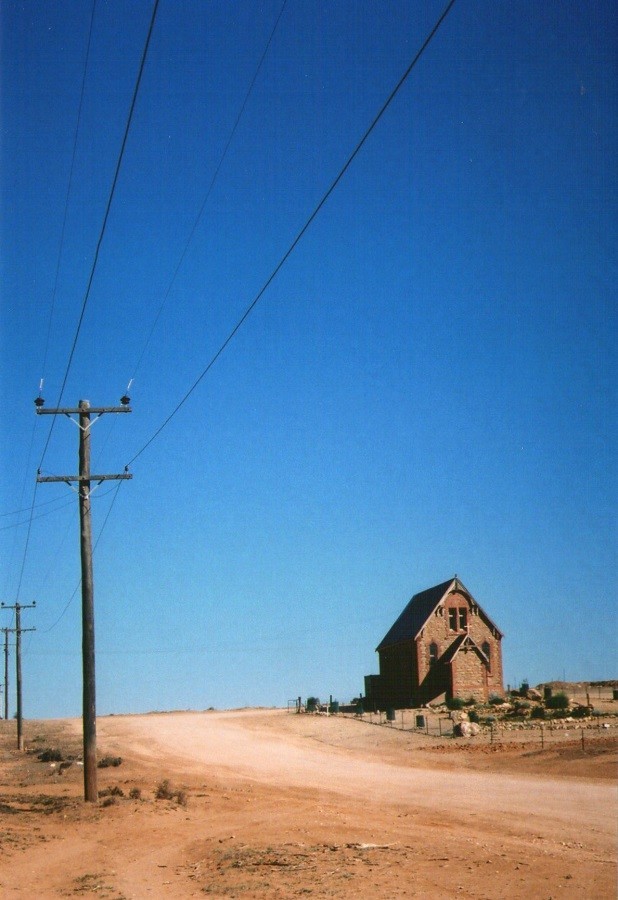
Broken Hill, New South Wales
For a taste of the outback without the LOOOOOONG distances, dirt roads and bull dust, check into the Broken Hill Tourist Park – the slag heap in the middle of town is a dead giveaway to what makes this place tick.
But its also home to a colony of artists whose work is full of outback light, colours and landscapes – you’ll find it hard NOT to bring home a souvenir!
Further afield there’s Silverton, where many movies have been set, and Menindee Lakes where the sunsets go on forever.
Lake Moogerah, Queensland
Who knew that a couple of days in the amazing Scenic Rim Region would turn into more than a week? Being surrounded by a superb array of stunning natural attractions, atmospheric small towns and fantastic fresh produce is enough of an incentive WITHOUT the added attractions of magnificent Lake Moogerah!
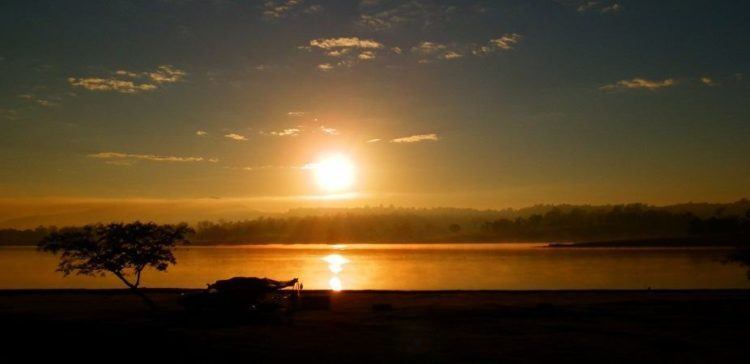
With one of the most scenic campgrounds in OZ, the Lake Moogerah Caravan Park is the perfect base from which to spend a day exploring – and then to return for the amazing sunsets over the lake!
Millaa Millaa, Queensland
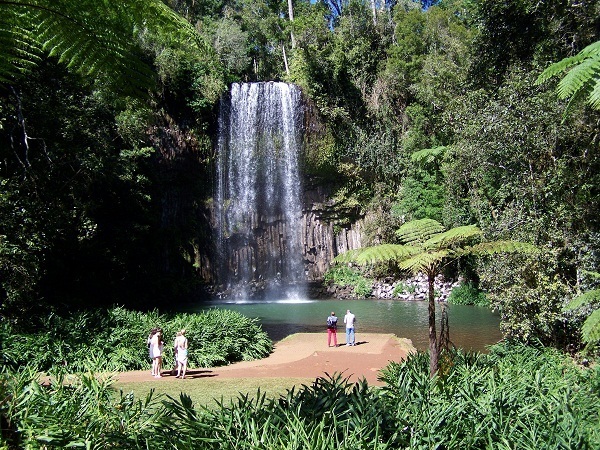
I’d be able to pick Millaa Milla Falls (see first photo) on Queensland’s Atherton Tableland out of any waterfall line-up! And the Millaa Millaa Tourist Park on the outskirts of Millaa Millaa with Mt Bartle Frere, Queensland’s highest mountain, in the background is a stunningly scenic base from which to explore the southern Tablelands – a tropical paradise full of rainforest, waterfalls, townships and fantastic produce. Don’t leave without trying EVERYTHING!
Ormiston Gorge, Northern Territory
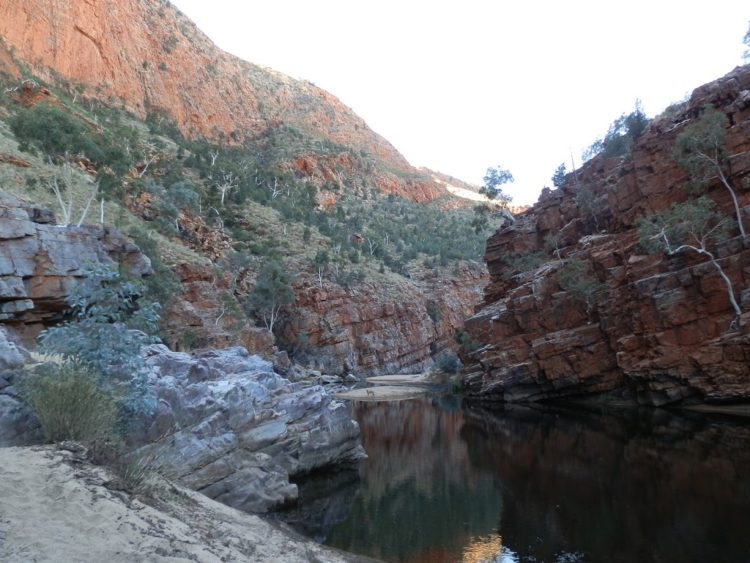
A stay at the Ormiston Gorge campground puts you in the box seat for superb sunrises; dingo sightings; short walks around the gorge; wonderful Outback colours and landscapes; and the ~7 km Ormiston Gorge and Pound walk – one of Australia’s BEST short (ish) hikes.
In my humble opinion!
Factor in day trips to Glen Helen Gorge, the Ochre Pits, other West MacDonnell Range gorges and Tylers Lookout, and you’ve got a destination worth visiting even without the stunning Mt Sonder (see first photo)!
Kununurra, Western Australia
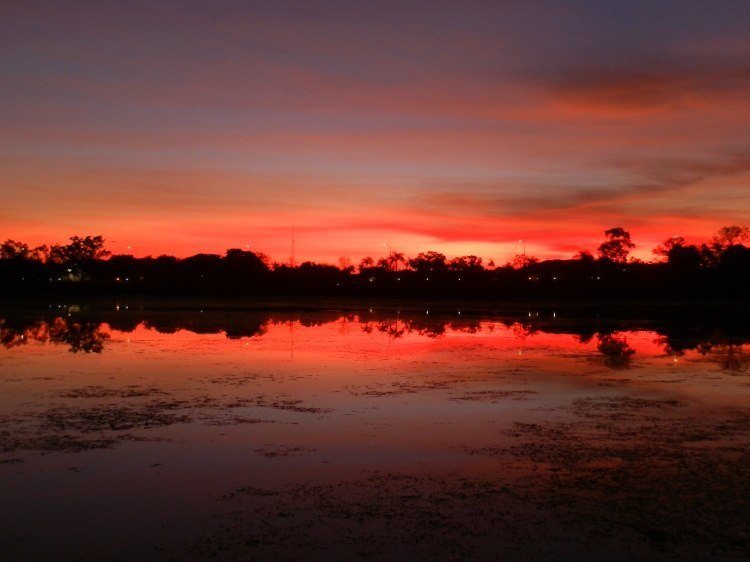
Theres a lot to see and do in and around Kununurra, but we didn’t need to move from our Kununurra Lakeside Resort campsite on the shores of Lily Lagoon to see crocodiles, birds and some of the best sunsets in the Kimberley. But the Ord River produce is worth heading out for, and smart travellers will time their visit to coincide with the Kununurra Agricultural Show – who could resist the lure of the Melon Olympics and Cane Toad Races?! That makes the long trek to get there from almost anywhere SO worth it!
Kalbarri, Western Australia
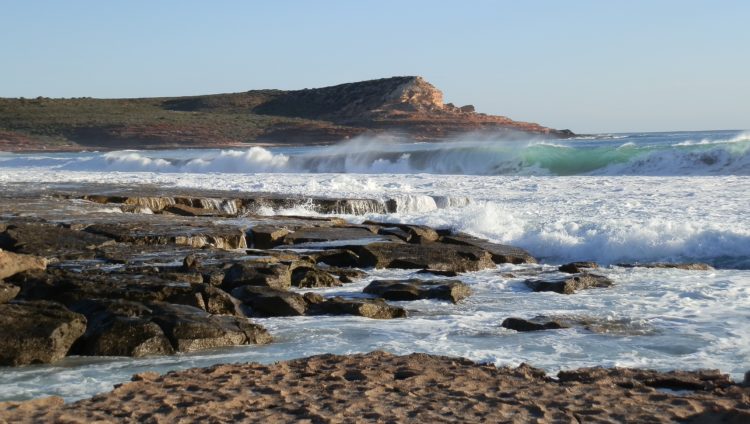
If you’re visiting in spring, don’t let the stunning array of Western Australian wildflowers stop you from seeing the rest of Kalbarri’s attractions! Stay a few days at the Kalbarri Tudor Holiday Park and explore the plunging sandstone cliffs, unusual rock formations, deep gorges, magnificent beaches and the wild Murchison river – but watch out! Those wildflowers will probably distract you there too!!
Angorichina, South Australia
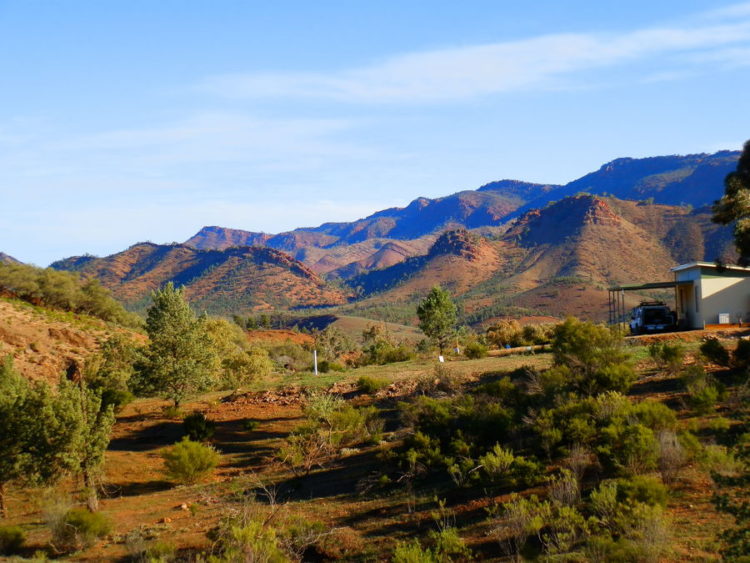
Fewer people make it to Angorichina in the northern Flinders Ranges – they’re too busy doing Wilpena Pound further south. But take a drive on the wild side of the ranges and you’ll discover wonderful walks; four wheel drive treks through spectacular scenery; self-drive and guided tours of historic mine sites; and stunning rock formations – all within cooee of Angorichina Village, an ex-tuberculosis sanatorium, now campground with one of the most scenic settings in OZ!
Bright, Victoria

You CAN see autumn colours in Australia AND camp among them too at the Bright Holiday Park!
Bright, in the shadow of Mt Hotham, is a great introduction to Victoria’s High Country. The Autumn Leaves Festival and Wandiligong Nut Festival are full of regional delights, and nearby Mount Buffalo’s natural attractions are worth trekking up to its 1723 metre summit – The Horn – for!
Then there’s the blackberry pies at the Edelweiss Bakery in Bright’s main street …
Port Fairy, Victoria
Get three top towns for the price of one when you stay in Port Fairy’s Gardens by East Beach caravan park alongside the Moyne River – day trips north to Warrnambool and south to Portland mean there’ll never be a dull moment in this coastal paradise!

If stunning coastal scenery, beautiful gardens, offshore islands, lighthouses, wild beaches, interesting rock formations and birdlife leave you cold, then just kick back in Cobb’s bakery and watch the world go by!
Of course you don’t have to stay in the same campgrounds and caravan parks that I did. Half the fun of travelling is finding your own favourite places and making your own memories. Just do me a favour and tell me about them here!
Ready to hit the road and discover the best camping spots in Australia? See you out there!

Like these great camping destinations? You’ll ALSO like my TOP 10 Budget Travel Tips to make your Road Trip ROCK!
Disclosure: This post was prepared in conjunction with Gumtree
The post Australia’s 10 BEST Camping HOT Spots! appeared first on Australia by Red Nomad OZ.
]]>Ever wondered what’s out beyond the urban areas where nearly 90% of the Australian population live? There’s a LOT of wide open spaces, a LOT of natural attractions – and a LOT of TOP Aussie Tiny Towns with TERIFFIC Tourist Attractions! The Australian Country Towns in the ABC-within-my-bigger-ABC might be small, but there’s all got something to see that you[...]
The post Aussie ABC: T is for Towns Part 1 appeared first on Australia by Red Nomad OZ.
]]>
Ever wondered what’s out beyond the urban areas where nearly 90% of the Australian population live? There’s a LOT of wide open spaces, a LOT of natural attractions – and a LOT of TOP Aussie Tiny Towns with TERIFFIC Tourist Attractions!
The Australian Country Towns in the ABC-within-my-bigger-ABC might be small, but there’s all got something to see that you possibly won’t see anywhere else!
If you haven’t seen them, check out what you’re missing in the first instalment of A-M below – click on the town name for more information – N-Z is right HERE!
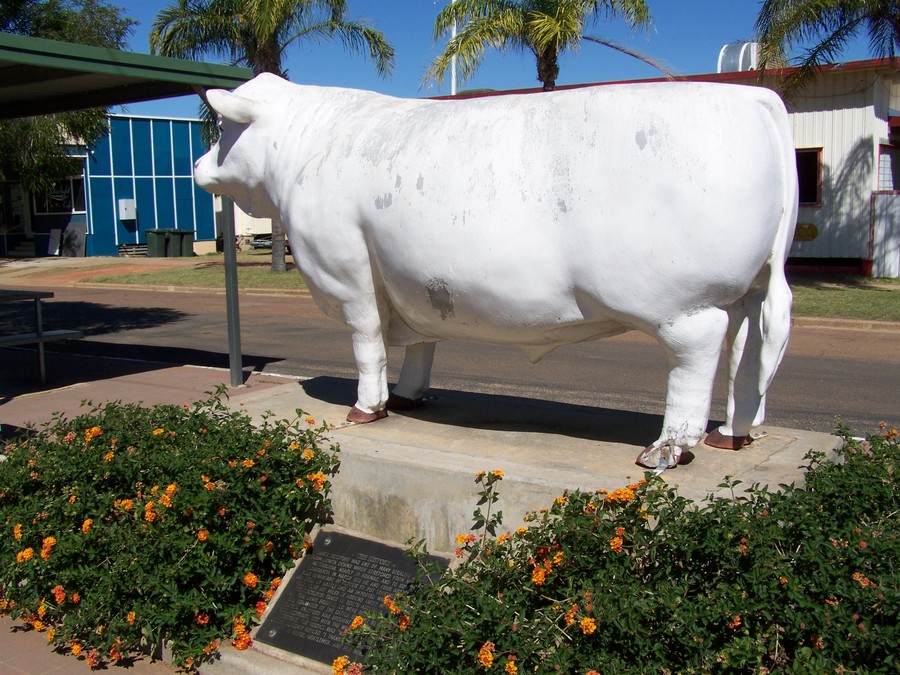
Aramac, Queensland
If not for the distinctive White Bull, stolen with 600 cattle from Bowen Downs station near Aramac – still a grazing town – by bushranger and bovine burglar Harry Readford, he might not have been tried after his otherwise historic cattle drive 800 miles south.
Even so, Harry was acquitted! Aramac was named in typical Aussie fashion for Robert Ramsay MacKenzie who carved his initials ‘R R Mac’ into a tree. Geddit?
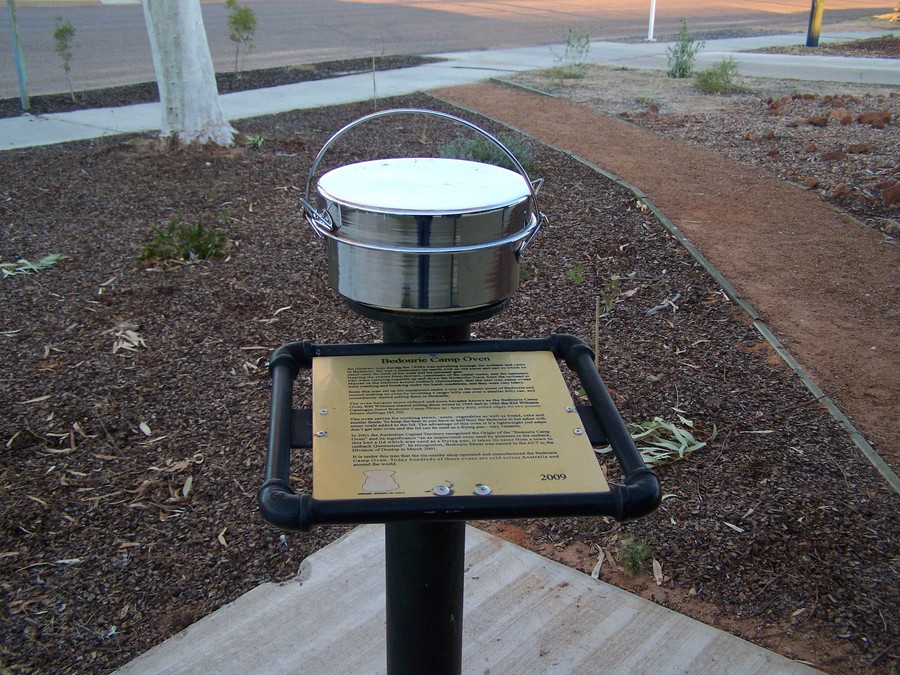
Bedourie, Queensland
It’s not just the awesome natural hot springs bathing pool right next to the campground or the bi-annual camel races. Bedourie – between Boulia with its pieces of Skylab and Birdsville with its iconic race meet – has its own unique piece of Australiana to boast about!
The Bedourie Oven – a clever contraption for cooking over campfire coals started here and took Australia by storm!
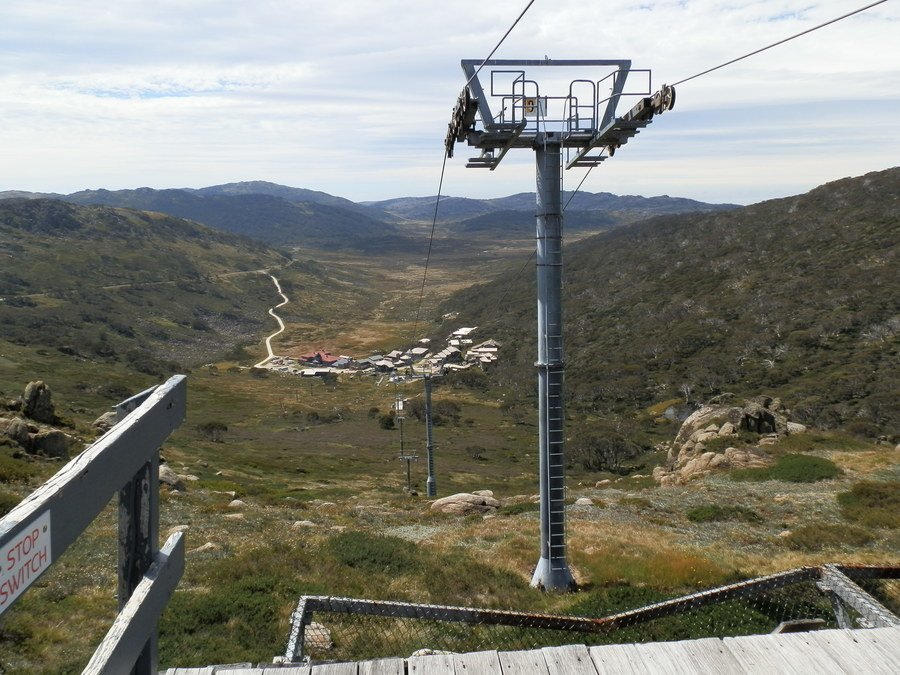
Charlotte Pass, New South Wales
Australia’s coldest temperature ever – minus 23 C – was recorded at Charlotte Pass, at 1765 m Australia’s highest permanent settlement, in the shadow of Mt Kosciuszko, which at 2228m is Australia’s highest mountain!
Just off the old road to the summit, Charlotte Pass is within walking distance of the top peak in OZ – how many other towns in the world can boast THAT?
Dadswells Bridge, Victoria
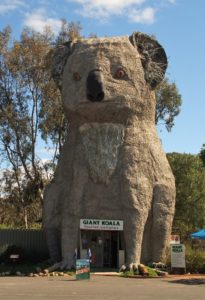
The tiny Victorian settlement of Dadswells Bridge, at the tip of the Southern Grampians, celebrates Australia’s favourite icon with a vengeance. Sam the BIG Koala had a facelift and make-up job since this dour photo was taken – now there’s a gift shop, tavern, ice-creamery, caravan park and a REAL Koala Zoo!
BUT … Big Sam’s concrete embrace gives ‘cuddle a koala’ a whole new meaning!
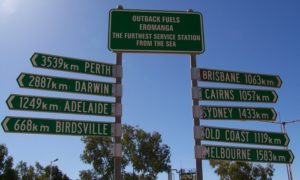
Eromanga, Queensland
It’s not Australia’s geographic centre, but via a complicated (and arguable!) calculation, Eromanga is furthest from the ocean – and ergo, so are the service station, pub, caravan park and so on!
The excellent museum (furthest from the sea) is just up the road from the opal-studded miners monument (furthest from the water) in the travellers rest stop (furthest from the coast).
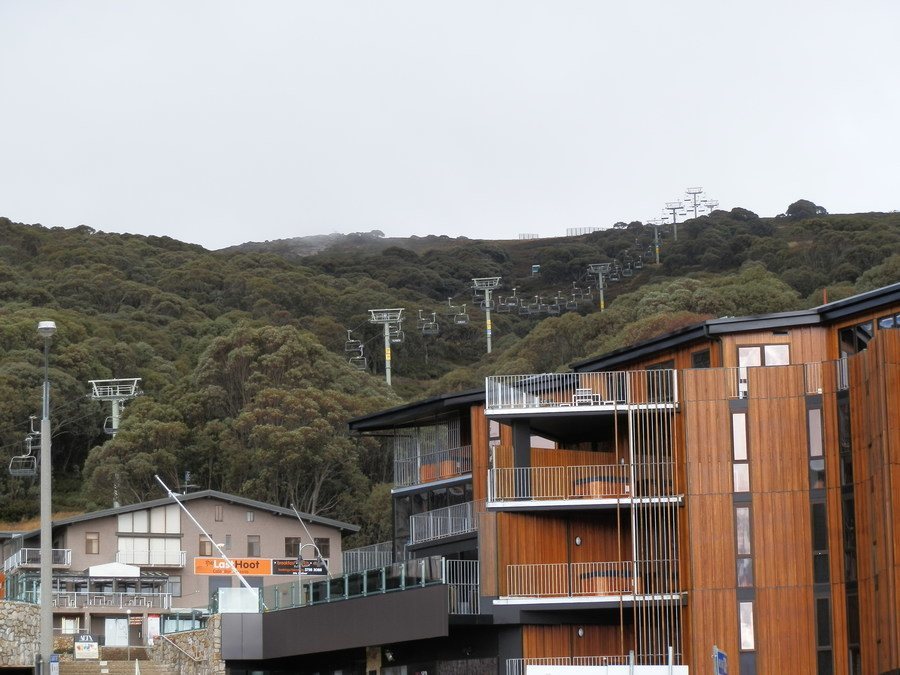
Falls Creek, Victoria
It’s not Australia’s highest town (see Charlotte Pass above) nor does it have Australia’s highest body of water (that’s Lake Cootapatamba near Mt Kosciuszko), but alpine ski resort Falls Creek is the next best thing.
Near Mt Bogong, highest mountain in Victoria, it’s also got Rocky Valley Lake, at 1600m Australia’s highest significant body of water – and one of its few lakes to be used for both winter and summer sports!

Gundagai, New South Wales
A funny thing happened on the Road to Gundagai, although details vary by account – but a statue of a dog who, some say, did something nasty in his master’s Tuckerbox could surely only happen in OZ!
Often referenced in Aussie folklore, Gundagai claims Australia’s oldest bakery (still operating – YESSSSS!) and a miniature Baroque Italian palace carved, ironically, by Frank Rusconi who also did the honours for the Dog-on-the-Tuckerbox statue’s base!
Humpty Doo, Northern Territory

Only 40 km from Darwin, this small town is home to the Adelaide River Floodplain and nearby Fogg Dam, both parts of a world renowned wetland system.
There’s also the BIG Boxing Crocodile, the well known Humpty Doo Hotel and a Reptile World with 300 kinds of snake! But wouldn’t you want to visit Humpty Doo just for its name?
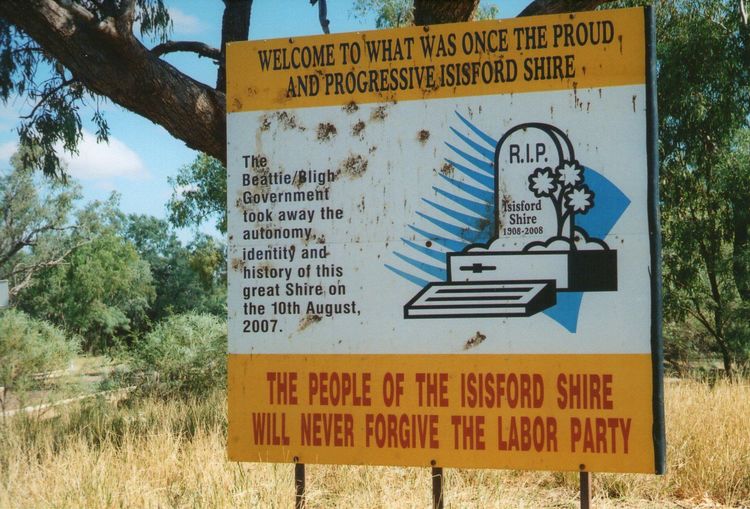
Isisford, Queensland
It’s no secret how Isisfordians feel about certain state government decisions – their sentiments are displayed on the town entrance sign.
But Isisford is better known for the the Mother of all Crocodiles – a fossil found on a nearby property that is ancestor to all modern crocs. You can decide which attraction is the most scary over a drink at the Clancy of the Overflow Pub!

Jerilderie, New South Wales
One of the more bizarre tributes to Aussie legend and outlaw Ned Kelly is a statue made of bread tins at (of course!) the Jerilderie Bakery.
Ned held up the Post Office and wrote his manifesto (known as the Jerilderie letter) here, but if you like your attractions a little less controversial, cross the road for Steel Wings – the only two windmills of their kind in the world!

Koolywurtie, South Australia
Raised on a Koolywurtie farm, Captain Harry Butler, a decorated World War 1 Ace pilot and aviator, made the first Southern Hemisphere over-water flight in 1919 across St Vincent’s gulf from Adelaide in his Bristol monoplane, the Red Devil.
Believed to be the only original plane of this type left in the world, the Red Devil is on permanent display in nearby Minlaton, where there’s also a mural, memorabilia and museum with information about his life.
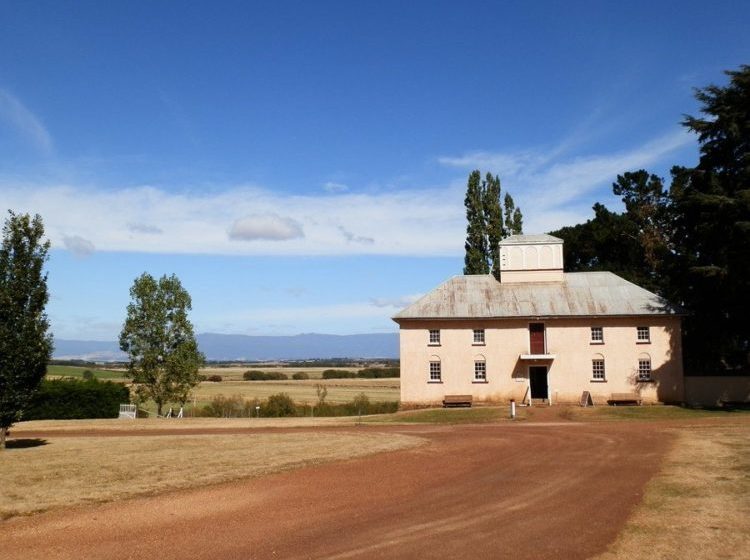
Longford, Tasmania
Two Australian Convict World Heritage listed sites jostling for position, and a town awash with fine examples of Georgian architecture puts Longford firmly on the heritage trail.
Built by free convict labour, Woolmers and Brickendon Estates offer a fascinating glimpse of Australia’s colonial history. But if all that history’s a bit much, chill out in the Woolmers Rose Garden, with 460 varieties!

Madura, Western Australia
Crossing Australia from West to East (or vice versa) via the Nullarbor takes WAY more than a day. Luckily, the small community of Madura, 1253 km (779 miles) east of Perth has everything travellers need.
As well as a range of accomodation, fuel, food and a swimming pool, Madura is home of the Walers – cavalry horses used by the British Army. And it’s also home of Brumby’s Run – Hole 9 of the Nullarbor Links Golf Course which, at 1365 km is longest in the WORLD!
And on that happy note, that’s the end of Part 1 of my Aussie ABC: T is for Tiny Aussie Towns with Terrific Tourist Attractions!

Have YOU got a favourite Australian country town? Tell all below!!
And if you want to start visiting Australia’s AWESOME country towns here’s the lowdown on cheap flights to get you started!
Want MORE?
- Australian Country Towns Part 2 N-Z
- List of Australian Country Towns (Wikipedia)
- MORE Photos of Australian Towns on Flickr
The post Aussie ABC: T is for Towns Part 1 appeared first on Australia by Red Nomad OZ.
]]>If you’ve ever decided against touring the Aussie Outback because you don’t have a 4WD, today is your lucky day. You CAN visit the Australian Outback in a standard, non-4WD car! Just follow these simple rules: Choose destinations that don’t require an especially equipped vehicle – there are more than you think! Know your vehicle’s limitations – consider fuel economy,[...]
The post Red’s TOP 10 Accessible Outback Experiences appeared first on Australia by Red Nomad OZ.
]]>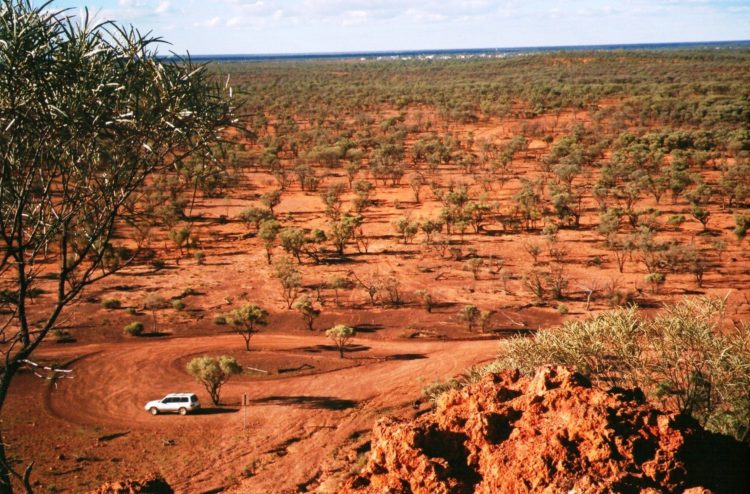
If you’ve ever decided against touring the Aussie Outback because you don’t have a 4WD, today is your lucky day.
You CAN visit the Australian Outback in a standard, non-4WD car! Just follow these simple rules:
- Choose destinations that don’t require an especially equipped vehicle – there are more than you think!
- Know your vehicle’s limitations – consider fuel economy, range, clearance, tyres, weight rating, space – in relation to where you want to go.
- Outsource the driving (eg take a tour, hitch a ride) when conditions don’t suit.
- Check all road, weather and travelling conditions in advance – rain, road works, flooding etc can all cause road closures.
- Take the advice you receive – be prepared to change your plans if conditions are not suitable for your vehicle. Having a Plan B always helps!
- Get road assistance (eg NRMA, RAA, RACQ etc), but be aware of any exclusions – sometimes road assistance to remote areas isn’t available.
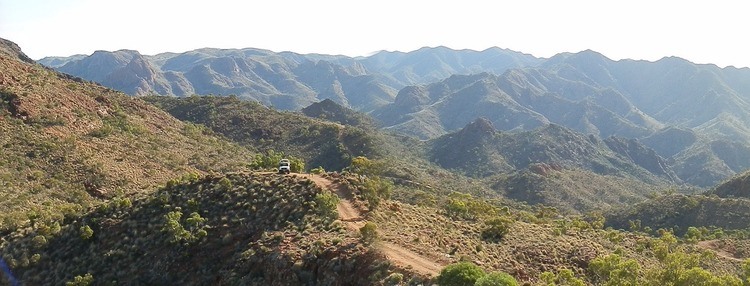
Pilchard and I have travelled to all the RedzAustralia TOP 10 Accessible Outback HOT Spots below in either a Subaru** Touring Wagon, a Subaru Forester or a Subaru Outback. Sometimes we’ve even had a NON-off-road camper trailer in tow. We’re not foolhardy risk-takers – we just follow those rules.
But if we can have these 10 Accessible Outback Experiences without extreme 4 wheel driving, then so can you!

1 Whale Watching
Head of Bight, South Australia
Stand atop the Bunda Cliffs – longest unbroken line of sea cliffs in the world – and watch the whales cavorting below! Yes, you’re in the Outback – and this section of the all-bitumen Eyre Highway separating Ceduna from Norseman, ~1200 km west, is Outback all the way.
Crossing the Nullarbor Plain en route from Sydney and Perth, around ~ 4000 km, is one of Australia’s great road trips. Full of life changing experiences – think driving Australia’s longest straight stretch of road; golfing on the world’s longest golf course; and unravelling the mystery of the Nullarbor Nymph (take links below for details) – it’s a TOP Outback experience in itself, even without the whales.
Where: Head of Bight Whale Watching centre is just off the Eyre Highway, ~220 km east of Eucla on the WA/SA border
When: Whale season is from June to October
Stay: Nullarbor Roadhouse, 26 km from Head of Bight Whale Watching area
MORE about Head of Bight and the Nullarbor Plain
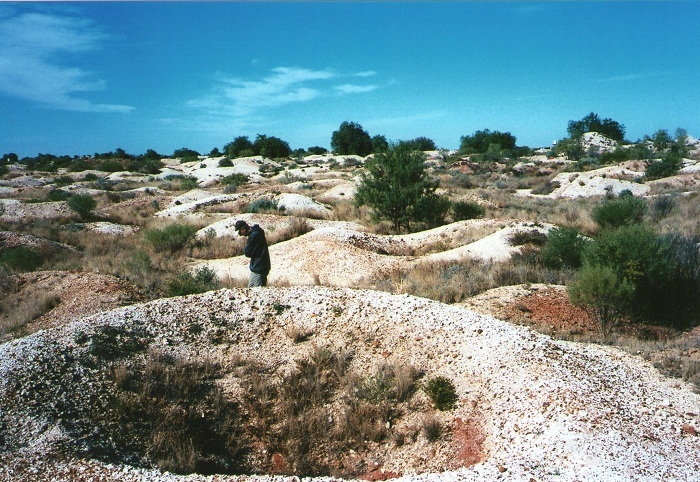
2 Opal Fossicking
White Cliffs, New South Wales
The tiny opal mining town of White Cliffs is the only place in the world where unusual pineapple opals occur naturally. Despite spending a couple of afternoons on the mullock heaps, the only ‘colour’ (opal-speak for actual opal) we found was pretty, but worthless. Maybe you’ll have better luck? We certainly did when we gave the diggings away and ‘found’ some opal in the White Cliffs township, along with the world’s only above-ground mineshaft tour, a self-guided historic walk and unusual architecture shaped by harsh weather conditions and limited building materials.
If you’re car’s up to it, take the rugged, unsealed Wanaaring road for 33 km to the Paroo-Darling National Park and Peery Lake, at over 30 km long the largest overflow lake along the river.
Where: White Cliffs is 96 km north-west of Wilcannia, which is 195 km east of Broken Hill on fully sealed roads
MORE about White Cliffs
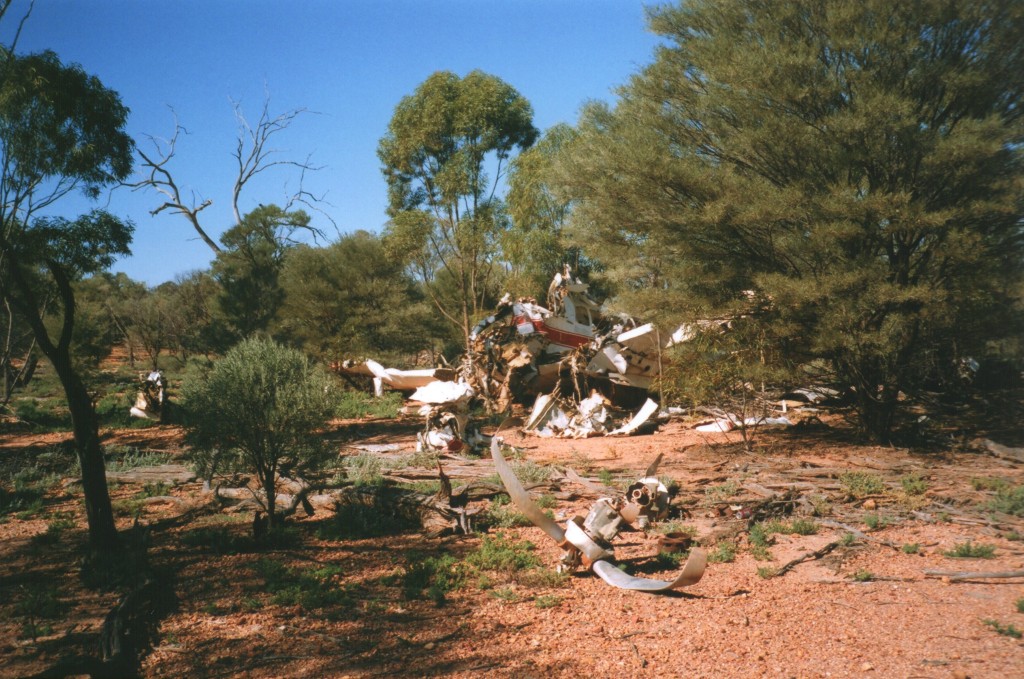
3 Mail Run
Quilpie, Queensland
It’d be difficult to drive yourself north over ~400 km of mostly dirt station tracks through magnificent outback scenery – it passes through 10 pastoral properties. But hitch a ride with the local postie to deliver the mail, catch up with some of the locals and see what’s outside the Quilpie city limits!
When you’re done with the Mail Run, climb nearby Baldy Top lookout (top photo) for a great view over this remote Boulder Opal mining town on the edge of nowhere. Explore west by driving 100 km to Eromanga, reportedly the furthest town from the ocean in Australia; fossick for opal at the caravan park’s ‘Deuces Wild’ lease; or drive 75 km south to Toompine for an Outback Pub experience.
Where: Quilpie is 211 km west of Charleville on the Cooper Developmental Road; and ~950 km west of Brisbane on the Warrego Highway, all sealed
MORE about Quilpie and Eromanga

4 The Gibb River Road
via Derby, Kimberley, Western Australia
There’s NO WAY that driving the 660 km of rugged, stony, tyre-shredding Gibb River Road (also known as the ‘Boys Own Adventure’ route) from Kununurra to Derby qualifies as an ‘Accessible Outback’ experience.
But the ‘Gibb River Road LITE’ version does!
Outsource the driving and hit the notorious road on a 4WD bus (it’s a school bus in its spare time) from North-west Kimberley town Derby for a 360 km round trip on the Gibb River Road to Windjana Gorge and Tunnel Creek, then back again.
So sit back, enjoy morning tea and lunch en route to the main attractions, and save your car and/or rig for the bitumen.
Where: Windjana Gorge/Tunnel Creek Day Tour leaves from Derby, 220 km north-east of Broome, Western Australia
Road Conditions: Appalling! That’s why you’re letting someone else do the driving, remember??!!
MORE about the Gibb River Road and the Kimberley
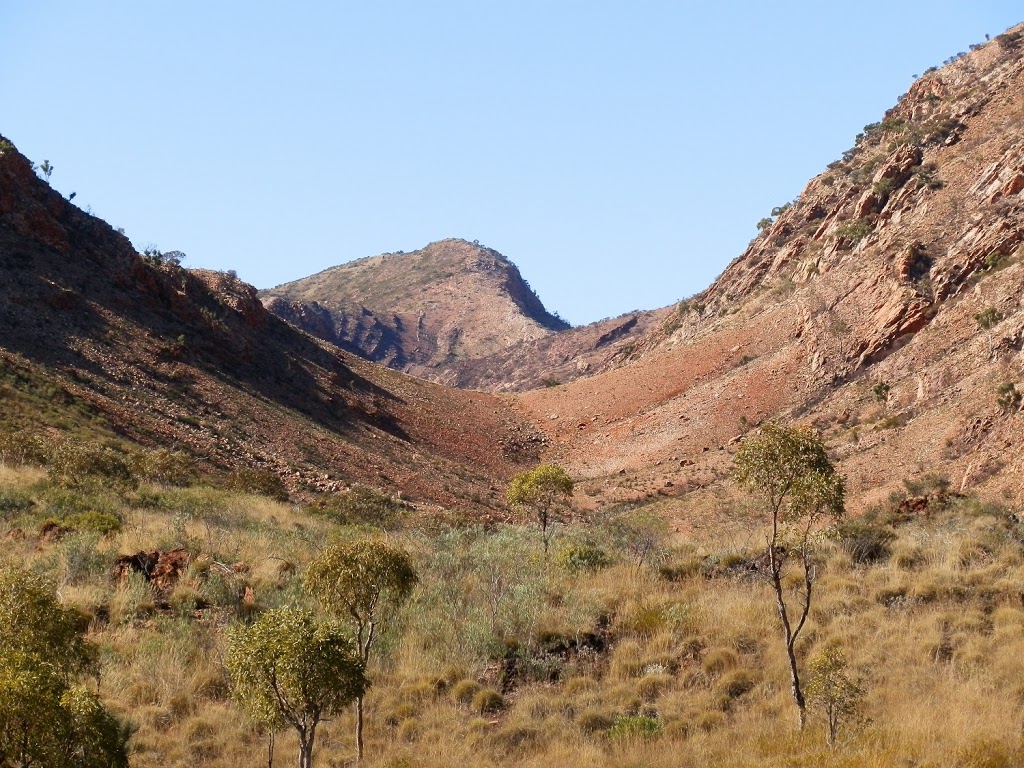
5 Hiking
Ormiston Gorge, Northern Territory
The amazingly varied and superb Outback scenery makes the 7 km Ormiston Gorge and Pound walk one of the best short-ish hikes in Australia (IMHO). But it helps that it’s superbly placed amidst the ancient rocky landscape of the West MacDonnell Ranges, traversed by the Finke River, oldest waterway in the world.
Ormiston Gorge is the smart alternative if you want to dodge the crowds at Uluru AND experience Outback magic with classic scenery, wildlife and a variety of walks. It’s SO good, a two-night stay turned into six nights!
Where: Ormiston Gorge is in the West MacDonnell Ranges, 128 km west of Alice Springs on a fully sealed road.
MORE about Ormiston Gorge
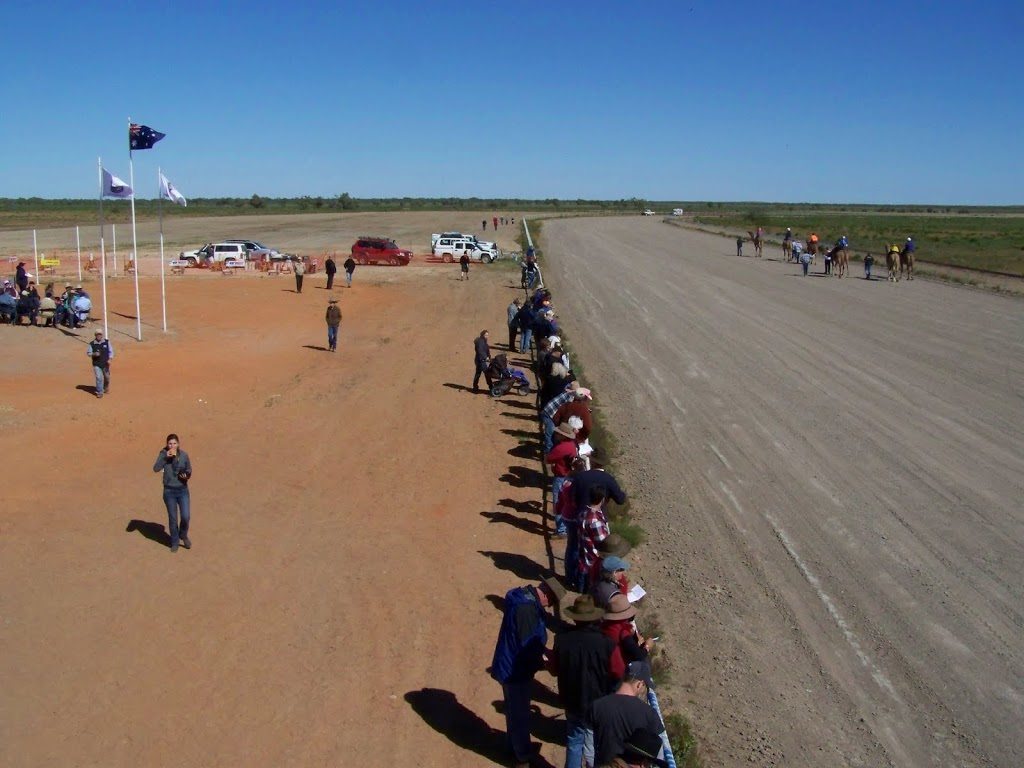
6 Camel Races
Bedourie, Queensland
Don’t expect to see horses at the Bedourie races – it’s camels all the way in the lead up to nearby Boulia’s camel race weekend. Join Bedourie locals for a TOP day out with racing, wood-chopping, good Aussie tucker, entertainment and an evening dance – to be held in 2016 on 9 July.
Home of the iconic Bedourie Oven, the town sits almost half-way between two other Western Queensland racing icons – Boulia, and the centre of Australia’s racing universe – Birdsville, with it’s world famous race meet held in September. Once the races are over, explore the area or just relax in the town’s Hot Artesian Pools!
Or stick around for the Boulia Camel Races – longest track in Australia; then move on to Winton for more races the following weekend.
Where: Bedourie is a 216 km drive – mostly sealed with about 14 km of dirt – south of Boulia; or 164 km north of Birdsville – mostly dirt.
When: Bedourie Camel Races 2018 Dates TBA, but usually the weekend before the Boulia Camel Races; Boulia Camel Race Weekend on Friday 20th – Sunday 22nd July 2017 AND Winton Camel Races Dates TBA, but usually the weekend after the Boulia Camel Races.
MORE about Bedourie Camel Races
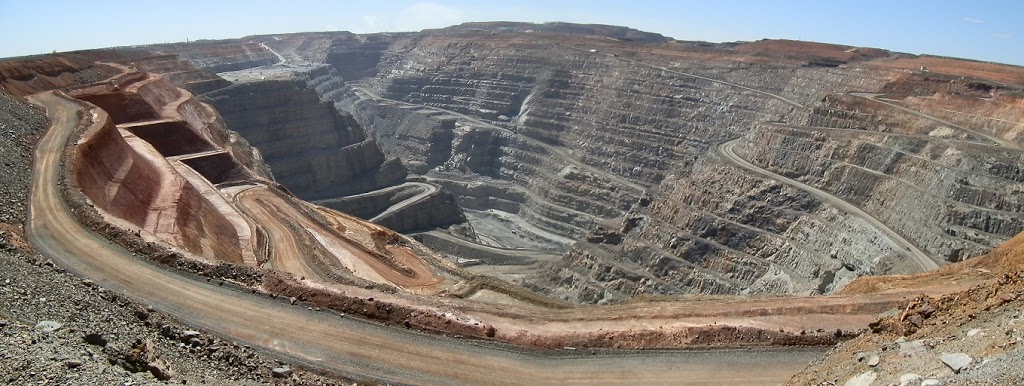
7 Unnatural Attractions
Kalgoorlie, Western Australia
Standing on the edge of a massive man-made crater stretching for nearly 4 km and waiting for a blast that’ll knock the sides out even further is like nothing else you’ll see in the Outback. A bold scheme (somewhat like its founder Alan Bond) the Super Pit combines leases and resources to more efficiently mine the Golden Mile – one of the richest seams of gold in the world.
A town able to survive because of an ambitious engineering feat piping water from the outskirts of Perth, nearly 600 km to the west, Kalgoorlie is a gold-mining town 24-7.
There’s nothing quite like the Outback’s natural attractions – but there’s something strangely compelling about this very unnatural one!
Where: 600 km east of Perth
MORE about Kalgoorlie-Boulder and the Super Pit
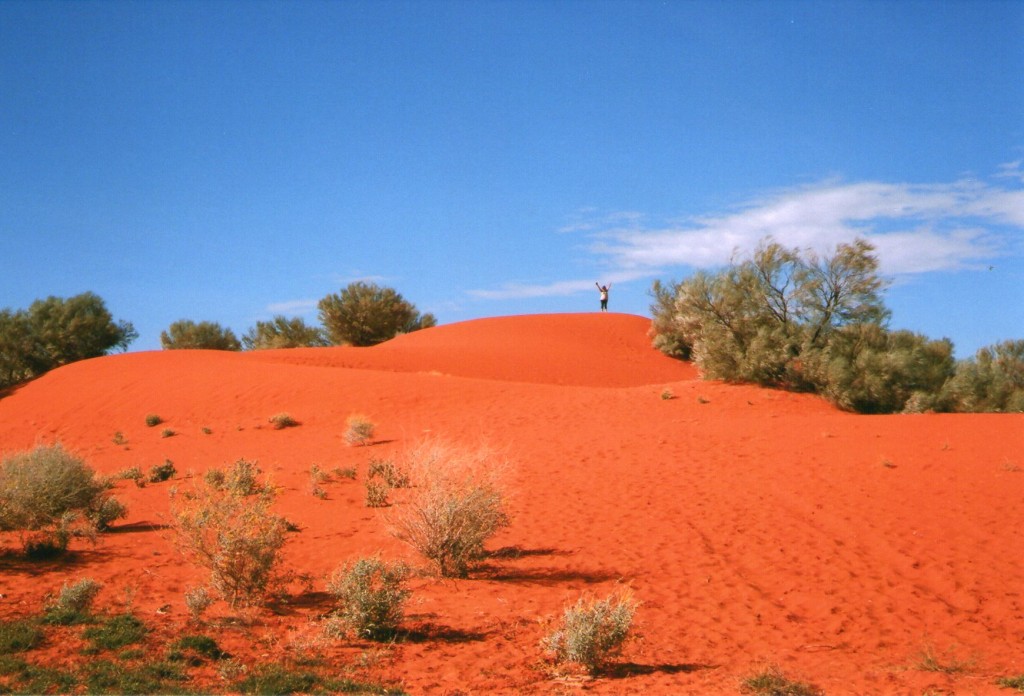
8 RED!
Windorah, Queensland
A number of localities vie for the honour of being the REDdest place in Australia. But for the reddest accessible outback HOT spot, there’s no contest.
Even with my old FILM camera, the red sand dunes west of Queensland Outback town Windorah are so startlingly vivid they almost hurt the eyes. Windorah has the added inducement of being closest town to Australian icon Cooper’s Creek – only place in the world where two rivers meet to form a creek. Then a little further west there’s the weirdly signposted ‘Point of Interest’, and a little further beyond that, The Little Loo at the end of the Universe – my most popular Scenic Public Toilet ever!
That’s all very nice. But it’s those RED sand dunes that get me every time!
Where: Windorah is 239 km north-west of Quilpie (see #3 above), along the Diamantina Developmental Road
MORE about Windorah and Cooper’s Creek

9 Wildlife Watching
Marlgu Billabong, Kimberley, Western Australia
As the crocodiles zig-zagged through the otherwise tranquil waters of Marlgu Billabong, centrepiece of the Parry Lagoons Nature reserve, the 65 species of birds we saw over two visits seemed unperturbed. Maybe the crocs were after bigger prey? That’s why we stayed firmly behind the barriers of the viewing platform over this magnificent inland billabong and breeding ground that attracts thousands of birds.
And bird-watchers!!
Only a few kilometres from East Kimberley Town Wyndham, the lagoon is a dramatically beautiful dry-season oasis against the stark colours and boab-tree-studded landscape that surrounds it.
Where: Marlgu Billabong is ~15 km on a dirt road from Wyndham. Wyndham is ~100 km north-west of Kununurra on a fully sealed road.
MORE about Marlgu Billabong
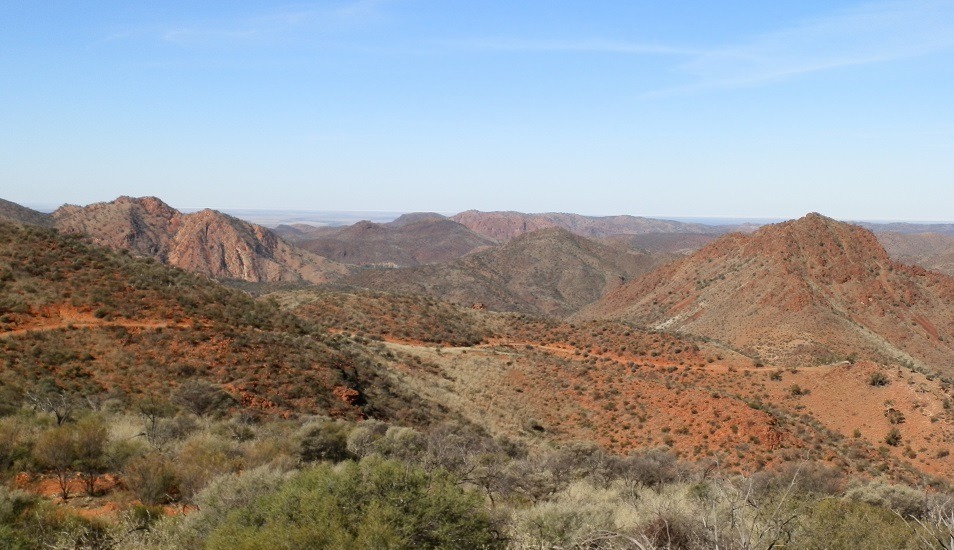
10 Ridge Top Tour
Arkaroola Wilderness Sanctuary, South Australia
Experience extreme Outback Adventure on a bone-shaking 4 hour return trip through the (almost) trackless adventureland of Arkaroola Wilderness Sanctuary to Sillers Lookout. Even though you won’t be driving yourself on this tour, it’s full of heart-stopping action on steep tracks with vertigo-inducing drop-offs and staggering scenery from several vantage points that show off northern South Australia to supreme advantage.
Australia’s premier eco-tourism destination (IMHO), Arkaroola is set amidst a fantastic landscape with an extraordinary array of rocks and minerals, superb natural attractions, amazing self-drive exploratory tours (mostly 4WD only), rugged hikes and an observatory for star-gazing.
The Ridge-top tour is conducted by Arkaroola Wilderness Sanctuary and for my money, it’s the ultimate Aussie Outback experience of all time. And I’m happy for any other tour operators to prove me wrong!
Where: Arkaroola Wilderness Sanctuary is 125 km north-east from Copley on an all-weather dirt road. Copley is ~600 km north of Adelaide on a fully sealed road – and if the weather prevents you from getting out to Arkaroola, Copley makes a fine alternative destination
MORE about Arkaroola Wilderness Sanctuary and Copley
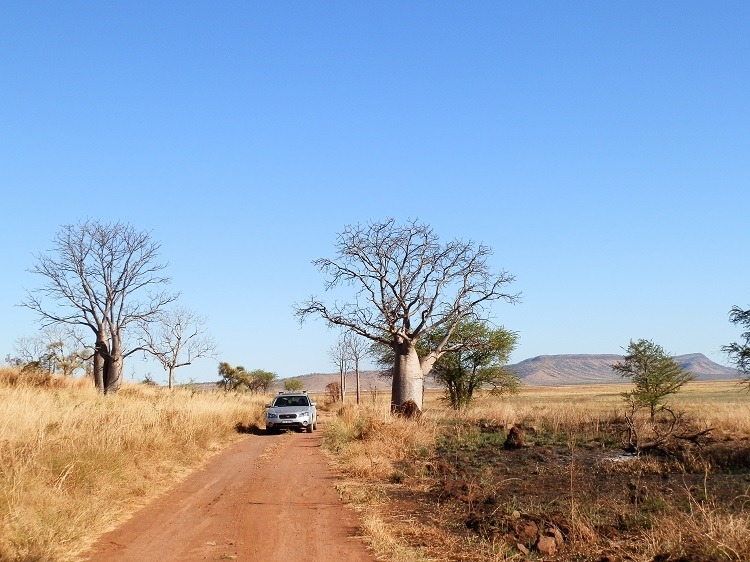
WARNING:
This post is an introduction to guide you to some of the more accessible Outback Experiences.
ANY trip to the Outback, no matter how easy it appears, MUST be carefully planned. Please visit websites like Travel Outback Australia, Outback Australia Travel Guide or Outback Travel Australia for advice and to ensure you are well-prepared, and carry extra water and supplies at all times.
Why? Because you’ll be faced with:
- Long distances
- Extreme temperatures
- Minimal facilities
- Limited services, including mobile phone access
- Harsh conditions
* IMHO = In My Humble Opinion
** Please note: These models of Subaru generally have slightly higher clearance than a standard car, and can be switched to 4WD mode if required.

LIKE it? SHARE it!
The post Red’s TOP 10 Accessible Outback Experiences appeared first on Australia by Red Nomad OZ.
]]>With the world’s biggest rock AND largest monolith*, Australia’s the land of the ultimate ROCK – or at least the coolest Australian rock formations! But where’s a keen rockhound to go once they’ve seen Mt Augustus (biggest rock) and Uluru (biggest monolith)?? Check out a few more Australian Rock Stars – otherwise known as distinctive and unusual Australian rock formations – with[...]
The post Aussie ABC: R is for Rocks appeared first on Australia by Red Nomad OZ.
]]>
With the world’s biggest rock AND largest monolith*, Australia’s the land of the ultimate ROCK – or at least the coolest Australian rock formations! But where’s a keen rockhound to go once they’ve seen Mt Augustus (biggest rock) and Uluru (biggest monolith)??
Check out a few more Australian Rock Stars – otherwise known as distinctive and unusual Australian rock formations – with this handy guide to 12 HOTTEST Rock spots from all around OZ!
1 Bald Rock via Tenterfield, NSW
This 750m x 500m monolith around 25 north of Tenterfield in New South Wales’ Granite Belt isn’t Australia’s largest monolith. But it’s Australia’s largest GRANITE monolith!!

Thrill seekers and the time-poor can take the short, steep exposed route straight up the face to the summit – 200 metres above the surrounding plains. Those wanting a more relaxing experience (read: more cowardly) can take the longer, more scenic route through the bushland up the back. Either way, the exposed summit has spectacular views over two states – and a spectacular drop down to the bottom!
MORE about Bald Rock National Park
2 Remarkable Rocks, Kangaroo Island, SA
The remarkable shapes of these rocks sculptured by wind, water and weather at the southern end of Flinders Chase National Park on Kangaroo Island off the South Australian coast are a real clue to what their ultra-imaginative name actually means 

Australia’s 3rd largest island – an intriguing blend of superb natural attractions, wildlife, gourmet treats and beaches – is South Australia’s answer to the tropics.
But whatever their reasons for visiting Kangaroo Island, sooner or later, most visitors head for the all-natural Remarkable Rocks – where they’ll take a photo remarkably like the one above!
MORE about Flinders Chase National Park, Kangaroo Island
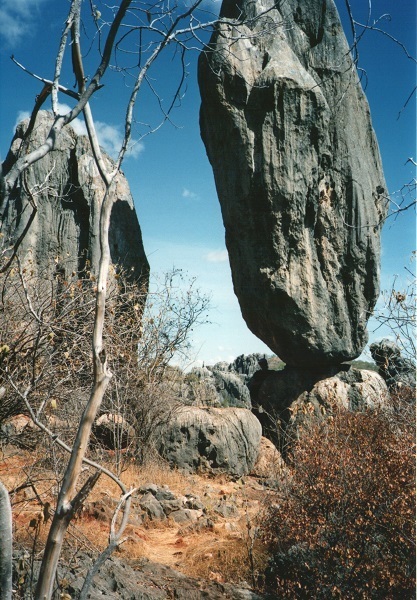
3 Balancing Rock & Caves – Chillagoe, QLD
I’ve still got the cool Serpentine (I think) egg I bought from a Chillagoe shop on my only visit 20+ years ago, but it’s Balancing Rock and the Chillagoe-Mungana Caves National Park tour I remember.
Outside, the dramatic jagged edges of the reef housing the caves tower above the classic outback landscape.
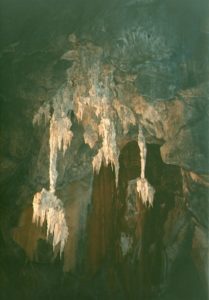
It’s just as dramatic inside – a separate, subterranean world of limestone in intriguing formations, weathered caverns and towering columns.
Back outside and the self-guided walks to the historic smelter sites, Aboriginal rock art are interesting, but it’s the amazing Balancing Rock that’ll get you snapping!
MORE about Chillagoe-Mungana Caves National Park
4 Tessellated Pavement, Tasmania
I’m such a sucker for names that when I heard about an attraction in a place called Pirates Bay near the township of Eaglehawk Neck on the Tasman Peninsula, it didn’t matter what it was. I just HAD to go see Tasmania’s Tessellated Pavement – one of the best known examples*** of this complex geological phenomenon involving rock fractures, polygonal blocks, erosion and sea salts. If you’re not a geologist, this is probably enough information. If you ARE a geologist, then you’ll already know WAY more than this!
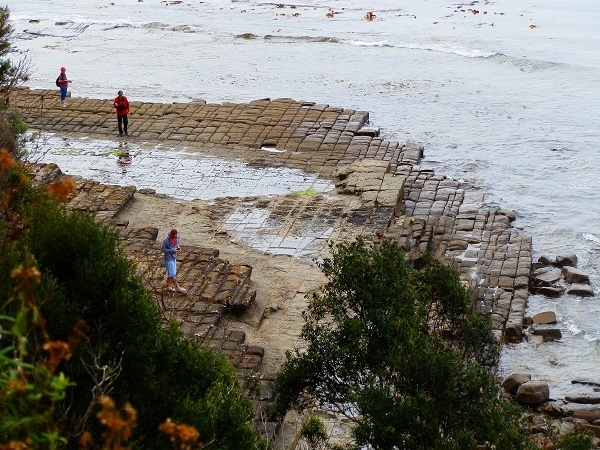
At low tide, the tessellations (like mosaic tiles) make an interesting patchwork on the flat rock platform just above the water level. But make sure your cool pavement shot isn’t ruined by slipping on the wet rocks!
MORE about the Tessellated Pavement
5 Mirima National Park, Kununurra

Tiny Mirima National Park on the outskirts of Kimberley town Kununurra, with its wildlife, walks and wheelchair access, is a chance to experience the MUCH bigger West OZ attraction Purnululu (aka Bungle Bungles) in miniature.
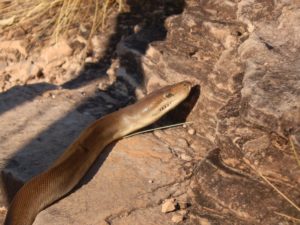
Formed by the same process as its larger counterpart, Mirima’s sedimentary rock layers glow in the early morning and late evening light. And with the right angle of perspective and the right level of concentration, a more skilled photograper than I could ALMOST convince viewers that the shots were taken elsewhere!
But I had no time for photographic trickery – I was more interested in avoiding the 3 metre snake!
MORE about Mirima National Park
6 Devils Marbles, Northern Territory
Snapping a killer sunset or sunrise in what is arguably Australia’s most intriguing rock pile without other people in your shot can be a challenge!
But the complicated geological theory involving weathered layers of sandstone and granite that’s the standard scientific explanation for the almost perfectly spherical shapes doesn’t quite do justice to the magical setting and extraordinary light.
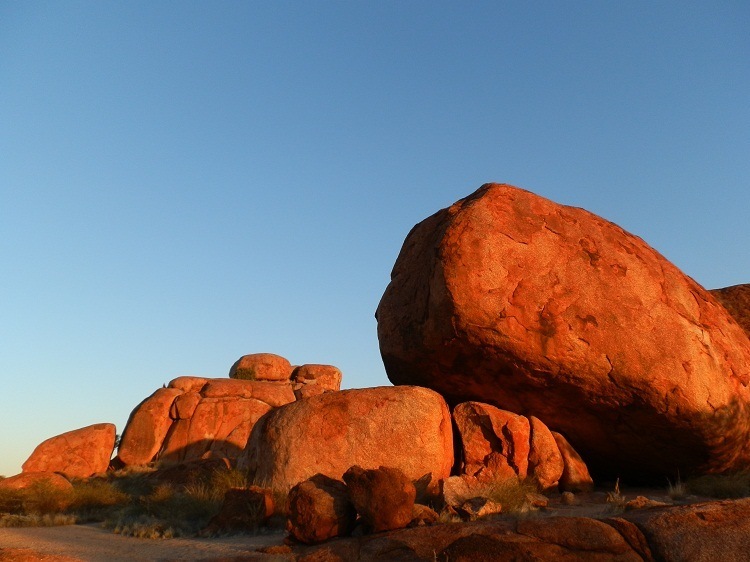
So forget the ‘facts’, settle back, and drink in the magic of Karlu Karlu with the story of the Rainbow Serpent. According to this Indigenous legend, those spherical shapes are the Rainbow Serpent’s fossilized eggs!
Now … isn’t that a FAR more satisfying explanation for this geological phenomenon?
MORE about Devils Marbles (Karlu Karlu)
7 Island Rock, via Kalbarri, WA
According to the tourist information brochure, Island Rock, one of the more spectacular of Kalbarri National Park’s Coastal Cliff attractions, ‘can be enjoyed from the safety of the lookout enclosures’!

But it doesn’t explain how safely walk the coastal trail atop the sandstone cliffs so high above the pounding sea below it’s almost impossible to fit them into a photo! Perhaps that’s why many tourists opt for a visit to the park’s best known rock formation, Natures Window!!
If you can tear your eyes away from Island Rock and the amazing sculpted cliff face, so treacherous to ships and bumblefooted tourists, you may be lucky enough to see whales far out to sea. But if the sheer drop gives you vertigo, turn and face inland – and you’ll see one of Australia’s most scenic loos**!
MORE about Kalbarri National Park
8 Sawn Rocks, via Narrabri, NSW
It’s an easy walk from the car park to the dramatic Sawn Rocks – Australia’s best example of the columnar jointing phenomenon more commonly called organ piping located a few kilometres from Narrabri in the shadow of Mt Kaputar National Park. Best viewed in the morning when the sun (if it’s out!) strikes the rock face, bringing out the amazing colours and shadows.

Standing underneath the soaring rock face can be awe-inspiring – until you realise that those enormous Greek temple ruinous rock columns all around can only have come from one place.
Yep, directly above!
MORE about Sawn Rocks, via Narrabri, NSW
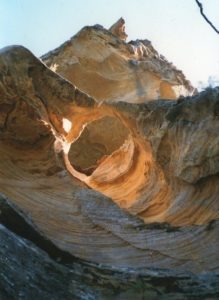
9 Hollow Mountain, Victoria
You can’t swing a brush-tailed possum in Victoria’s Grampians National Park without hitting some kind of rock. So much so that walking through the park could give you a serious case of rock overload that only a fix from the awesome Halls Gap Bakery could cure 
But I’m betting even the most jaded rockhound couldn’t fail to be impressed by Hollow Mountain, in the Northern Grampians. Exploring the wind-sculpted caves, caverns and crags can actually be more fun than reaching the summit!
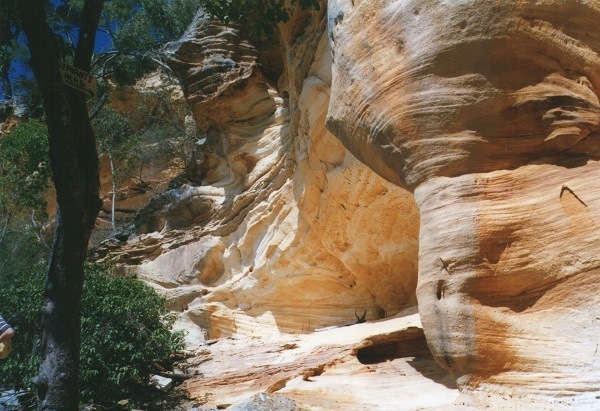
And I’m not just saying that because I’m exercise-averse! No, REALLY!!
MORE about Hollow Mountain and Northern Grampians
10 Balls Pyramid – via Lord Howe Island, NSW
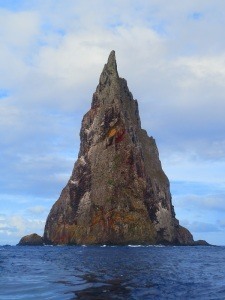
For pure rock star awesomeness, there’s not much to beat the 552m high spire of the world’s largest volcanic rock stack, out in the middle of the ocean and one of the only points of the mostly submerged continent of Zealandia still above sea level.
It’s an achievement to even get there. A 700+ km flight from Sydney to Lord Howe Island in a small plane that, depending on wind and weather conditions, may or may not be able to land. Then a 23 km boat journey that, depending on wind and weather conditions, may or may not actually depart as scheduled.
Once you’re on the boat, it’s easy. Unless you suffer from seasickness, in which case the hardest part of the trip is NOW!
MORE about Balls Pyramid, via Lord Howe Island
11 Bunda Cliffs, South Australia
Is it possible to have TOO much limestone??
If you’re not sure, head down south and drive the Nullarbor Plain skirting the Great Australian Bight. There’s nothing much between the road on the southern edge of Australia and Antarctica – except the majestic Bunda cliffs, ranging from 60 – 120 metres high and stretching for ~100 km.
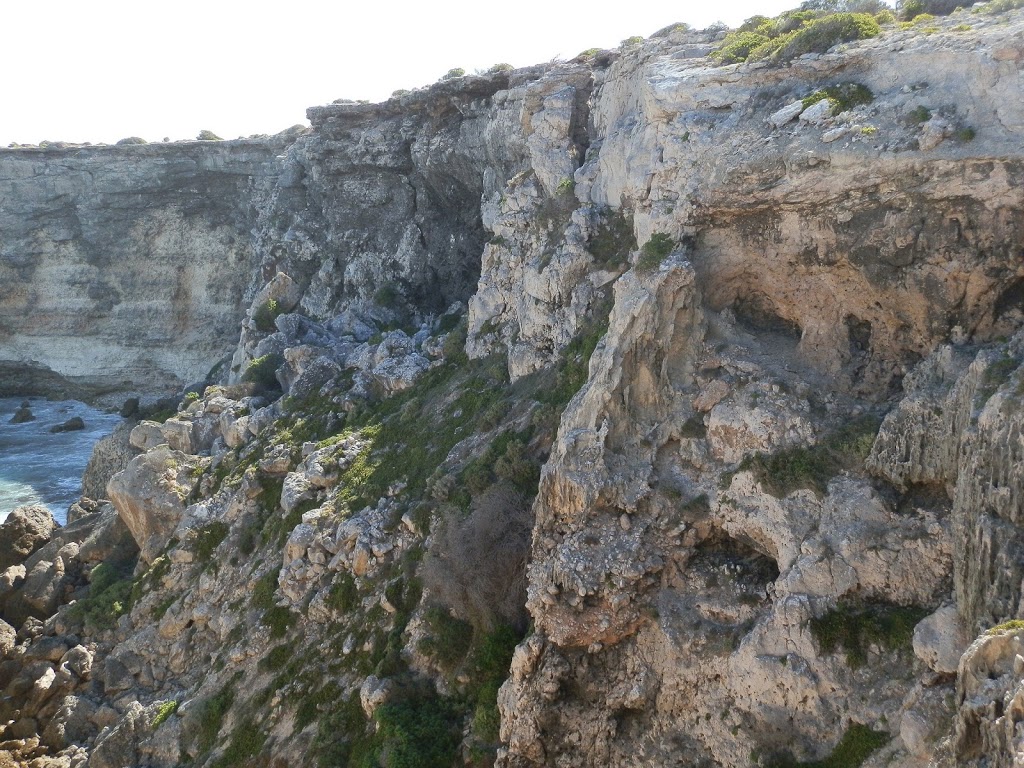
That makes them the longest unbroken line of sea cliffs in the WORLD!
If that’s not quite enough limestone for you, then factor in the 270,000 km² of the Nullarbor Plain itself – World’s largest limestone karst formation!
MORE about the Bunda Cliffs and Nullarbor Plain
12 Mount Moffatt, Carnarvon National Park, Queensland
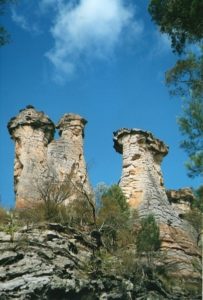
Mount Moffatt, 220 km north of Mitchell, part of the Carnarvon National Park and containing Queensland’s highest plateau (the Consuelo Tableland) is worth the long drive – and the flat tyre we got the instant we drove into the park many years ago!
Its remoteness made it the ideal hideout for the bushrangers, including the violent Kenniff brothers and notorious cattle duffer Harry Redford (sometimes known as Captain Starlight), who operated in the area. And the local Bidjara people, who refused to be ousted from their land, left a legacy of rock imagery throughout the park.
But it’s the sandstone formations we came to see – an awesome array of arches, ‘chimneys’ and monoliths scattered decoratively around the park. There’s no doubt about it – these rocks ROCK!
MORE about Mt Moffatt, Carnarvon National Park
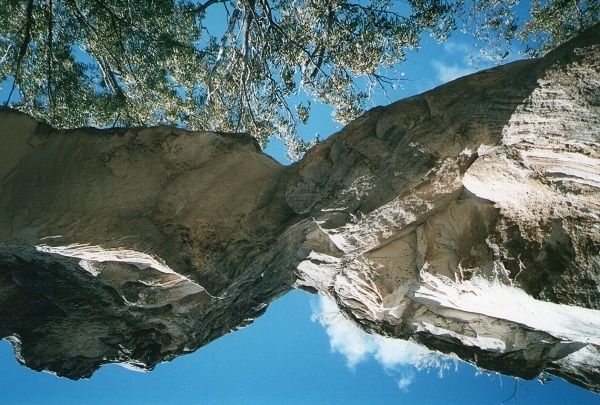
That’s just a sample – and I bet I’ve missed YOUR favourite HOT Australian Rock Formations! Tell me below!!
Want even MORE?
- My Aussie Alphabet so far: Aussie ABC A-Q
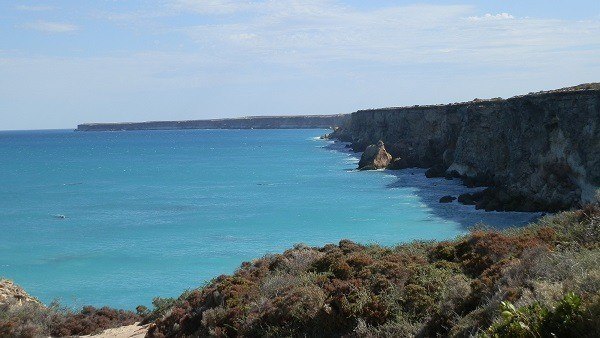
* According to www.answers.com HERE
** Yes, it’s in my book HERE
*** According to Wikipedia HERE
The post Aussie ABC: R is for Rocks appeared first on Australia by Red Nomad OZ.
]]>Australian Opal I didn’t understand all the fuss about SiO2.nH2O until 2004. That’s when I first visited Coober Pedy. It’s slap bang in the middle of absolutely freakin’ nowhere in the South Australian Outback. And it’s where I first found a piece of SiO2.nH2O I wanted to take home with me. You might know SiO2.nH2O better as Hydrous Silica. Or[...]
The post Aussie ABC: O is for Opal! appeared first on Australia by Red Nomad OZ.
]]>
Australian Opal
I didn’t understand all the fuss about SiO2.nH2O until 2004.
That’s when I first visited Coober Pedy. It’s slap bang in the middle of absolutely freakin’ nowhere in the South Australian Outback. And it’s where I first found a piece of SiO2.nH2O I wanted to take home with me.
You might know SiO2.nH2O better as Hydrous Silica. Or maybe Opal! Down here, diamonds AREN’T a girl’s best friend. 95% of the world’s opal is sourced from downunder, so Australia comes by its national gemstone honestly! Australian Opal Rules!
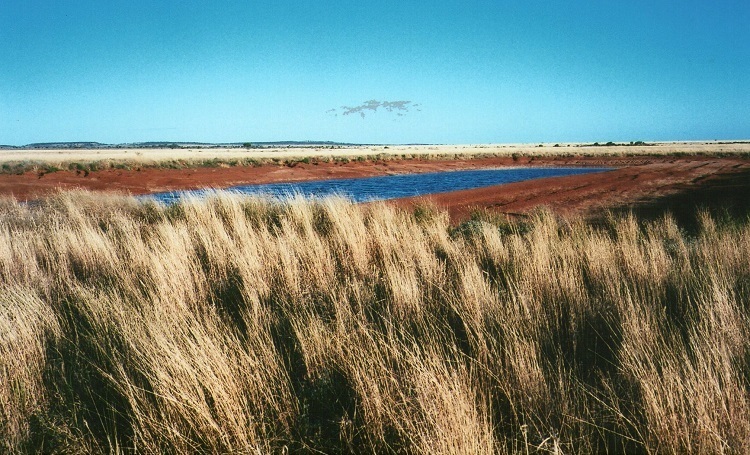
Back in Coober Pedy, there was only one thing standing between me and my Opal. A small matter of $AUD800+. A bit much for my wallet, even if it was already a tasteful ring that actually fitted me.
But then I had a scathingly brilliant idea! Why not find my OWN piece of opal and make my OWN jewellery? It couldn’t be THAT hard, could it?
So over the next few years I disregarded the legendary BAD luck attached to precious opal. My quest took me to five Aussie opal towns, also slap bang in the middle of nowhere. That’s because the ideal climatic and geological factors in which cryptocrystalline hydrous silica (yep, that’s yet another way of saying OPAL!) forms seem to occur in the harshest, most desolate and inhospitable land on earth.
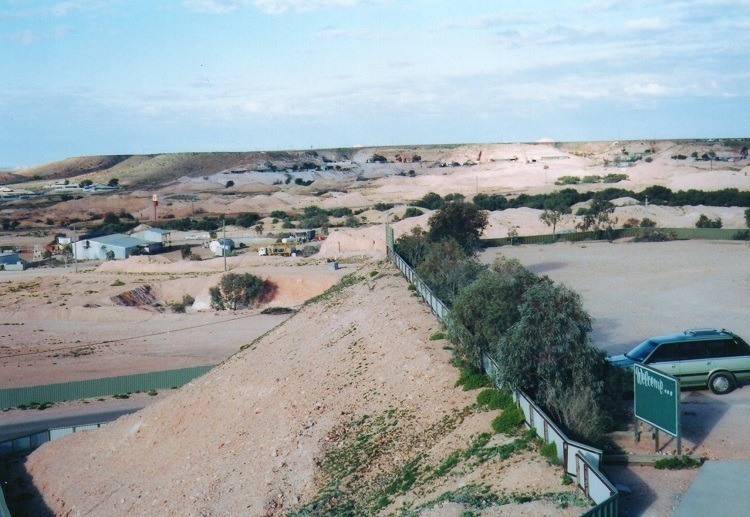
Where else but the Australian Outback!
Was my quest successful? Well … here’s a set of random adventures from each Australian Opal town!
1. Coober Pedy, SA – Australian Opal’s capital
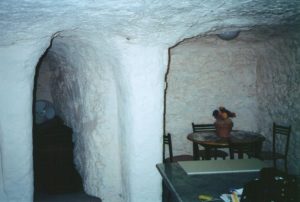
I awoke in perfect pitch blackness and waited for my eyes to adjust to the light.
They didn’t.
That’s what happens in a windowless room hewn from the solid rock under Coober Pedy in the middle of the night. But for the absence of shackles we could have been in a dungeon. Although the locals who’d built underground to beat the heat were probably used to it.
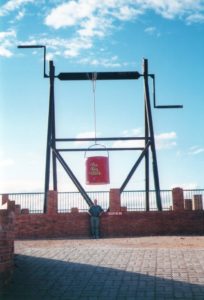
Meanwhile, the noise from above that had woken me – a pinging sound like pebbles on an iron roof – continued.
I put aside thoughts of poison pills, ventilator shafts and being buried alive. If anyone wanted to do me in, it’d be simpler to dump me in a disused mine-shaft!
Most of South Australia’s 80% contribution to the world opal market is mined in Coober Pedy. It’s a pock-marked paradise where the golf course (‘blacks’ instead of ‘greens’) enjoys reciprocal rights with St Andrews of Scotland.
This isolated town has what I believe to the world’s only underground campground. The Big Winch also has the distinction of being first place in the world where we successfully demonstrated a complete lack of opal-finding expertise.
And the noise?? Rain, of course!
2. Yowah, QLD – Australian Opal Exclusive
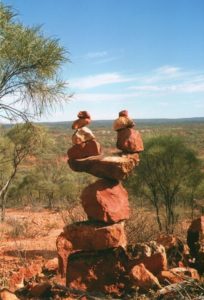
From our vantage point high above on the Bluff, the small town was almost lost in an endless sprawl of vegetation. It promised total disorientation if you left the main road in.
Below us was the only place in the world where Yowah Nuts – small rocky nuggets of opal – are found.
Stay in Yowah for a full-on Outback experience to go with your Yowah Nuts. This town is SO remote it’s visited by the Royal Flying Doctor Service. The only fuel in town at the caravan park is only available to their paying guests!
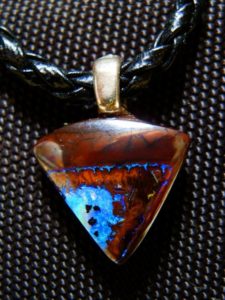
I didn’t expect to meet an ex-legionnaire, whose anecdotes about life in the Foreign Legion, including the true meaning of ‘decimate’, kept us entertained over lunch at the town’s only cafe!
After that, getting a fossickers license seemed a bit anti-climactic.
Luckily for inept unlucky opal-mining tragics like me, opal can be purchased locally.
SO … I was forced to descend into true tourist behaviour. After passing up several fiendishly expensive cuts, I bought my first ever piece of opal.
A multi-coloured shard of Yowah Nut cunningly carved into a pendant.
Although I have to stand right for the sun to illuminate its colours, at only $AU25, it’s a reminder of what awaits our return to Yowah.
3. Lightning Ridge, NSW
As we left the Lightning Ridge Visitor Information Centre, I was asked the dumbest question in living memory.
‘D’ya reckon we’ll like it here, love?’ the the most inebriated of a clutch of beer-swigging Grey Nomads asked. He drunkenly staggered against the door as he held it open for me.
Say what?

But Lightning Ridge is memorable for a whole lot of other reasons. We followed the ‘Car Door’ self drive tours to the Corcoran Opal fields – the richest stretch of black-opal-bearing soil on earth. We also saw enough quirky attractions to make us wonder exactly what was in the super-heated bore water bubbling up from the Great Artesian Basin way below into the hot baths full of tourists exhausted after a day in the diggings.

Quirky Lightning Ridge
Think Flying Combi, the Chambers of the Black Hand, the Black Queen Experience and Amigo’s Castle! AND it’s home of the self-proclaimed ONLY black-opal-mining Cactus Farmers in the WORLD!! Black opal requires a tonne of equipment to reach the depths at which it is found. So our short stay was spent exploring the place where legendary and prolific Aussie author, Ion Idriess worked and wrote ‘Lightning Ridge’ over 100 years ago.
Ironic, though, that any one of his books is now worth more than all the Australian opal Pilchard and I have EVER scavenged put together!!
Call me a coward, but I can’t face the overhang of a LOOONG ladder tilting backwards into oblivion with nothing between me and the bottom of the mine shaft. That’s why I did my ‘research’ on the surface while brave boy Pilchard went below for a mine tour.
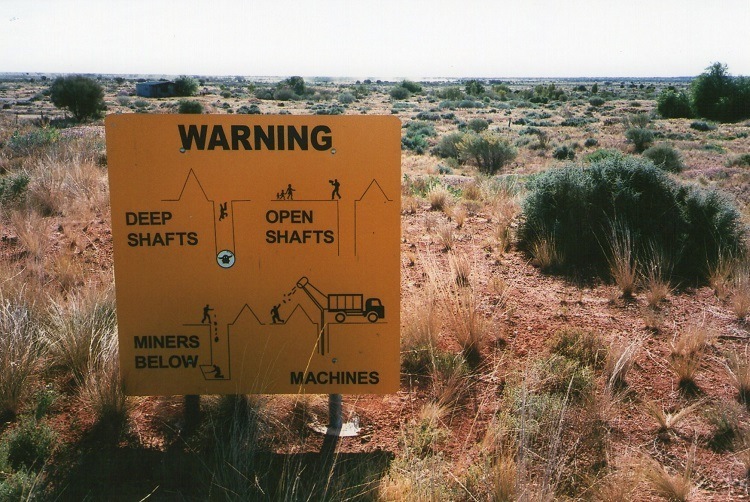
The good news is there’s almost as much opal on the surface these days. It’s hidden in the cast-offs surrounding the deserted mine-shafts scattered over the surface, if you don’t mind worthless smaller pieces! Tragically, the collection of ‘colour’ Pilchard and I found after a hard day digging won’t even make jewellery, let alone our fortune. But I finally got the thrill of the quest and why people keep coming back for more.

Besides, White Cliffs is the only place on earth with unique Australian Opal Pineapples!
As a special treat, the owners of the Red Earth Opal Showroom and Cafe who’d shown Pilchard through their mine, threw in an above-ground mine-shaft tour for free for me.
A real bargain considering it normally costs 50c!
And what’s NOT to love about the place I spent 7½ minutes in paradise?
5. Quilpie, QLD
A bakery run by a gun shearer who still holds the world record for the most sheep shorn in one day is one of many distractions from Quilpie’s main business of mining boulder opal. Hell, with its own HOT Artesian Bore baths and in-season entertainment, you don’t even have to leave the Caravan Park to find yourself a good time!
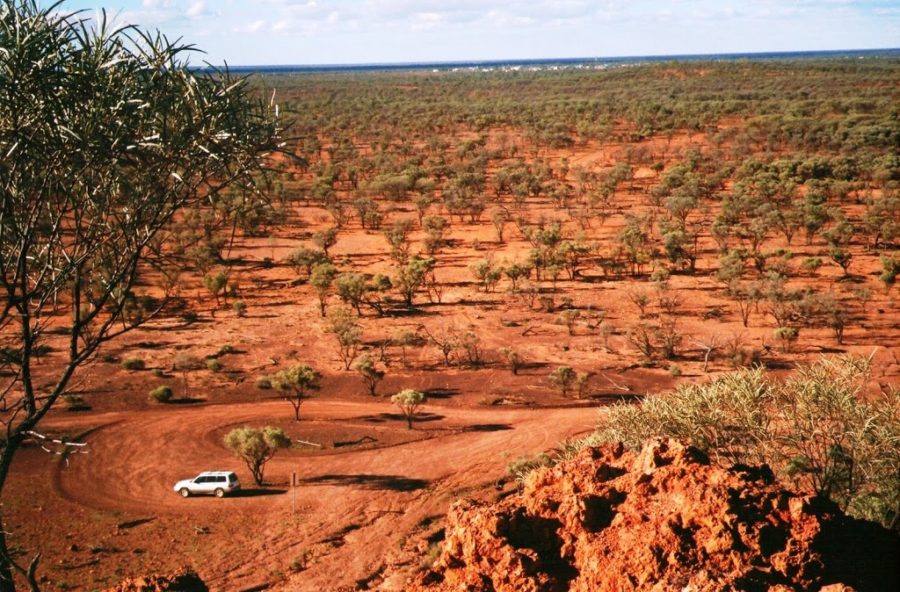
It’s also not far from Eromanga – arguably furthest spot from the ocean in any direction in Australia. With attractions like these, you could stay in Quilpie for a week without even thinking about Opal.
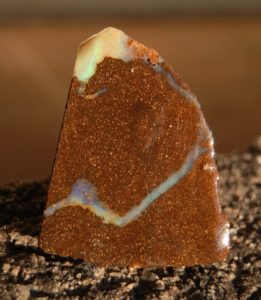
The ‘Deuces Wild’ Opal Mine is SO remote a rescue party is sent out (at your expense) if you’re not back by 5:00pm. The distraction of Bourkes Parrot, a lifer for twitcher Pilchard, was almost enough excitement without hunting for the elusive opal.
On the claim, our ever-growing opal-mining ‘expertise’ resulted in some seams of ‘colour’ running through the rock. But while they look nice in the sun, I’m not sure how they’ll become my Opal Ring …
The Quest for Australian Opal Continues
To date, the unkind could successfully argue my quest for my own piece of SiO2.nH2O jewelry has been a fools errand! But in the process, I’ve discovered an intriguing sub-culture out on the edge which I’m not yet done exploring.
SO … watch this space – and maybe next time I’ll hit the Australian Opal jackpot!
Want MORE?
- Opal according to Wikipedia
- Coober Pedy, South Australia
- Yowah, Queensland
- Lightning Ridge, New South Wales
- White Cliffs, New South Wales
- Quilpie, Queensland
- MORE Aussie ABC!
The post Aussie ABC: O is for Opal! appeared first on Australia by Red Nomad OZ.
]]>